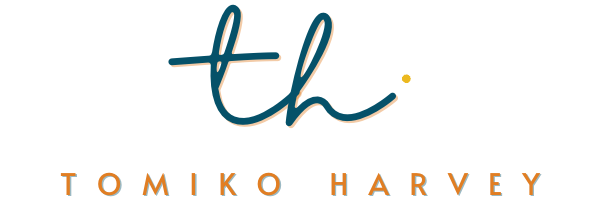

100 Comprehensive Travel Keywords During Your Keyword Research?

SEO is the biggest driver of organic traffic to your website. When you use the right keywords in your content, you can get greater online visibility.
Understanding the best Keyword for travel is essential in creating successful and effective travel blog posts.
Although the travel industry is a competitive space, with basic SEO knowledge and keyword research, you can set your website up to attract more visitors.
However, with so many other tasks involved in running a travel blog, finding the time for keyword research can be challenging.
This leads to the question: when should you do keyword research? This blog post will discuss the best timing for keyword research, how it can benefit your travel blog, and the best keywords for a travel blog.
So, if you’re a travel blogger looking to improve your SEO game, keep reading to learn more about the importance of keyword research for travel bloggers.
the Importance of having the best Travel Keywords
Keyword research plays a crucial role in the success of travel blogging. It is a vital tool for understanding what people are searching for in relation to your travel niche and allows you to create content that is not only informative and engaging but also optimized for search engines.
Incorporating relevant travel keywords into your blog posts increases the chances of your content being discovered, more organic traffic, and, ultimately, increased page views.
One of the critical benefits of keyword research for travel bloggers is the ability to tap into the mindset of your audience.
You can tailor your content to address their needs, preferences, and interests by understanding the specific search terms they are using.
This helps you to create more relevant and targeted blog posts that resonate with your readers, making them more likely to stay on your site, engage with your content, and even convert into loyal followers.
Another important aspect of travel keyword research is its impact on search engine optimization (SEO).
By incorporating keywords into your blog posts, you signal to Google what your content is about, helping them to index and rank your site more accurately.
This increases the likelihood of your blog appearing higher in Google search results (SERPs), making it more visible and driving organic traffic to your site.
Overall, keyword research is a fundamental aspect of travel blogging that should not be overlooked.
By dedicating time and effort to keyword research , you can ensure that your blog effectively reaches and engages with your intended audience, helping you grow your blog and achieve your blogging goals.

Optimal Times to Conduct Travel Keyword Research
To maximize the effectiveness of your keyword research for travel blogs, it’s essential to consider the optimal times to conduct keyword research.
While keyword research can be done at any time, specific periods can provide better results and help you stay ahead of the competition.
One of the best times to conduct keyword research is during the initial stages of planning your blog post.
By identifying relevant keywords early on, you can ensure that your future blog posts are strategically optimized from the start.
This allows you to align your content creation process with the keywords most likely to drive organic traffic to your site.
Another opportune time to research keywords for travel is when you’re brainstorming new blog post ideas.
By conducting keyword research during this phase, you can uncover popular search terms related to your travel niche and use them as inspiration for your content.
This ensures your blog posts are interesting, informative, and highly relevant to those Googling-specific travel keyphrases.
In addition, it’s beneficial to revisit and update your keyword research periodically.
Trends and search behaviors can change over time, so by regularly conducting keyword research, you can stay up-to-date with the latest keywords that resonate with your audience.
This will help you consistently optimize your blog content and maintain its visibility in search engine results.
By strategically timing your keyword research, you can ensure that your travel blog stays relevant, attracts more readers, and continues to grow in popularity.
Strategies to Effectively Implement Keywords for Travel
To effectively carry out keyword research for your travel blog, here are some strategies to consider:
1. Use keyword research tools
There are various keyword research tools available that can help you identify relevant and popular keywords for your travel niche.
These tools provide insights into search volume, competition, and related keywords, allowing you to make informed decisions about which keywords to target.
2. Analyze your competition
Take a look at what keywords your competitors are ranking for. This can give you valuable insights into which keywords are driving traffic to their blogs and help you identify any gaps or opportunities that you can capitalize on.
3. Focus on long-tail keywords
Long-tail keywords are longer, more specific keyword phrases that often have lower search volume but higher intent.
By targeting long-tail keywords, you can attract a more targeted audience and increase your chances of ranking higher in search engine results.
4. Consider user intent
When conducting keyword research, it’s important to consider the intent behind the search query. Are users looking for information, inspiration, or to book a trip?
By understanding the intent, you can tailor your content to meet their needs and increase the chances of converting them into readers or customers.
5. Monitor and track keyword performance
Once you have incorporated keywords into your blog posts, monitoring their performance is important.
Use analytics tools to track the organic traffic, engagement, and conversions generated by specific keywords.
This will help you identify which keywords are bringing the most value to your blog and make adjustments as needed.
By implementing these strategies, you can effectively carry out keyword research for your travel blog and improve its visibility, attract more readers, and achieve your blogging goals.
Remember, keyword research is an ongoing process, so it’s essential to regularly review and update your keywords to stay ahead of the competition.
- Use the target or main keyword within the first 100 words of your page.
- Don’t add an outgoing link with your keyword ad anchor text.
- Aim to use each keyword two times naturally.

Tips for Incorporating Keywords into Your Travel Blog Posts
In order to effectively incorporate keywords into your travel blog posts, consider the following tips:
1. Utilize keywords naturally
While it’s essential to include your chosen keywords throughout your content, it’s crucial to do so in a natural and organic way.
Avoid keyword stuffing or forcing keywords into your writing. Instead, focus on creating high-quality, informative content that naturally incorporates your keywords.
2. Include keywords in your title and headings
One of the most impactful places to include keywords is in your blog post titles and headings. This not only helps search engines understand the relevance of your content but also catches the attention of readers searching for specific terms.
3. Optimize your meta tags
Meta tags, including your meta title and meta description, play a significant role in search engine optimization. Incorporate your target keywords into these tags to improve your blog post’s visibility in search engine results.
4. Create unique and engaging content
While incorporating keywords is important, it’s equally crucial to create unique and engaging content that appeals to your audience.
Your blog posts should provide valuable information and insight into your travel niche, encouraging readers to stay on your site and explore more of your content.
5. Don’t forget about image optimization
Images can also contribute to your blog’s visibility in search engine results. Optimize your image alt text and file names with relevant keywords to increase the chances of your images being discovered.
How To Pinpoint Your Ideal Travel Keywords
When identifying travel keywords for your web content, there are three points to think about:
- Search Volume : The number of times users search a keyword in a month. The higher the search volume, the more web traffic you can get from the keyword.
- Difficulty : Generally speaking, keywords with a higher search volume and commercial intent are more challenging to rank for. And if you’re competing against loads of high-authority websites for a specific keyword, it will also be more challenging to rank for.
- Search inten t: When people enter keywords into the search bar, does the content in the results give them the information they are looking for? Offer the information that the person wants, and the keywords will bring you relevant traffic, not just a lot of traffic.
High-Volume Travel Keywords
Below you will find a list of some of the most popular keywords in the travel niche along with their global monthly search volume on Google.
If your website or business focuses on travel, these keywords can be helpful for content ideas and increasing your SEO presence.
Remember, keyword research is an ongoing process, so regularly revisit and update your keywords to stay ahead of the competition and ensure continued success.
Final Thoughts
While these are pretty general keywords, they do at least provide a base from which you can brainstorm ideas for your travel business.
Because travel is a hot topic online, the competition on the SERPs is pretty high. Taking a data-informed approach to optimizing your content will better position your website for ranking.
Remember, ranking content on search engines is not a quick fix and doesn’t happen overnight. So, it’s a good idea to include other types of marketing in your overall strategy to grow your travel business.
Learn how to do keyword research with Me
You’ve learned the basics about how to do keyword research, but if you’re looking to take your keyword research skills to the next level, I am here to help to schedule a SEO Strategy Call today
One Comment
- Pingback: Stay22 is the Best Hotel Affiliate Program for 2024!
Leave a Reply Cancel reply
Your email address will not be published. Required fields are marked *
Save my name, email, and website in this browser for the next time I comment.
We Cracked the Google Code to get a 700% Jump in Organic Traffic. Secrets Revealed in this Free Webinar
- Top Keywords
- Most Asked Questions
- Most Searched Words
- Top Business Books
- Write For Us

Get the top most searched Keywords in Google

The Most Searched Best Travel Keywords On Google
Best travel keywords.
The travel industry is highly competitive and businesses need to be able to attract visitors through search engine optimizing techniques and convert them into a potential lead. With the right combination of innovative technology, powerful storytelling and perfect search engine optimizing, a travel brand has the potential to rise to the top and get seen, heard, and booked.
To accomplish business growth, you will have to consider researching the best travel keywords that can suit your website. By using a keyword which has high search volume with low competition, there is a lot more chance that could help your website visible in the Google’s first page with the top ranking.
If we look at best travel keywords, we see that there is a hidden meaning behind each one. Every keyword has a specific intent. Google is trying to find out what the user means behind each keyword, what they want to accomplish.
When a prospective customer starts their search for the best travel company, they start searching in general terms. As they narrow down their search, however, they get more specific and closer to the final buying moment.
Tracking and monitoring “Best Travel” related keywords is easy and on this page, we bring to you an exhaustive list of top Best Travel keywords. We have leveraged the power of Mondovo’s Free Keyword Tool to get you this complete affiliate marketing keywords list.
A List Of Most Searched Best Travel Keywords
To get started, we present you the most searched, long tail best travel question keywords containing the term ‘Best Travel’ on Google, along with the Monthly Global Search Volume and CPC data. Besides being interesting, this best travel SEO keywords list will aid you in creating relevant content for your niche audience.
The Global Search Volume and CPC data are monthly averages calculated using the data collected over the last six months.
The Top Best Travel Keywords For SEO
Mondovo’s Keyword Research Tool has been designed not only to let users find keywords but to deliver key insights for each keyword so that users, like you, will be able to make sense of what you get and get things done with them.
If you liked this data on Affiliate Keywords, then you also might be interested in The Most Asked Questions on Google , The Most Searched Words on Google as well as the 100 Best Books to Read . For other Top Keywords Categories check the links below.
[contact-form-7 id=”1599″ title=”Mondovo.com – World’s 1000 Most Expensive Questions On Google”]
[contact-form-7 id=”1592″ title=”Mondovo.com – Most Expensive Google Keywords”]
[contact-form-7 id=”1531″ title=”Mondovo.com – Can Question Keywords”]
[contact-form-7 id=”1523″ title=”Mondovo.com – Which Question Keywords”]
[contact-form-7 id=”1516″ title=”Mondovo.com – Who Question Keywords”]
[contact-form-7 id=”1496″ title=”Mondovo.com – Why Question Keywords”]
[contact-form-7 id=”1486″ title=”Mondovo.com – What Question Keywords”]
[contact-form-7 id=”1481″ title=”Mondovo.com – When Question Keywords”]
[contact-form-7 id=”1476″ title=”Mondovo.com – Where Question Keywords”]
[contact-form-7 id=”1469″ title=”Mondovo.com – How Question Keywords”]
[contact-form-7 id=”1424″ title=”Mondovo.com – Government Trade Keywords & Question Keywords”]
[contact-form-7 id=”1419″ title=”Mondovo.com – Industrial Goods Keywords & Question Keywords”]
[contact-form-7 id=”1414″ title=”Mondovo.com – Web Hosting Keywords & Question Keywords”]
[contact-form-7 id=”1407″ title=”Mondovo.com – Virtual Server Hosting Keywords & Question Keywords”]
[contact-form-7 id=”1401″ title=”Mondovo.com – Shopping Cart Keywords & Question Keywords”]
[contact-form-7 id=”1397″ title=”Mondovo.com – Semiconductors Keywords & Question Keywords”]
[contact-form-7 id=”1392″ title=”Mondovo.com – Online Stores Keywords & Question Keywords”]
[contact-form-7 id=”1385″ title=”Mondovo.com – Online Payment Keywords & Question Keywords”]
[contact-form-7 id=”1380″ title=”Mondovo.com – Business Travel Keywords & Question Keywords”]
[contact-form-7 id=”1374″ title=”Mondovo.com – Home Based Business Keywords & Question Keywords”]
[contact-form-7 id=”1367″ title=”Mondovo.com – Diet Keywords & Question Keywords”]
[contact-form-7 id=”1361″ title=”Mondovo.com – Jobs Keywords & Question Keywords”]
[contact-form-7 id=”1353″ title=”Mondovo.com – Shoes Keywords & Question Keywords”]
[contact-form-7 id=”1348″ title=”Mondovo.com – Gardening Keywords & Question Keywords”]
[contact-form-7 id=”1342″ title=”Mondovo.com – Electronics Keywords & Question Keywords”]
[contact-form-7 id=”1336″ title=”Mondovo.com – Casino Keywords & Question Keywords”]
[contact-form-7 id=”1329″ title=”Mondovo.com – Home Improvement Keywords & Question Keywords”]
[contact-form-7 id=”1323″ title=”Mondovo.com – Biotechnology Keywords & Question Keywords”]
[contact-form-7 id=”1317″ title=”Mondovo.com – Business Management Keywords & Question Keywords”]
[contact-form-7 id=”1304″ title=”Mondovo.com – Work From Home Keywords & Question Keywords”]
[contact-form-7 id=”1277″ title=”Mondovo.com – Pest Control Keywords & Question Keywords”]
[contact-form-7 id=”1267″ title=”Mondovo.com – Entertainment Keywords & Question Keywords”]
[contact-form-7 id=”1260″ title=”Mondovo.com – Landscaping Keywords & Question Keywords”]
[contact-form-7 id=”1250″ title=”Mondovo.com – Golf Keywords & Question Keywords”]
[contact-form-7 id=”1210″ title=”Mondovo.com – Pharmaceutical Keywords & Question Keywords”]
[contact-form-7 id=”1203″ title=”Mondovo.com – Agriculture Keywords & Question Keywords”]
[contact-form-7 id=”1197″ title=”Mondovo.com – Transportation Keywords & Question Keywords”]
[contact-form-7 id=”1190″ title=”Mondovo.com – Startup Keywords & Question Keywords”]
[contact-form-7 id=”1181″ title=”Mondovo.com – B2B Keywords & Question Keywords_copy”]
[contact-form-7 id=”1176″ title=”Mondovo.com – Email Keywords & Question Keywords”]
[contact-form-7 id=”1159″ title=”Mondovo.com – Coffee Keywords & Question Keywords”]
[contact-form-7 id=”1144″ title=”Mondovo.com – Mortgage Keywords & Question Keywords”]
[contact-form-7 id=”1137″ title=”Mondovo.com – Web Development Keywords & Question Keywords”]
[contact-form-7 id=”1132″ title=”Mondovo.com – Forex Keywords & Question Keywords”]
[contact-form-7 id=”1126″ title=”Mondovo.com – Nutrition Keywords & Question Keywords”]
[contact-form-7 id=”1109″ title=”Mondovo.com – Health Care Keywords & Question Keywords”]
[contact-form-7 id=”1095″ title=”Mondovo.com – Hotel Keywords & Question Keywords”]
[contact-form-7 id=”1084″ title=”Mondovo.com – Dating Keywords & Question Keywords”]
[contact-form-7 id=”1078″ title=”Mondovo.com – Software Keywords & Question Keywords”]
[contact-form-7 id=”1069″ title=”Mondovo.com – Restaurants Keywords & Question Keywords”]
[contact-form-7 id=”1064″ title=”Mondovo.com – Internet Keywords & Question Keywords”]
[contact-form-7 id=”1058″ title=”Mondovo.com – Law Keywords & Question Keywords”]
[contact-form-7 id=”1052″ title=”Mondovo.com – Legal Keywords & Question Keywords”]
[contact-form-7 id=”1046″ title=”Mondovo.com – Jewelry Keywords & Question Keywords”]
[contact-form-7 id=”1040″ title=”Mondovo.com – Retail Keywords & Question Keywords”]
[contact-form-7 id=”1034″ title=”Mondovo.com – Energy Keywords & Question Keywords”]
[contact-form-7 id=”1027″ title=”Mondovo.com – Human Resources Keywords & Question Keywords”]
[contact-form-7 id=”1015″ title=”Mondovo.com – Plumbing Keywords & Question Keywords”]
[contact-form-7 id=”1009″ title=”Mondovo.com – Management Keywords & Question Keywords”]
[contact-form-7 id=”1003″ title=”Mondovo.com – Web Design Keywords & Question Keywords”]
[contact-form-7 id=”997″ title=”Mondovo.com – Automobile Keywords & Question Keywords”]
[contact-form-7 id=”989″ title=”Mondovo.com – Environmental Keywords & Question Keywords”]
[contact-form-7 id=”983″ title=”Mondovo.com – Construction Keywords & Question Keywords”]
[contact-form-7 id=”949″ title=”Mondovo.com – Advertisement Keywords & Question Keywords”]
[contact-form-7 id=”930″ title=”Mondovo.com – Weight Loss Keywords & Question Keywords”]
[contact-form-7 id=”913″ title=”Mondovo.com – Technology Keywords & Question Keywords”]
[contact-form-7 id=”896″ title=”Mondovo.com – Ecommerce Keywords & Question Keywords”]
[contact-form-7 id=”884″ title=”Mondovo.com – Financial Services Keywords & Question Keywords”]
[contact-form-7 id=”876″ title=”Mondovo.com – Acne Keywords & Question Keywords”]
[contact-form-7 id=”870″ title=”Mondovo.com – Debt Keywords & Question Keywords”]
[contact-form-7 id=”861″ title=”Mondovo.com – Accounting Keywords & Question Keywords”]
[contact-form-7 id=”854″ title=”Mondovo.com – Gift Keywords & Question Keywords”]
[contact-form-7 id=”848″ title=”Mondovo.com – Dog Training Keywords & Question Keywords”]
[contact-form-7 id=”832″ title=”Mondovo.com – Aerospace Keywords & Question Keywords”]
[contact-form-7 id=”841″ title=”Mondovo.com – Auto Insurance Keywords & Question Keywords”]
[contact-form-7 id=”822″ title=”Mondovo.com – Internet Security Keywords & Question Keywords”]
[contact-form-7 id=”816″ title=”Mondovo.com – Online Backup Keywords & Question Keywords”]
[contact-form-7 id=”810″ title=”Mondovo.com – Credit Card Keywords & Question Keywords”]
[contact-form-7 id=”804″ title=”Mondovo.com – Cell Phone Keywords & Question Keywords”]
[contact-form-7 id=”798″ title=”Mondovo.com – Poker Keywords & Question Keywords”]
[contact-form-7 id=”792″ title=”Mondovo.com – Luggage Keywords & Question Keywords”]
[contact-form-7 id=”784″ title=”Mondovo.com – Media Keywords & Question Keywords”]
[contact-form-7 id=”776″ title=”Mondovo.com – iPhone Keywords & Question Keywords”]
[contact-form-7 id=”770″ title=”Mondovo.com – Education Keywords & Question Keywords”]
[contact-form-7 id=”764″ title=”Mondovo.com – Dedicated Server Hosting Keywords & Question Keywords”]
[contact-form-7 id=”758″ title=”Mondovo.com – Office Backup Keywords & Question Keywords”]
[contact-form-7 id=”752″ title=”Mondovo.com – Twitter Keywords & Question Keywords”]
[contact-form-7 id=”744″ title=”Mondovo.com – Fitness Keywords & Question Keywords”]
[contact-form-7 id=”738″ title=”Mondovo.com – Consumer Services Keywords & Question Keywords”]
[contact-form-7 id=”729″ title=”Mondovo.com – Email Hosting Keywords & Question Keywords”]
[contact-form-7 id=”722″ title=”Mondovo.com – Email Software Keywords & Question Keywords”]
[contact-form-7 id=”716″ title=”Mondovo.com – Office Supplies Keywords & Question Keywords”]
[contact-form-7 id=”688″ title=”Mondovo.com – Food & Beverage Keywords & Question Keywords”]
[contact-form-7 id=”659″ title=”Mondovo.com – Finance Keywords & Question Keywords”]
[contact-form-7 id=”648″ title=”Mondovo.com – Social Media Keywords & Question Keywords”]
[contact-form-7 id=”643″ title=”Mondovo.com – Wedding Keywords & Question Keywords”]
[contact-form-7 id=”625″ title=”Mondovo.com – Chemical Keywords & Question Keywords”]
[contact-form-7 id=”542″ title=”Mondovo.com – Sales Keywords & Question Keywords”]
[contact-form-7 id=”531″ title=”Mondovo.com – Travel Keywords & Question Keywords”]
[contact-form-7 id=”525″ title=”Mondovo.com – Music Keywords & Question Keywords”]
[contact-form-7 id=”510″ title=”Mondovo.com – Computer Keywords & Question Keywords”]
[contact-form-7 id=”501″ title=”Mondovo.com – Fashion Keywords & Question Keywords”]
[contact-form-7 id=”427″ title=”Mondovo.com – Art Keywords & Question Keywords”]
[contact-form-7 id=”389″ title=”Mondovo.com – Photography Keywords & Question Keywords”]
[contact-form-7 id=”376″ title=”Mondovo.com – Business Keywords & Question Keywords”]
[contact-form-7 id=”353″ title=”Mondovo.com – Marketing Keywords & Question Keywords”]
[contact-form-7 id=”302″ title=”Mondovo.com – Real Estate Keywords & Question Keywords”]
[contact-form-7 id=”221″ title=”Mondovo.com – The Most Searched Words on Google”]
[contact-form-7 id=”204″ title=”Mondovo.com – The Most Asked Questions on Google”]
[contact-form-7 id=”184″ title=”Mondovo.com – SEO Keywords & Question Keywords Sheet”]
Copyright © 2024 Mondovo , all rights reserved. || Privacy Policy

Finding Travel Keywords: A Top SEO Skill for Travel Bloggers
In order to be successful online, you need to have the right keywords. In this blog post, we will go over six places where you can find good travel keywords to boost your SEO strategy.
You’ll learn how this practice differs from regular search engine optimisation (SEO) and why nailing this is important when working on a website related to travelling.
Many travel agents and bloggers often overlook keywords, causing the wrong targeting and wasted money and time. So if you want your site or article on the first page of Google for relevant searches, then read this post!
Tip: Need help with your travel keywords? Check out our SEO keyword services .
What Are Travel SEO Keywords?
SEO keywords are the words, phrases, or queries people enter using search engines. These are essential components in any SEO strategy for a travel website or blog , as it gives you an idea of what to base your content around.
For example: If your target audience is searching “where to stay in Hawaii” and you decide to target this keyword, then you should ensure that your content adequately meets the intent of this query.
Types of SEO Travel Keywords
There are two main types of keywords in SEO—namely, broad and long tail. A broad search might be “hotels in Hawaii”. These can be challenging to rank for as they are generally taken up by various booking sites on the Search Engine Results Page (shown below).
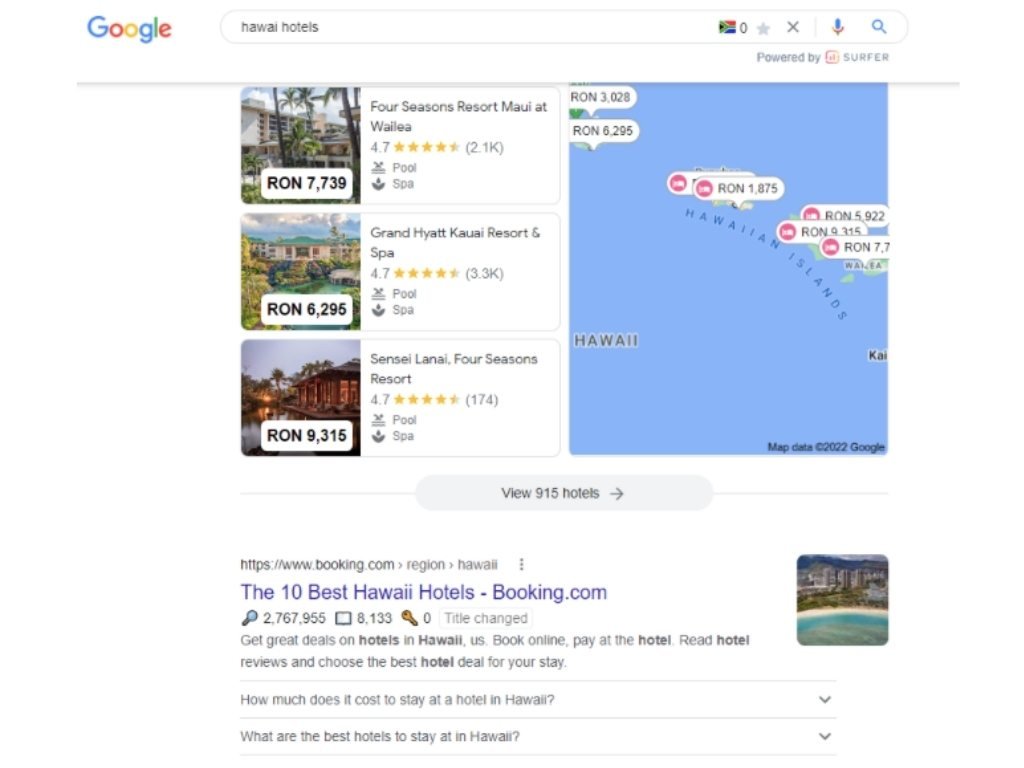
Long tail keywords are more specific. These tend to include more modifiers and are easier to rank for. An example would be “all-inclusive beach hotels in Honolulu Hawaii”. This is especially powerful given the high volume of content and competition within the travel industry.
The Benefits of a Powerful Keyword Funnel Strategy
A keyword funnel strategy allows you to identify and categorise your content based on popular search terms by users. While you may always have your own keywords that you focus on, here are some of the benefits of implementing a keyword funnel for your site.
It Provides Structure for Your Site
The most notable benefit has to be how it can help structure your website. Having your broad short-tail keywords as pillar posts or category pages allows you to create a web-like structure from which your content flows.
A great example of this is a travel agency focusing on tour packages. If your site offers content on world travel and isn’t site-specific, then creating category or niche pages on each major country is a fantastic start.
From there, you can include city or attraction-specific tours that target the highest-volume and easy-to-rank keywords for that specific region. This web-like structure also allows your niche audience to easily navigate the site, offering them the best possible user experience.
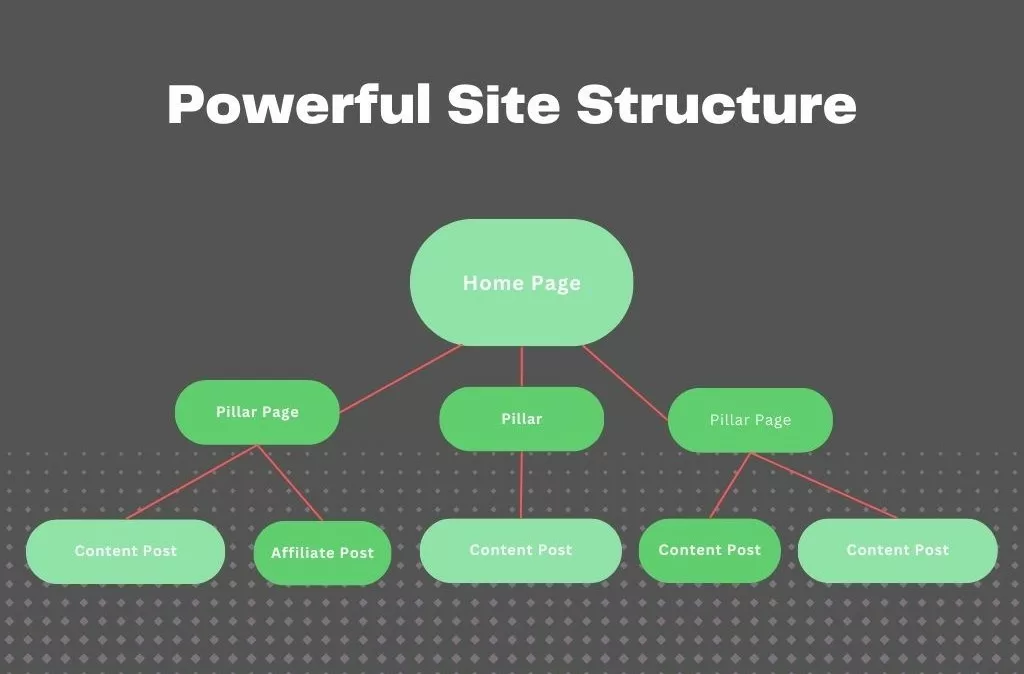
Helps you Identify High Volume Keywords Related to Your Niche
The other benefit of a keyword funnel strategy is it allows you to target high-volume, easy-to-rank for keywords. How is this the case?
Consider you’re looking for keywords for blogs on travel, and you’ve already extensively covered the topic “Tropical vacations”. You have covered all the possible destinations under this niche, but that doesn’t mean you’ve answered all the top search queries for the topic.
For example, your audience may want to know about the “Cheapest all-inclusive vacations in the Seychelles” or the “Best cruise tour operators in Bali.” These could be easy-to-rank, high-traffic keywords you haven’t covered under the broad keyword “Tropical vacations.”
With the right marketing strategy and website structure, your site can start crushing the competition.
Tip: If you’re looking to improve your SEO, have a look at our content marketing strategy services .
The Different Types of Searched Travel Keywords to Consider
You now know the difference between broad and long-tail keywords, but we can go another step further. When a search engine user types a keyword into the search bar, they are looking for something specific.

Informational Intent
Informational intent includes users looking to broaden their knowledge on a particular topic. The content you provide for these keywords will need to answer the reader’s search query and ideally offer further reading material to potential money-making pages.
This is where a systematic approach to the content is crucial. You don’t want to draw in potential clients but have a high bounce rate because you’re not answering the user’s query.
Having high-quality content on your site that provides valuable information develops a level of trustworthiness for the user. This can help encourage them to continue exploring your site and potentially lead them to money-making pages.
A great example might be “Best time to visit South Africa”. This informative post can internally link to money-making posts such as “Best hotels in Cape Town”.
Navigational Intent
These are keywords that usually draw traffic directly to your site. In most cases, users with a navigational intent have developed a level of trust with the site and have become regular visitors.

Commercial Intent
If you’re looking to provide valuable information but also want to monopolise money-making potential, this search intent is best to target. Travel companies and regular bloggers love to target this user intent, and it’s usually beneficial for the reader and themselves.
More often than not, these users are just browsing potential products or wanting to further their knowledge before making a purchase.
A great example of this might be “Best boat cruises in Cape Town”. You can easily provide beneficial information for the reader and offer bookable tours for the topic.
Transactional Intent
This refers to the target keywords that users enter with the intention of purchasing something. Although this intent is fairly similar to commercial intent, however, the user already knows they would like to make a transaction.

How to Use SEO Keywords for Travel and Tourism?
SEO keywords need to be strategically placed within a title, meta description, and content. These are three of the most important elements displayed in the SERPs, so optimising this is essential for your travel website or blog.
Incorporating Keywords for Travel Blogs Into Titles
The page title is important as it tells users and search engines what your website or posts are about. For this reason, you should ensure that your page title is SEO-friendly to both people and bots.
For an SEO-friendly page title, keep the following in mind:
- Humans decide whether or not they should click, so make sure your page title is catchy and enticing.
- Ensure your target keyword appears in your page title, preferably near the beginning.
- Keep your page title between 50 and 60 characters, or 580 px long.
- Try not to include the target keyword in the title more than once. This can be seen as keyword stuffing.
- Include strong modifiers in your page title. These are words that will help your page rank for related search terms. In the image above, a strong modifier is “cities”, which can help the post rank for a query like “best cities to live in South Africa”.

Adding Your Target Keyword to the Meta Description
The meta description, along with the page title and URL, appears in the SERPs as a snippet. As such, optimising this can greatly influence your click-through rate.
Here are some tips for an SEO-friendly meta description:
- Include the target keyword or synonyms in the meta description.
- Add your target keyword. Ideally, try to have it within the first sentence of the meta description.
- Your meta description should be between 50 and 160 characters, or 400 px to 920 px in length. Search engines generally cut off anything past this length, and if it is shorter than 50 characters or 400 px, it’s highly likely it won’t be included.
- Ensure that it includes catchy travel words — you could pose a question or call to action to draw in the audience.
Making the URL User and SEO-Friendly
The URL of your web page is also essential for ensuring your travel content is seen. A relevant URL will help search engines categorise your content and thus increase its likelihood of ranking in SERPs.
To optimise this, follow these steps:
- Your URL should contain your target keyword, as this tells users and search engines what the page is about.
- Ensure that your URL is short, clear, and easy to understand — avoid additional words, symbols, special characters, or numbers.
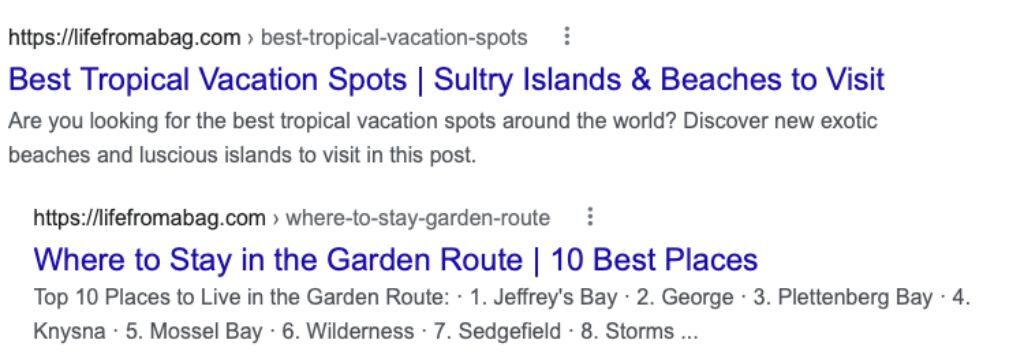
The image above shows an optimised snippet (the top snippet). The target keyword (best tropical vacation spots) appears in the URL, meta description, and page title. Additionally, both the page title and meta description are catchy and an ideal length.
Adding Keywords Related to Travel Into Text
Based on your keyword research, you will want to include various keywords throughout your content. These should relate to your topic or main keyword. For example, if you’re writing on hotels in Hawaii on the beach, you’ll likely find plenty of other keywords similar to this that will also help you rank.
In the following section, we will highlight some ways that you can find strong topics and keywords for your travel blog or website.
How to Find the Top Travel Keywords for SEO
The first place to find good travel SEO keywords is through your own expertise. If you’re an expert and know about specific destinations, then use that knowledge by writing articles based on where you’ve been or things in the industry that interest you.

To take it a step further, ensure that the search term you’re targeting is actually being searched for. There are several keyword research tools you can use to help with this. Popular picks include Ahrefs , Google Search Console , SEO Surfer , and Ubersuggest .
These tools will provide you with a wide range of practical insights to validate targeting a given keyword. Some valuable data provided include the amount of traction a keyword receives each month (pertaining to traffic and volume), whether or not the keyword will be easy to rank for, and plenty more.
By considering these insights, you will be able to create content that best aligns with your target audience’s intent.
Social media platforms like Pinterest, Instagram, Facebook, and Twitter can also provide you with a number of useful insights. These platforms are particularly helpful for understanding your target audience and the queries they’re after.
Below is a detailed guide on how to leverage each of these tools to find strong keywords and opportunities for your travel site or blog.
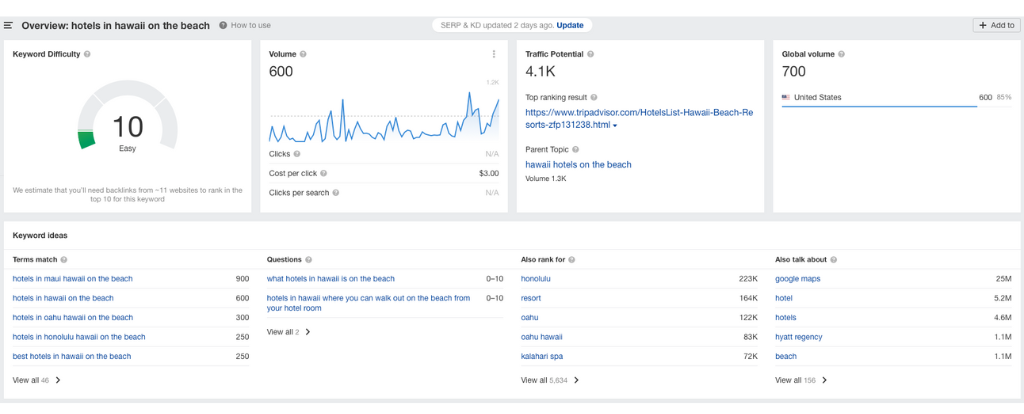
By leveraging Ahrefs data, many marketers and SEOs have been able to achieve higher Google rankings. To make things even better, the Ahrefs blog is also an open source of tips and tricks to help you maximise the Ahrefs tools.
Note: Ahrefs is a premium tool, but it has some great features for finding more traffic. So, if SEO is your thing, then we would highly recommend taking the time and signing up for this monthly service.
2. Google Search
If you’re not looking to pay a monthly subscription fee, then do not worry — there are plenty of ways to find strong keywords and topics without spending a cent.
One of the most powerful tools is Google. You can type the query you wish to target into the search engine and see what comes up in the SERPs. It also helps to look at the “people also ask” section, as this includes additional information that users may be looking for based on their initial query.
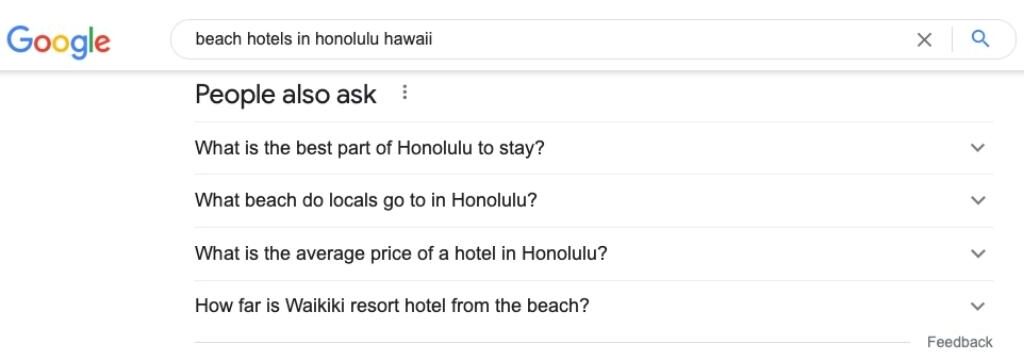
3. Google Search Console
Aside from the Google Search function, you can also use Google Search Console (GSC). This is a free tool, but it’s beneficial to use the Adwords tool, which will be at an additional cost.
GSC helps you perform your keyword research and identify possible search campaigns. Like Ahrefs, this will provide you with estimates on how many searches a keyword is getting. Another great feature is it allows you to see which keywords you are already receiving clicks and impressions from, which can help you decide if optimising a certain page is necessary.
As GSC is primarily targeted at those running Google Ads, you can also expect additional information, like the estimated cost of targeting a given keyword.
Tip: This is an extremely beneficial tool for content optimisation. If you want to upgrade your content, look at our on-page optimisation services .
3. Social Media
Another free tool that is often overlooked when researching the best keywords for travel websites is social media. While it is not necessarily a keyword research tool, it is an excellent source for finding medium and long-tail keywords receiving high traffic volumes.
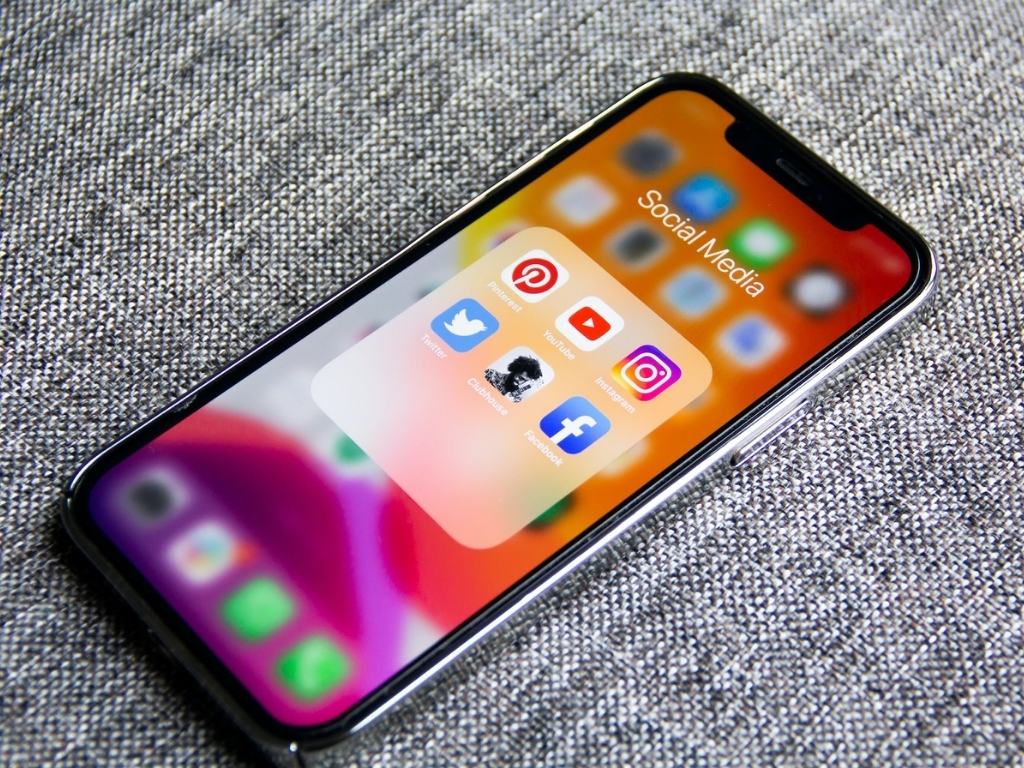
Social media platforms are constantly gathering information on people — including what they do, what they like, where they go, and what might prompt them to click. And given that the average user spends nearly three hours a day on these platforms, you can expect some good, reliable data.
Various social media platforms can be leveraged in different ways. Here is a brief look at how to use each for keyword research:
- Instagram: You can make use of hashtags to identify relevant topics. For example, if you want to post travel content, search #travel and see what other hashtags recent posts are using.
- Facebook: Use Facebook targeting options to learn about your audience or search travel-related Facebook groups for popular topics.
- Twitter: Use Twitter’s Explore function and see what topics appear under “trending” and “for you”. This will highlight various topics that people in your industry are talking about.
- Pinterest: This app predicts what content users interact with and provides related content. By searching for travel, you’re sure to find plenty of topics through pins, boards, and hashtags.
- YouTube: Use the auto-complete function to find related terms. This can be done using Google and Pinterest too. You can also check out the various travel YouTube tags.
Note that some social media platforms like Twitter will require you to be more active to reap the rewards. And if you’re looking to run a social media campaign of your own, check out our social media marketing services .
4. Keysearch
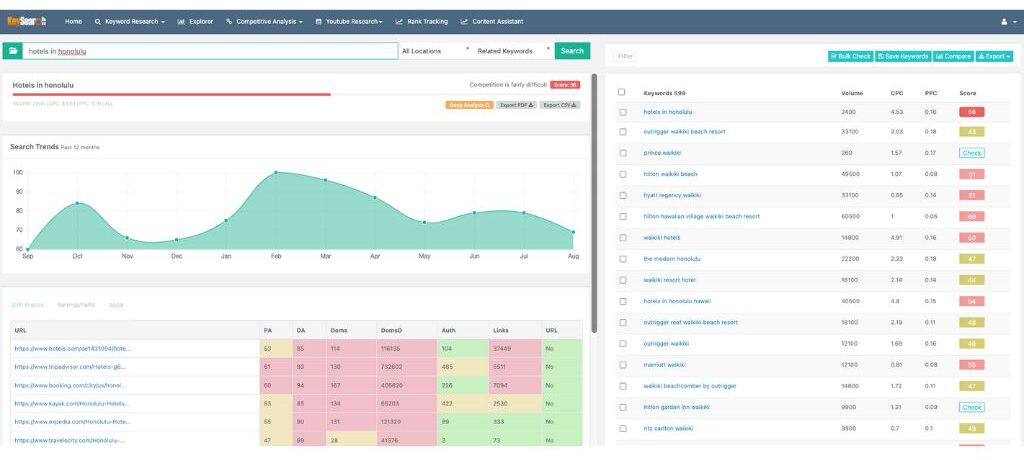
The free version of this tool will give you some basic information, but the paid version of Keysearch ($12/month) has more features and really helps with all your SEO campaigns.
It’s not too expensive, considering the detailed insights you can receive, so we would recommend signing up for the paid version.
5. Ubersuggest
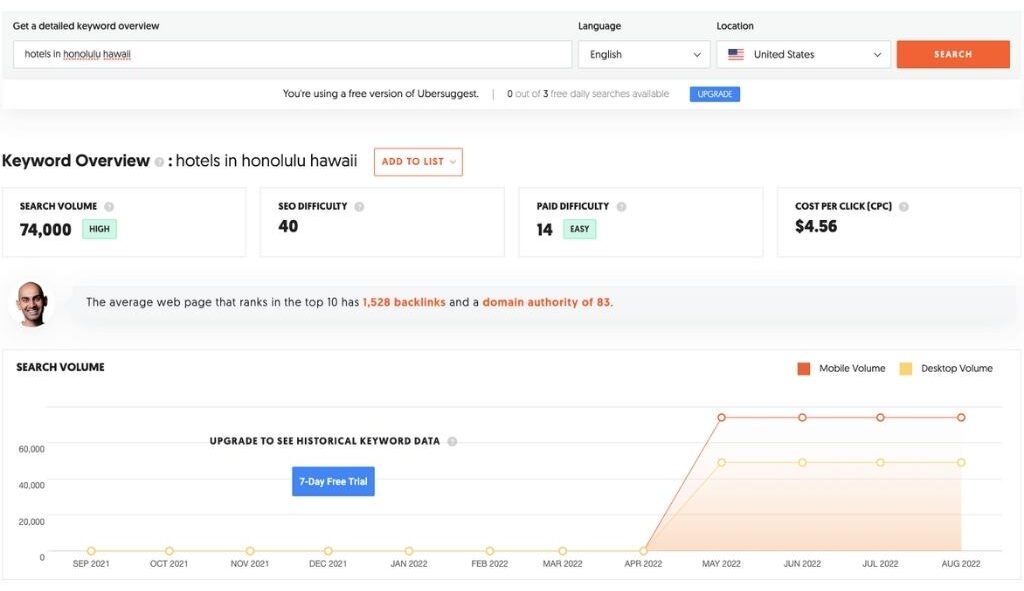
Ubersuggest is a free Chrome extension that provides you with a variety of insights, including keywords, monthly search volume, cost per click, and competition data. Simply enter the keyword or phrase you’re after, and it will bring up all the most popular pages for that term.
It’s also not limited to keywords specific to Google, but sites like Amazon and YouTube, too. As such, you can expect to find a variety of topics and long-tail travel keyword lists using this free tool.
6. SEO Surfer Chrome Extension
Like Ahrefs, Surfer SEO provides us with keywords to be used in our content. It takes the main keyword you enter, scans the web for competitors who are already ranking for that main keyword, and combines the keywords those competitors are using.
You will be able to see these keywords on the SEO Surfer site or by using the SEO Surfer Chrome extension . This will show you your keyword usage on the page you’re writing on and the keywords you should try to add.
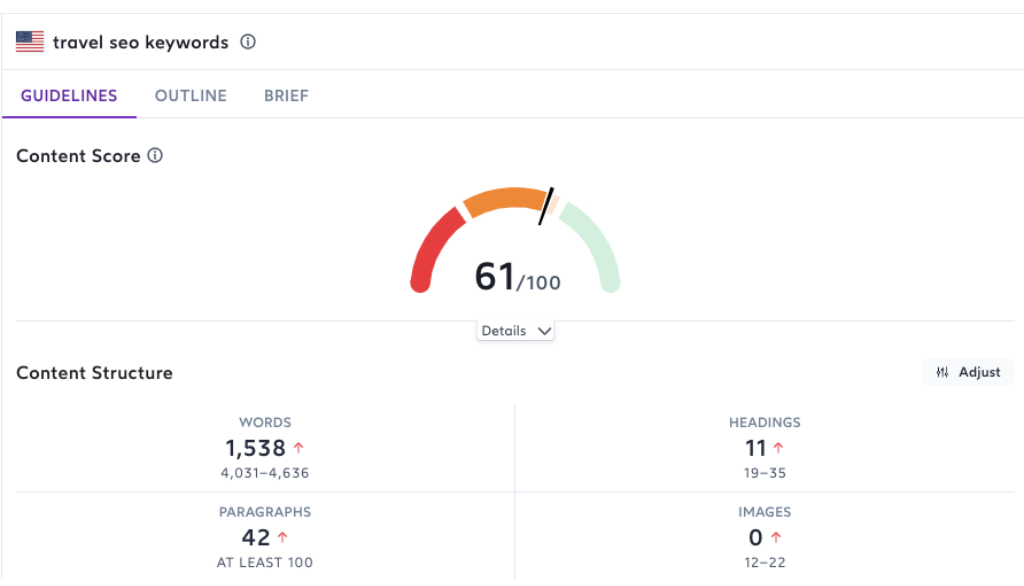
In addition to words and phrases, Surfer SEO provides several other metrics to help you write and optimise your content. These include the average word count that the post should be, how many headings the post should have, what keywords to include in those headings, and more.
A Quick Note on Modifiers
Keywords are a powerful aspect of any travel site’s SEO, but tracking the modifiers is also important. These strings of words and phrases are regularly added to the initial target keyword by search engine users.
Incorporating these popular modifiers throughout your content can play a significant role in helping you rank in SERPs. Keep in mind these should still be added naturally.
The Negative Effects of Keyword Stuffing
Keyword stuffing is seen as a technique in which one tries to manipulate and improve their search rankings by overusing keywords and phrases within their content. While this was a powerful strategy of the past, it forms part of the list of Google penalties your site can endure.
There is no formula to avoid keyword stuffing. But the best practice is keeping your content user-friendly and only naturally incorporating keywords where possible.
Our Processes for Finding the Best Keywords for Travel Bloggers
If you sign up for one of our travel SEO services , you may want some assistance finding related keywords to your travel niche. These processes require an analytical approach to identify already written content and find the best possible options for future content.
Here’s a basic breakdown of each process and the key differences between them.
1. Topic Mine
A topic mine helps you identify easy-to-rank keywords that can bring in the highest possible traffic to your site. It entails having an already established broad keyword such as “France itinerary”. Keep in mind there may be related keywords that could help you find more topics to write about.
An example, if the target keyword is “France itinerary”, you may want to add “France travel” or “France Holiday” to your search.
Once we have the main topics, we use the Ahrefs content explorer tool to find high-traffic, easy-to-rank keywords about this topic. We then systematically identify the best topics to write on and prioritise them within a formatted sheet.
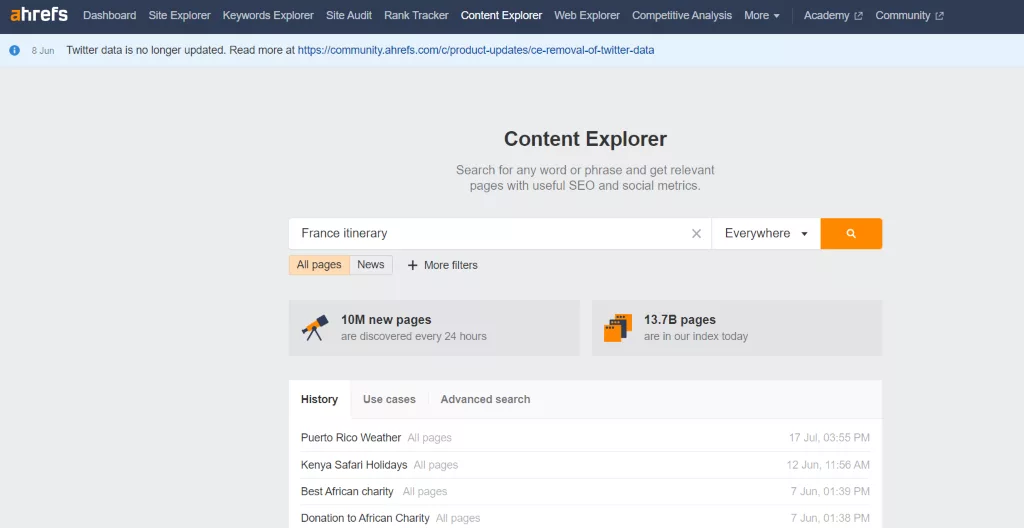
2. Phrase Match Mine
A phrase match mine is fairly similar to a topic mine. Usually, there is a predetermined series you will want to write about, such as “Luxury hotels in X” or “Best places to visit in Y”.
Using the Ahrefs phrase match tool, we are able to find all the best keywords matching the given phrases. This process helps you identify keywords that your site is most likely to rank for within a particular series.
This way, you are not wasting time and money writing high-difficulty topics.
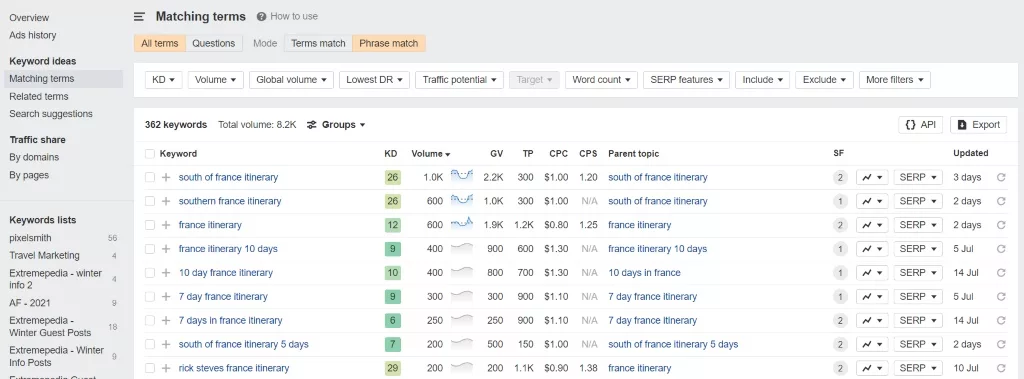
3. Competitor Mine
Our last and possibly most popular process is the competitor mine. As the name suggests, this is a process in which you find all the high-traffic, easy-to-rank posts that your competitors are ranking for.
We usually ask for your top three competitors or perform a quick site search on Ahrefs to identify your top competitors. We then identify and compare these three competitor sites and find the best topics your site can rank for.
What Are the Best Travel Keywords for the Travel Industry?
You no longer need to wonder what are the best keywords for travel websites. From knowing the different types of keywords to the plethora of tools mentioned in this guide, your SEO campaigns are about to hit new heights.
Whether you use Ahrefs, SEO Surfer, Google, or social media, you’re sure to find some of the most searched queries within the travel space.
So what are you waiting for? Begin with effective keyword research to find high-traffic topics and keywords relating to various destinations, activities, and attractions, and start growing your travel blog!
What’s the next step? Book a marketing consultation session with us and start figuring out how your website can reach all the right people.

More to explorer

SEO Vocabulary | 75+ Words You Should Know

The Importance of Authoritative Content for SEO in 2024

ChatGPT vs Jasper AI | The Pros & Cons of Each AI Writing Tool
Book a call with an digital strategist.
- Vlogging Gear

The Ultimate Guide to Starting a Travel Vlog on YouTube
So you want to start a travel vlog.
Makes sense! Video is one of the most immersive and engaging mediums for telling stories. When done well, you can effectively bring people along with you on your journey and make them feel like they’re traveling with you. You’ll also be able to showcase your personality and connect with your audience in a way that words and photographs just don’t allow.
Then there’s the glamour surrounding this line of work. After all, who doesn’t want to travel to exotic destinations and make a living off it? It may sound like a dream — and it can be — but it’s a lot of work. Many people set out to be travel content creators and ultimately give up because the road to success is such a slow burn.
In this post, we offer a step-by-step guide to starting a travel vlog on YouTube based on our learnings over the past year. From deciding on the type of vlogs you want to make and choosing the best filming equipment to video editing tips and promotion tactics, we’ve got you covered.
Table of Contents
Decide on the type of travel videos you want to make, choosing the right video cameras & equipment, just start filming, editing your videos: process & tools, publish your video & promote: youtube seo & more.
Before you do anything, it’s important to decide on the type of videos you want to make and what story you’re trying to tell.
Here are a few types of travel videos you can consider:
- Travel guides
- Documentaries and cultural storytelling
- Explanation and marketing videos
- Niche topics, such as adventure and sports, travel hacking, food, urban explorations, etc. The possibilities are really endless!
If you’re not sure what you want to focus on yet, you can start researching what others in the field are doing to get inspired (this basically means binge-watching YouTube). You can also begin by filming and publishing a few different ideas. Take note of what your audience seems to like and what you enjoy doing and lean into that!

How We Decided on Travel & Food as Our Niche
A lot of content creators have trouble deciding on their niche. I certainly did.
This is not my first rodeo — I first created my travel blog in 2013, and the site you see now is in its third iteration. For years, I created generalized content on travel, and, as the number of creators proliferated, it was extremely difficult to stand out.
For me, I associated my niche with my passion, and I was always stuck on figuring out what in the world that was. It always felt like this elusive idea that I couldn’t quite nail down, and I was over-complicating it like hell.
Ask yourself, what do you like to do? What do you already do? What can you do regularly and consistently over a long period of time? This will be your niche. It may already be right in front of you and you just don’t realize it yet.
I’ve been a voracious eater for as long as I remember. I love food, I’m curious about food, and I’ll try anything once. When I travel, I often center my explorations around food and eat more than three meals a day. In 2020, I had this lightbulb moment: I’m going to make travel videos, and a lot of them will be about food . Duh. I was already eating everything while traveling anyway, just not filming it.
And it’s ok if what you like is outside the box. So many people have built empires around non-traditional topics or interests that school convinced us we couldn’t make money off of. Jason Rupp has almost half a million subscribers on YouTube posting videos of himself getting barbered and pampered around the world. People make a sustainable living on YouTube by posting hour-long videos of fishing, for goodness sake. People watch YouTube for all reasons. Use this to your benefit.
Of course, cameras and equipment are essential for making videos. However, I would nail down your niche and the story you’re trying to tell before choosing what to invest in, as this will impact the type of equipment you need.
For example, if you want to showcase how you travel hack and get the best deals, maybe all you need is a webcam and screen recordings to start.
We create food and travel videos — what we care about is producing high-quality content that makes people feel like they are traveling with us. We also care about being able to fit all our equipment into a backpack so we can film on the go. Our camera and accompanying gear were chosen accordingly, and we made the conscious decision to put in a larger upfront investment.
Camera & Gear We Use for Our Travel Vlog
- Sony a7 III camera body (and we just pre-ordered the Sony Alpha 7 IV ! ). This is often regarded as one of the best cameras for filming videos because the images are 4k and of cinematic quality.
- Sony 16-35mm camera lens . This is the lens we use to shoot most of the footage you see on our current YouTube videos .
- JOBY GorillaPod . This is a bendy, flexible tripod that can be set up anywhere. It also easily fits into a backpack for on-the-go shooting!
- Sennheiser wireless microphone system ensures crisp, clear audio in spite of background noise. We also use a RODE microphone on occasion, especially when we’re shooting multiple subjects.
For those with less to spend and who want to get started quickly, the Sony Z1 Digital Camera for Content Creators is a fantastic all-in-one option. This camera films in 4k, has a flip screen and super-wide filming angle so you can easily film yourself, and a high-quality microphone and wind screen.

See our full list of travel vlogging equipment and why we chose it here.

It’s going to feel weird when you first start filming — especially if you’re talking on camera or filming yourself. You’re not going to feel prepared, you may feel awkward, and you’re not always going to know what to say. It can be nerve-wracking to talk on camera in front of a room full of people. I used to judge YouTubers for not being perfectly articulate until I started talking on camera myself, and now my attitude has changed to pure admiration.
The best way to learn is to simply start doing and improving from your mistakes. Being on camera gets easier with practice, and you’ll get better and more natural with time (even if the nervousness never fully goes away). Now, whenever I feel shy during filming, I remind myself of a piece of wisdom passed on by Lenza — “literally nobody will remember you in an hour.”
When it comes to the quality of your footage, watching what you’ve filmed and taking a stab at editing will show you what you’re missing and what you need to capture in the future to tell the story you want to. Just throw yourself into the deep end and let it happen.
Alright, so you have your raw footage. Now it’s time to make magic with it.
Filming & Editing Travel Vlogs: Our Process
Every filming and editing process looks a little different, but here’s how ours goes right now: 1. Plan an idea. Whether this is a food tour in a specific destination or a story we want to tell, we plot out the rough flow of the video and the footage we want to capture. If it’s a food tour, I’ll research where we’re going to go ahead of time. If it’s a specific subject matter or story, I’ll script an outline of how the scenes should flow. There is an element of improvisation since you can’t predict everything that will happen during filming, and that’s what makes it fun! 2. Film the idea. 3. Stitch together a rough cut of footage . This can be a chronological stitch or a stitch based on a pre-set storyline or idea. 4. Trim excess footage . Oftentimes, you’ll find yourself with redundant scenes or footage that don’t add value — the “fat.” Be ruthless in cutting this. Modern internet users have the attention span of goldfish. If you don’t get to the juice right away, you’ll lose viewers. 5. Add the “frills.” Once excess footage is cut, we add transitions, b-roll, music, special effects — you know, the fancy stuff. 6. Complete a final round of feedback and record any voiceover that is needed. 7. Final review and publishing. We watch the complete video obsessively to catch any errors/make final changes before uploading to YouTube.
Video Editing Tools
- Video Editing Software: We use Adobe Premiere Pro to edit all of our videos.
- Music: Good music is powerful. I’m still amazed at how a boring clip of me talking automatically becomes more bearable with the right music. We get all the music for our videos currently using Epidemic Sound , which gives us access to a huge library of royalty-free music and sound effects.
- Voiceover : Voiceover can be an effective, engaging way to tie your footage together into a story. Think about Parts Unknown — what makes the show iconic is Anthony Bourdain’s deep voice and storytelling skills. It stitches together an hour’s worth of footage into a narrative . We use this compact RODE microphone to record voiceover on the go. It’s so easy to use that even the least tech-savvy person (cough, me) can figure it out.
When you get started, there’s going be a skill gap between where you are and what you aim to be. It may take hours to get something simple done. This is frustrating at first, but, like anything you learn, grow, and become better and more efficient. Practice makes perfect, as the cliche goes.
When you get started, there’s going to be a skill gap between where you are and what you aim to be.

Woohoo, your first video is ready! Now it’s time to create your YouTube channel and publish! But there’s more to it than just uploading your video. If you’ve never heard of SEO before, there’s no better time to learn than now because it’s a huge part of how people are going to find your videos. And there are other considerations to increase your channel’s visibility as well.
YouTube SEO…A Necessary Evil
SEO stands for search engine optimization. And you need to understand at least the fundamentals to improve the ranking and visibility of your videos on YouTube.
Let’s say you’ve created a video on the best places to eat in Rome and you’re trying to figure out a good title. Originally, you were going to go with “where to eat in Rome,” but after some research, you find that people search for “best restaurants in Rome” significantly more. The keywords convey essentially the same thing, but going with “best restaurants in Rome” will result in more people finding your video.
Think about how people find videos. They have a question they want answered or something specific they’re looking for and they turn to the YouTube search engine to surface relevant content. There are trends in the way people type their queries — specific sets of words or specific orders of words are more commonly used than others. You want to make sure you’re using the right words in the right order so YouTube will know to display your video when it makes sense.
Of course, there are more nuances than that, but that’s the gist of it.
Here’s how to optimize your videos for SEO:
- Learn SEO Fundamentals . Moz has a great SEO guide for beginners so you can begin understanding the landscape.
- Do Keyword Research. Find out exactly what people are typing in the search bar to find the type of videos you are creating. TubeBuddy has a video keyword explorer in their robust suite of YouTube optimization tools. I also like the Keywords Everywhere Chrome extension, which shows you a list of keywords that any video on YouTube is ranking for.
- Optimize Your Videos: Once you have your keywords nailed down, make sure you include them in your video title and video description . When you add tags your video , add your primary keyword as the first tag and then max out the number of tags you’re allowed with synonyms and tangential words and phrases. You want to provide the YouTube algorithm with a clear signal of exactly what your video is about so it knows which search terms to showcase it under.
How to Promote Your YouTube Video
Unfortunately, there really is no secret to making your video go viral or growing your channel rapidly. Instead of obsessively focusing on views or subscriber growth, direct that energy towards making high-quality content. If your videos are engaging, people will eventually come. Just be patient! In the meantime, here are a few things you can do to spread the word that are in your control:
- Create Eyecatching Thumbnail Images. You want folk to be compelled to click on your video when they see your thumbnail image. Go for colors, interesting imagery, and big ol’ fonts that pop right off the page. I use Canva Pro — a powerful drag-and-drop graphic design tool — to create my thumbnail images.
- Post to Social Media. If you have an existing following, great! If not, post to your personal channels or share with friends and family to get a boost.
- Share to Relevant Communities. Research Facebook groups, Slack communities, Reddit threads, and more that focus on the topics you make videos about. Be careful though — a lot of these communities are resistant to blatant self-promotion. Make sure you are contributing in other meaningful ways so your posts stay up.
- Embed and Link Videos. If you have a blog or website, make sure you embed your videos on relevant posts and webpages. This offers a great boost for SEO as well.
I hope you enjoyed this step by step guide to starting a travel vlog on YouTube! If you have any questions or thoughts, please leave a comment below!
Liked This Post? Pin It!

Dottie is a travel blogger and YouTuber, and one part of Dots on a Map. Check out her YouTube at www.youtube.com/dotsonamap, where she tells stories about travel, food, and local cultures around the world.
Where to Eat in Mexico City: Best Restaurants, Street Food & More
An unexpected exotic food tour: exploring mercado de san juan in mexico city, you may also like, our youtube channel for food & travel is..., learnings from five months of travel blogging while....
I really appreciate how you broke down the process step by step, making it seem less overwhelming and more attainable. Your emphasis on authenticity and storytelling resonated deeply with me. It’s refreshing to see someone emphasizing the importance of being true to oneself rather than conforming to what’s popular or trendy. Your reminder to focus on creating valuable and engaging content rather than obsessing over equipment and fancy editing techniques was a much-needed reality check for me.
Hello!Namaste! Dottie ma’am!Thank you for sharing your Vlog blogging youtube channel information for beginners like me.I already have got started Website/blog and youtube tube channel .It’s on way to go for. I want to begin a TRAVEL Vlog video youtube channel like you on near future. Your Vlog blog helped me to boost my knowledge to join a new parttime job. Your job is great!Thanks Dottie ma’am!
Leave a Comment Cancel Reply
Save my name, email, and website in this browser for the next time I comment.
YouTube Ads: The Ultimate Guide For Travel Marketers
Table of Content
Why youtube ads are an amazing opportunity for travel brands, the incredible targeting available with youtube ads, what targeting to use and when, the different ad formats on offer with youtube ads, how to setup your first youtube ads campaign, the “secret sauce” to running profitable youtube ads campaigns.
Whilst many Travel Brands are flocking to Facebook Ads and Google Ads (with good reason, as they do work), there’s a huge, under-rated and ripe opportunity happening over on YouTube with YouTube Video Advertising – or YouTube Ads as I’ll refer to it in this Ultimate Guide.
So why aren’t we seeing many Travel Brands using YouTube Ads?
Well, the main reason we’ve come across is “…because video is too complicated/too expensive”
And, yes, there is a cost (or an investment) into producing YouTube Ads, but in order to ‘win’ in today’s crowded marketplace, Travel Brands need to “…speculate to accumulate.”
In other words, you need to invest in order to grow.
And with the competitive online marketing world and the fight for attention from travelers, diversification is the name of the game.
“88% of YouTube travel-related searches focus on destinations, attractions, points of interest or general travel ideas” (Google)
But advertising needs to be profitable too and you need to see an ROI as quickly as possible. Well, with the right strategy, approach and foundations, with YouTube Ads you can see huge ROI in as little as 1-3 months.
With so many travelers using mobile devices to research and plan their holidays and travels, and with attention spans becoming shorter, video is one, if not, the most engaging and powerful way to inspire your potential customers, turning them from ‘lookers into bookers’ in the moments that matter to them, on the devices that they’re using; desktop, mobile or tablet.
If you’re not using video as part of your advertising strategy, you’re missing out.
According to Cisco, in 2019, video will account for 80% of internet traffic throughout the year .
So, with all that being said, here’s What We’re Going To Cover In This YouTube Ads Ultimate Guide:
- Why YouTube Ads are an amazing opportunity for Travel Brands
- The incredible targeting options available with YouTube Ads and how to use them to reach travelers at the different ‘Micro-Moments’ along their ‘Path To Purchase’
- The different YouTube Ads formats, when to use them, specs and requirement
- The ‘Secret Sauce’ to running profitable YouTube Ads Campaigns
About the author

This is a guest contribution by Matt Holmes. Based in the UK, Matt is the founder of Visual8 Digital , a specialist YouTube Ads Agency for Travel Brands, producing and managing profitable, ROI-Focused YouTube Ads Campaigns, that tell inspirational stories and drive direct online bookings.
When he’s not filming, editing, running YouTube Ads Campaigns, you can find him in the gym, out walking with his wife and 2 whippets (dogs), or traveling around the UK, Europe or further afield – and yes, the camera goes with him on his travels!
With a huge audience of travelers and holidaymakers using YouTube, and 88% of travel-related searches on the platform relating to destinations, attractions, points of interest and general travel ideas , the opportunity to position your Travel Brand in front of your ideal customers, has never been more exciting.
There are also over 2 billion monthly active users on YouTube, which is right on the heels of Facebook’s 2.3 billion. But the biggest difference between these 2 online giants, is that the average user stays on YouTube for over 40 minutes at a time (this is known as ‘session time’), compared to Facebook’s average of 20 minutes per day.
And with so many Travel Brands using Facebook Ads and Google Ads to advertise, why should you, as a Travel Brand, use YouTube Ads? Well, here’s 3 reasons (but trust me, there’s plenty more where these came from!):
- Reach your ideal customers based on their intent
- Incredible targeting opportunities
- Unsaturated, cost-effective advertising platform
When people go to Facebook, they go there to catch up with friends and family, perhaps post a few pictures of their day and generally, just kill a bit of time. They don’t really go to Facebook for a specific purpose.
But with YouTube, it’s a whole different ball game.
The reason being, that people go to YouTube with an INTENT. They generally go to YouTube to:
- Learn Something
- Do Something
- Buy Something
And when you advertise on YouTube with YouTube Ads, you can target people based on their INTENT.
Google owns YouTube, so as an advertiser, you have access to the data that Google knows about its users.
Now, when I say Google has got data on its users, I don’t mean personal details like name and address (although they do know that sort of information for people who have a Google account of some sort; but this information isn’t accessible to advertisers).
No, what I mean about the data that Google has on its users that is available to us as advertisers, are details such as:
- Websites they’ve visited
- What they’ve searched for on Google and YouTube (keywords/search terms)
- Videos they’ve watched and engaged with on YouTube
- What they’re ‘in the market’ for – in other words, Google knows when someone is seriously considering making a purchase
- What sort of topics they’re interested in – for example, ‘hotels in Paris’, ‘car hire in Rome’, ‘holidays in Australia’
- Places they’ve visited (using Google Maps data)
- Apps they have installed on their Smartphones
And, as we’ll cover next in this Ultimate Guide, you can actually choose to show your YouTube Ads on specific YouTube videos and Channels, which is something unheard of in the realm of online advertising, to be able to be that granular with your targeting.
YouTube have really taken their advertising targeting to the extreme; particularly when combined with the data that Google (YouTube’s owners!) have on its users. This gives advertisers a huge advantage when creating YouTube Ads Campaigns, as we can pinpoint exactly who we want to show our YouTube Ads to and reduce our wasted ad spend by not showing our ads to people who are never going to become customers.
So let’s now take a look at some of these incredible targeting opportunities:
Target People Based on Their Location
Location can be a critical targeting option for Travel Brands, especially if you offer experiences or activities to people who are in or around your destination.
With YouTube Ads, there are 3 high-level location targeting options available to you:
- All Countries and Territories (targets every country on Earth!)
- The Country You’re Based (I’m in the UK, so it’s showing ‘United Kingdom)
- Enter Another Location

However, we can drill down much further than this…
If you click on ‘ Advanced Search ’ next to the ‘Enter a location to target or exclude’ box, you’ll see more options become available.
The first one is Location , which allows you to add multiple locations of where you want your YouTube Ads to show, for example, ‘London’.

But the option I love is Radius . As this allows you to add 1 or more locations (as a place name, address, postcode, or coordinates) and choose a radius around that specific point on the map.
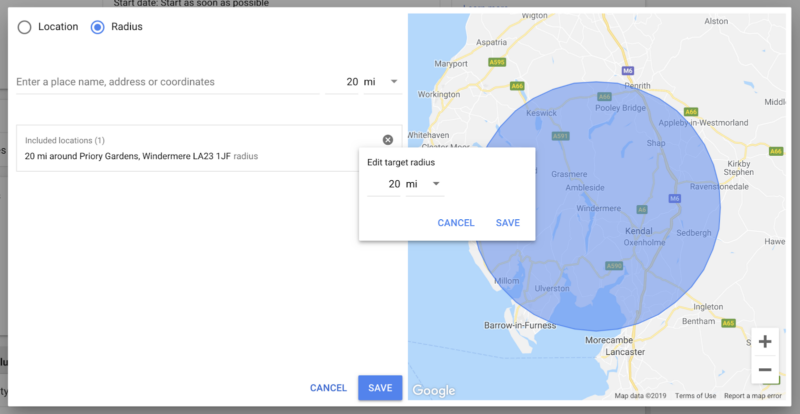
So if you only want to target people in or around a 20-mile radius of your location, you can do that with the location targeting of YouTube Ads!
And you can Exclude people in certain locations from seeing your YouTube Ads if you need to, by just typing the location into the ‘Enter a location to target or exclude’ box and clicking ‘Exclude’ .

Target Individual YouTube Videos and YouTube Channels
Yep, you can actually copy and paste the URL of specific YouTube videos or channels into your YouTube Ads Campaign, that you want to show your ads on. This is known as ‘Placement Targeting’.
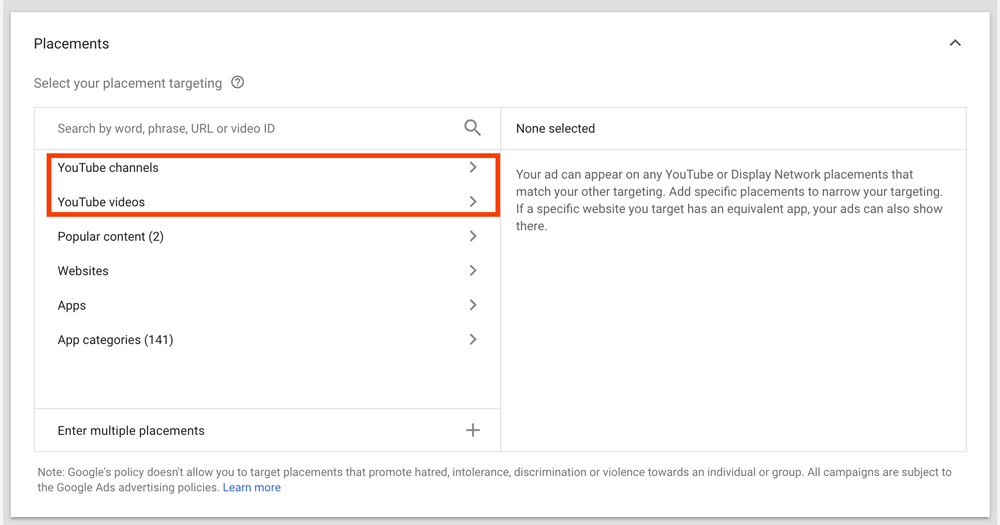
Just make sure that the channels and videos you’re selecting for placements are ‘monetized’, which simply means that the YouTube Channel owner has agreed to allow ads to play before their videos. You can see which YouTube Channels are ‘monetized’ by looking for the little yellow spots in the play-bar on YouTube Videos, as shown in the image below.

Target People With Keywords
Another targeting option, which is similar to Placement targeting (above), is using Keywords.
These are the keywords that relate to particular content someone is watching on YouTube. When a YouTube Creator uploads a video to their Channel, they write a Title, Description and Tags, which essentially helps their videos be discovered organically on YouTube and Google.
So when you target your YouTube Ads using keywords, YouTube is looking at words within the Title, Description and Tags that the YouTube Creator has added to their video.
Now you might be thinking that this is almost exactly the same as placement targeting! And it is very similar!
But the difference with keyword targeting is that you add say 50 keywords, and the YouTube algorithm will go and find all the videos that have those keywords associated with them, rather than you individually copying and pasting individual video URLs, which can take a lot of time.
One thing to be aware of, however, with using Keywords targeting, is that you’re relying on the YouTube Creators to use words within their Title, Description and Tags, that are actually relevant to their video content. If they’re adding keywords that are completely irrelevant to their videos but are relevant to your YouTube Ads, then your ads could show on videos that don’t align with your brand or message.
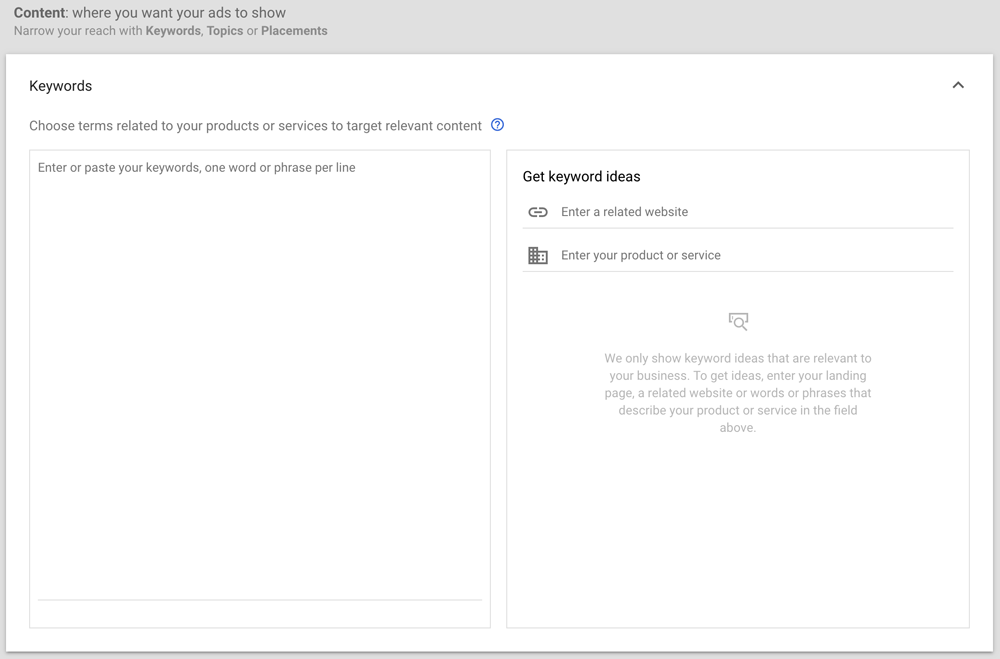
Target People With Topics
Similar to Keyword Targeting, Topic Targeting uses topics that YouTube Creators have selected when they’re uploading their videos. But as with Keyword Targeting, Topic Targeting relies heavily on YouTube Creators selecting the right topics, from a predetermined list of topics for their Channel. But it’s definitely an option to test, even with just a small budget behind it initially.
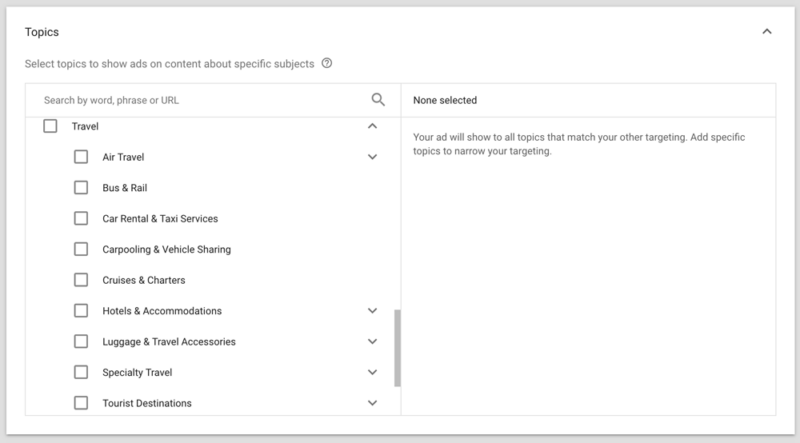
Target People Based on Their Google Search History
This is unique in the online advertising space! Using Google’s data, you can show your YouTube Ads to people based on what they’ve searched for on Google’s Search Engine that we know and love. This is known as a ‘Custom Intent’ audience.
For example, if you own an activity center in the Lake District, you could show your YouTube Ad to people when they’re on YouTube who have recently searched for keywords such as “kids activities in the lake district” on Google! I’m sure you’ll agree, that that’s pretty powerful!
To create a Custom Intent audience, the best place to start is by looking at your Google Analytics and Google Search Console accounts to see the keywords that have been typed into Google that bring up your website in the Google Search Results.
And if you run Google Search Ads, you could even use the same keywords you use in these campaigns in your YouTube Ads Custom Intent Audiences.
For best results, try and build a list of at least 50 keywords for your Custom Intent Audiences. You might think this sounds like a lot, but with tools such as Google Analytics, Google Search Console and Google Ads Keyword Planner, you’ll soon blast past 50 keywords!
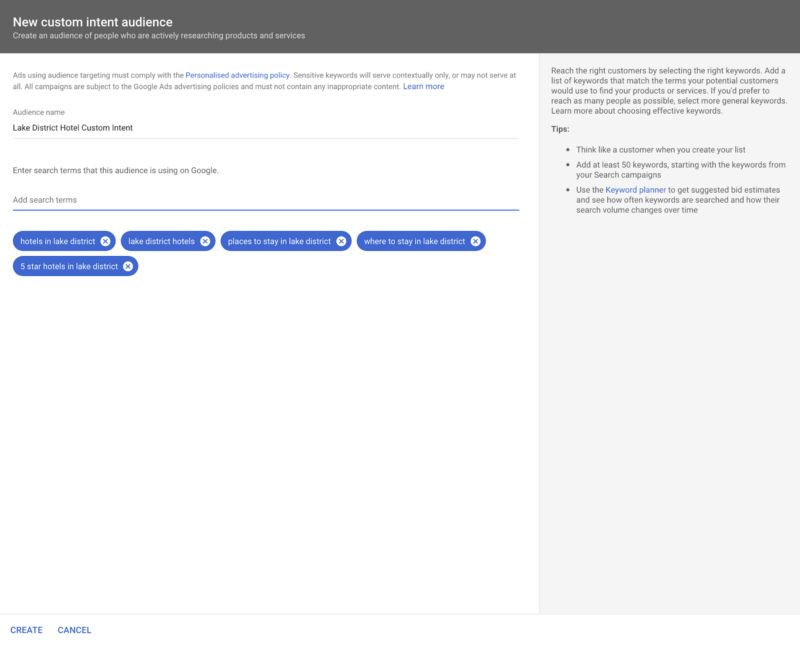
Target People Based on Their Purchase Intent (According to Google)
Google has an amazing targeting option known as ‘In-Market’. Using the incredible amount of data that Google knows about its users, based on an individual’s online behavior (Google search history, the intent behind the keywords they’ve searched for on Google and YouTube, websites they’ve visited, etc.) Google makes a great prediction as to whether someone is actively looking to make a purchase. And you as a Travel Brand can use these audiences to show your YouTube Ads to.
In-Market Audiences are similar to Custom-Intent Audiences (described above) but are grouped into predefined groups. For example, some of the In-Market Audiences available to you are:
- Trips By Destination
- Hotels and Accommodation
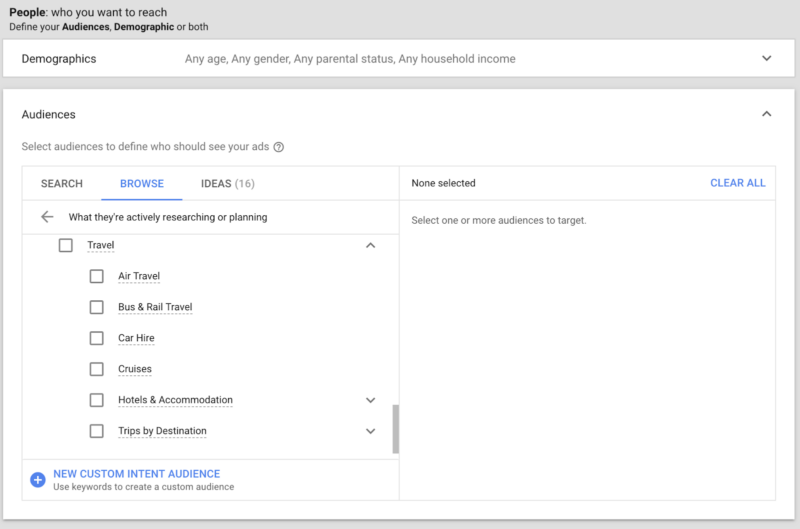
These are just a few of the many In-Market Audiences available; overtime, Google are constantly adding more and more to this list.
When thinking about whether to run Custom-Intent Targeting Campaigns or In-Market Targeting Campaigns, we always run both!
You don’t know what works unless you test! So by testing In-Market against Custom Intent, you’ll be able to see if one outperforms the other dramatically. And you can always turn the worse-performing targeting option off and scale the winning targeting option.
This is one of the many advantages of YouTube Ads! You can quickly and easily scrap the losers and scale the winners.
Target People Based on Their Demographics
Demographics is something that is common across all online advertising platforms; but it’s good to know that you’ve got access to demographic targeting with YouTube Ads, which includes:
- Parental Status
- Household Income (only available in certain countries)
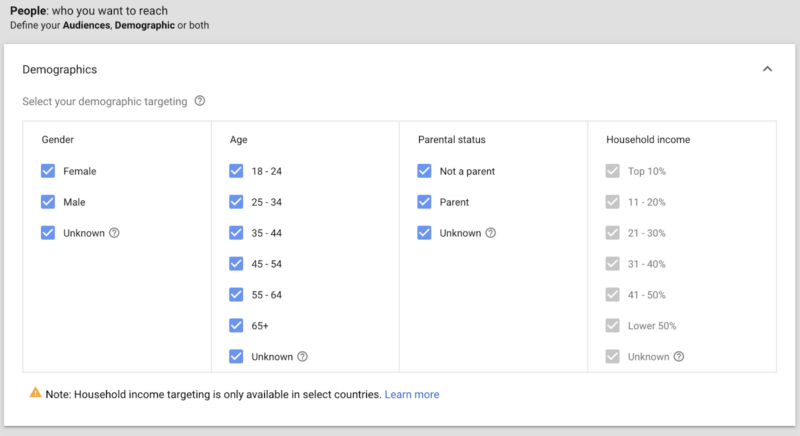
You can also target people using ‘Detailed Demographics’, which includes options such as:
- More detailed Parental Status (e.g. parents of infants, parents of toddlers, parents of teens, etc.)
- Marital Status (single, in a relationship, status)
- Education (e.g. current University students)
- Home Ownership Status (homeowners or renters)
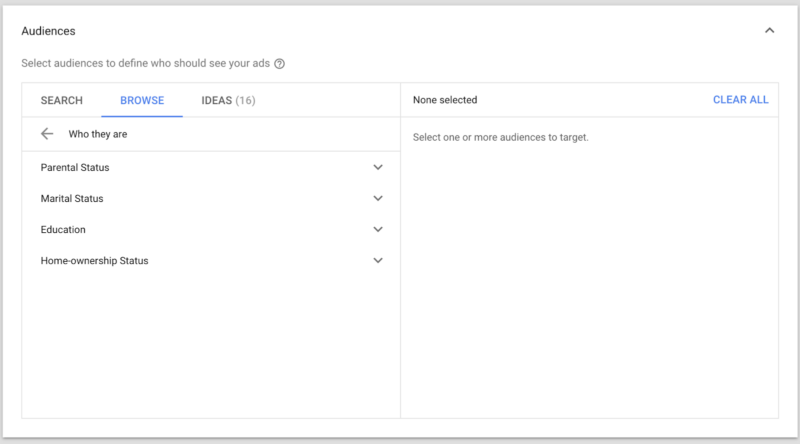
Target People Based on Their Interests and Habits
Over time, Google builds up an accurate profile of its users. So from the websites that they visit, the keywords they search for and their overall online behavior, they often know more about their users than the users themselves do!
And you can show your YouTube Ads to people based on the data that Google knows about the interests and habits of its users.
This audience type is known as an ‘Affinity Audience’.
Typically, targeting interests and habits is more of an upper funnel strategy, than a lower funnel, because they aren’t currently showing signs of being in a position to make a booking.
The predefined Affinity Audiences available with YouTube Ads specifically for Travel Brands are pretty limited, as you can see from the screenshot below.
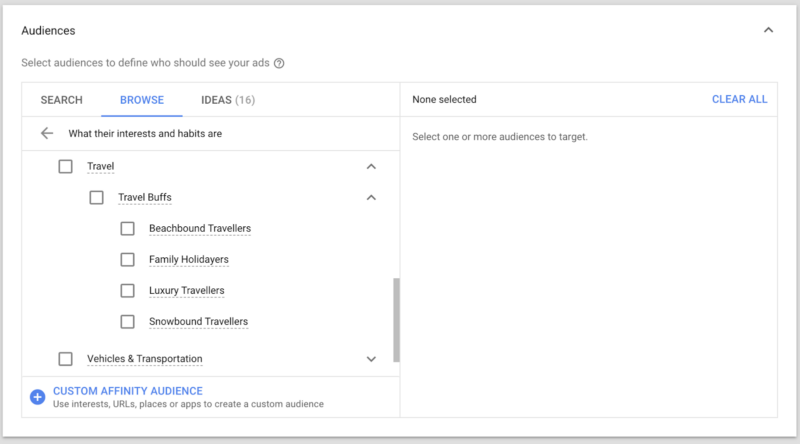
But all is not lost with Affinity Audiences…
We tend to use ‘Custom Affinity’ audiences, which allow for much more granular targeting, as you can target people based on:
- Interests (e.g. hobbies, products, activities, etc.)
- URL’s (the websites people visit)
- Places (using Google Maps data)
- Apps (installed on an individual’s phone)
For best results with Custom Affinity Audiences, try and add at least 5 items total. You don’t need to enter something for each of the 4 options (Interests, URL’s, Places, Apps).
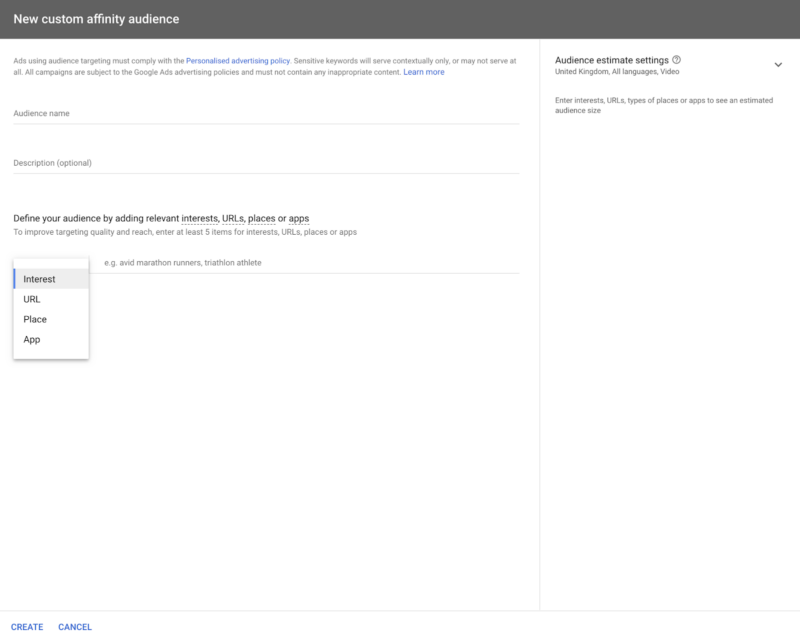
For example, if you’re running YouTube Ads for a cruise line, you could create a Custom Affinity Audience if you know that your ideal customers look online for subjects such as:
- Different locations for cruises
- Reviews of different cruise lines
- Cruising holiday deals
Custom Affinity Audiences can perform really well, but they take some time to refine and get them delivering great results for you.
So we tend to create Custom Affinity Audiences once we’ve gathered some data from other types of targeting options about the type of websites, interests, etc. that are relevant to people who are resonating with our other YouTube Ads have.
Target People Who Are Already Aware of Your Travel Brand
As with other online advertising platforms, with YouTube Ads, you can create Ad Campaigns that only target a warm audience; meaning that they are already aware of your brand.
So, perhaps they’ve visited your website, made an inquiry, watched one or more of your YouTube videos, or they may have even been a customer of yours in the past.
This type of targeting is known as ‘Remarketing’. And it tends to be less expensive to run Remarketing Campaigns, because you’re not going after a cold audience.
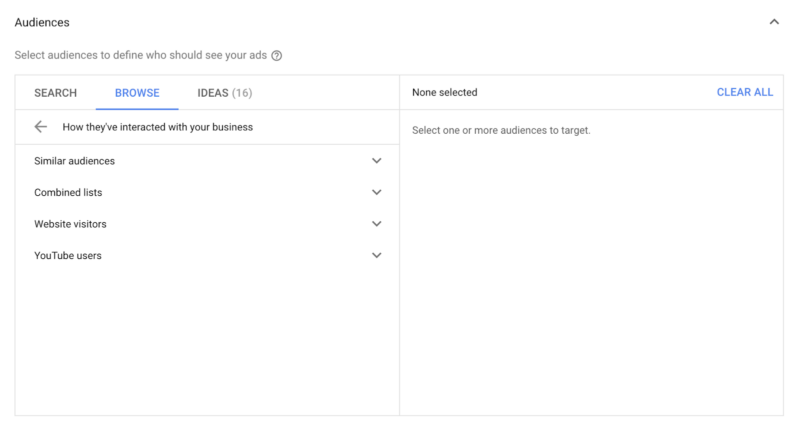
Another powerful type of Remarketing Audience is ‘Similar Audiences’. These are audiences that Google build for you based on other Remarketing Audiences of yours.
For example, let’s say you had a Website Visitors Remarketing Audience, Google would create a Similar Audience of thousands, even tens of thousands or more, of people who have similar interests, online behavior, etc.
As you can see, these are very powerful audiences and can produce amazing results!
Google says that you need a minimum Remarketing Audience list size of 100 people to create a Similar Audience list from.
However, we find that a Remarketing Audience list size of 1000 people produces much better results. So, if you can build a Website Visitors Remarketing Audience list of 1000 people, for example, Google will be able to build a strong Similar Audience list from this. But the bigger the better!
Just bear in mind that it can take 48-72 hours for Google to create your Similar Audience list.
So that’s an overview of the incredible targeting options available with YouTube Ads. But how and when should you use each of them to target travelers along their ‘Path To Purchase’? That’s what we’ll cover right now!
Rarely do we use one type of targeting for a client. To get the most out of YouTube Ads, I highly, highly recommend that you use multiple targeting strategies and test which ones deliver the best results for your Travel Brand.
Travelers go through their own ‘Path To Purchase’ when thinking about, booking and experiencing their holiday or trip. And within this journey, there are 4 main ‘Micro-Moments’:
So based on these Micro-Moments, let’s see how we would use the targeting available to us with YouTube Ads to reach travelers at each one.
Bear in mind that although we use some of the same targeting options at different Micro Moments, the YouTube Ads themselves (i.e. the video content within the ads) will be different.
To put some context into this, let’s use an example of a guided tours company in the Lake District who are running a YouTube Ads Campaign.
Micro-Moment 1 – I Want to Get Away – Dreaming Moments
YouTube Videos and Channels (Placements)
If travelers are in Micro Moment 1, they’re dreaming about getting away on holiday. So by showing your YouTube Ads on specific videos related to your destination is a great way to introduce travelers to your Travel Brand
Similar to Placements targeting, now we’re giving YouTube a list of keywords related to the content that we want our YouTube Ads to show on. But rather than finding the videos manually ourselves, we’re letting YouTube do the hard work and go and find the videos that have specific keywords in the Titles, Descriptions and Tags of videos across YouTube.
Interests (Custom-Affinity)
As I mentioned earlier in this guide, we tend not to use Affinity Audiences because the options are pretty limited for Travel Brands. Instead, we use Custom Affinity Audiences. So, we create a Custom Affinity Audience with a collection of Interests, URLs and Places typically. We tend to leave the ‘Apps’ option alone – but we’re always testing!
Remarketing
If people have previously visited your website it’s worth keeping your Travel Brand front-of-mind as early as possible in their Path To Purchase.
It’s also a good idea to remind previous customers of your brand, so if you have a database of email addresses that you have permission to use, you can upload these email addresses to create a Remarketing Audience of past customers to show specific YouTube Ads to.
Lake District Guided Tours Example I don’t want to make this guide too long, so I won’t list every single specific targeting option below! But I’ll show you a selection of where we’d start our targeting. Over time, we would, of course, refine this targeting as we start to see the winners and the losers.
YouTube Video and Channels (Placements)
3 Days in the Lake District | London to the Lake District Vlog!
Lake District, The Complete Tour, England
Living in a Converted Sprinter Van! The Lake District
- Lake District
- North England
- Things To Do In Lake District
- Dog Walking
- NationalTrust.org.uk
- Lakedistrict.gov.uk
- GoLakes.co.uk
- VisitCumbria.com
- Travel Accommodations
With this Custom Affinity Campaign, we would also use Location Targeting, as we don’t want to show our Guided Tours YouTube Ad to people outside of the UK who have an interest in ‘Walking, for example, as they may never have any intention to visit the UK!
- Visited website in past 7 days
- Visited website in past 14 days
- Visited website in past 30 days
- Visited website in past 60 days
- Visited website in past 90 days
- Customer List (previous customers)
Micro-Moment 2 – I Want This Trip To Be Perfect – Planning Moments
Custom Intent Audience
When travelers are planning their holiday, they tend to search for particular things on Google relating to planning. So create a list of keywords that are relevant for the planning stages of a holiday that relate to your Travel Brand in some way, such as things to do in your local area, local landmarks, etc.
Affinity Audience
As I mentioned earlier, we don’t tend to use Affinity Audiences, but we do like to test it now and again just to see if their audiences have improved – we won’t know unless we test it out!
It’s always worth reminding travelers of your brand throughout their Path To Purchase, which why we include Remarketing Audiences in every Micro Moment. But we would show these audiences an alternative YouTube Ad.
Lake District Guided Tours Example
Custom Intent Audience Keywords
- Places to stay in Lake District
- Hotels in Lake District
- Things to do in Lake District
- Places to visit in Cumbria
The reason I’ve included keywords about hotels, is that people looking for hotels in the Lake District will at some point be looking for things to do whilst on holiday. So even though they might not necessarily be looking for things to do on holiday right now, introducing people to your Travel Brand this early on in the Path To Purchase can work really well.
- Lifestyles & Hobbies > Outdoor Enthusiasts
Micro-Moment 3 – I’m Ready To Book It – Booking Moments
As in Micro Moment 2, we’ll use Custom Intent Audiences again, but this time using keywords that show someone is looking to book their holiday.
In-Market Audience
As I mentioned earlier in this guide, it’s worth testing Custom Intent Audiences against Google’s In-Market Audiences, choosing predefined audiences that relate to your Travel Brand.
Similar to remarketing in Micro Moment 1, we would show a different YouTube Ad to people who have previously visited our website, perhaps with a special offer, as well as another ad to previous customers.
- Lake District Guided Tours Offers
- Lake District Guide Tours Prices
- Lake District Tours Special Offers
- Lake District Tours Deals
- Trips To The UK
Again, I’ve selected In-Market Audiences relating to Hotels, because these people are ready to book and will be looking for things to do on holiday very soon after booking.
Micro-Moment 4 – I Want To Make The Most Of It – Experiencing Moments
Micro Moment 4 tends to be for Travel Brands who offer activities or experiences, such as whitewater rafting , helicopter rides, kayaking , restaurants, etc.
As people are actually on holiday in this Micro Moment, we only want to target people who are within a reasonable distance from your location; people aren’t going to want to drive for hours for a day out! So, it’s best to use location targeting with a specific radius from your Travel Brands postcode.
Custom Intent
If there’s something specific that people search for whilst they’re on holiday that relates to your offering, then creating a Custom Intent Audience is a great way to target these travelers.
And as always, a Remarketing Campaign is always a good idea to run in Micro Moment 4, providing you offer an activity or experience. I wouldn’t recommend using Remarketing in this Micro Moment if your main offering is Accommodation such as hotels or self catering cottages for example.
- People within a 30-mile radius of the area(s) that the Guided Tours company cover
Custom Intent Keywords
- Guided Tours Lake District
- Lake District Tours
- [TOWN NAME] Guided Tours (e.g. Keswick Guided Tours)
- People who have seen previous YouTube Ads from this Guided Tours Company
Keeping up?!?! Great stuff, well done! Let’s keep moving and move onto the next section of this YouTube Ads Ultimate Guide, which is…
So with YouTube Ads, you have 4 main Ad Formats to choose from:
Skippable In-Stream Ads
Unskippable in-stream ads, video discovery ads.
Each Ad Format has its own characteristics, benefits, strengths and weaknesses. So each come into their own at the different Micro Moments along the Path To Purchase.
So, let’s go through each of these 4 YouTube Ads Formats…
These are the ads that play before monetized videos on YouTube that, as a viewer, you can skip after 5 seconds. These ads are also known as ‘TrueView’ Ads, because you, as the advertiser, only get charged when some watches the Ad for at least 30 seconds, or the full duration of the ad, if it’s shorter than 30 seconds.
This is very different than Facebook Ads, where you’re charged for every impression. Or Facebook Video Ads, when you’re charged when somebody watches just 3 seconds of your Ad.
And you can also add 1 or more ‘Calls-To-Action’ (CTA) to your ad, as highlighted in the image below.
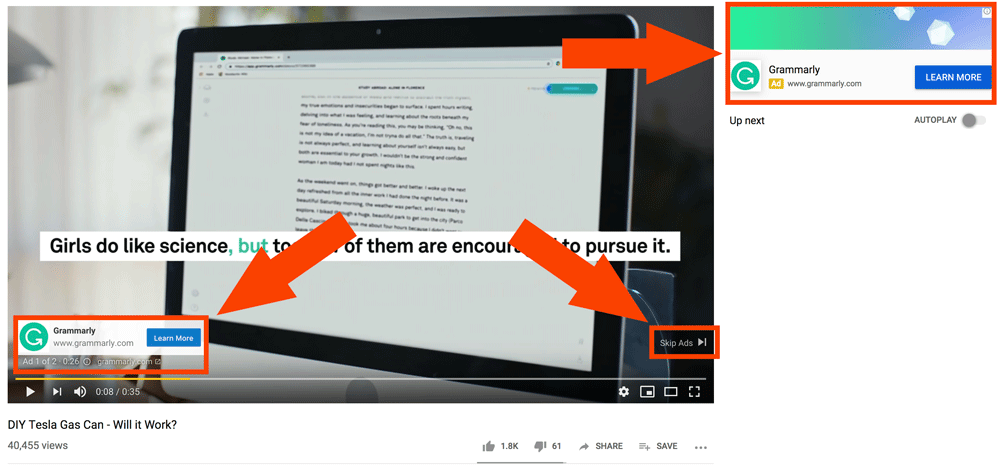
As people can ‘skip’ these In-Stream Ads after the first 5 seconds, you really need to make these first 5 seconds of your ad extremely engaging and captivating, to encourage them to keep watching.
However, you also want to repel the wrong people from watching your ad, as you only want to pay for views of your ad by people who have got a good chance of becoming a customer further down the line.
But if you know your ideal customer well, you’ll be able to reduce wasted ad spend considerably when you set up your targeting.
Skippable In-Stream Ad Requirements
- Duration : 12secs (minimum) – 3 minutes (maximum)
- Where They Appear : Before, during and after ‘monetized’ YouTube videos
- Call-To-Action Button : 10 Characters (maximum)
- Companion Banner (displayed on right-hand side of video): Auto-Generated from video or Custom Design 300 x 60 (pixels)
- When You’re Charged: At 30 seconds (full duration if shorter than 30 seconds), or when Call-To-Action is clicked
Again, these are the ads that play before monetized videos on YouTube, but the difference is that they can’t be skipped after 5 seconds. Viewers have to watch the entire ad before they can watch the video that they came to watch in the first place.
So, understandably, these ads are the least liked by YouTube users. You also can’t add a Call-To-Action button. The only way that people can actually take action from the ad and visit your website, is to click on the small website address text in the bottom left hand corner of the video (shown in the image below), or through a Companion Banner, as with the ‘Skippable In-Stream Ads’.
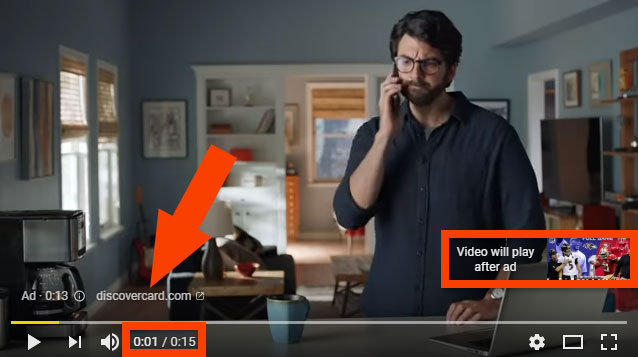
Unskippable In-Stream Ad Requirements
- Duration : 7 secs (minimum) – 15secs (maximum)
- Call-To-Action Button : None (apart from website URL in the bottom left of the video)
- Companion Banner (displayed on right hand side of video): Auto Generated from video or Custom Design 300 x 60 (pixels)
- When You’re Charged: Per 1000 impressions (CPM)
Best used for brand awareness, Bumper Ads are 6 second (maximum) video ads that play before monetized videos on YouTube. They don’t have any Call-To-Action aside from a Companion Banner and the on-screen website URL of the advertiser.
As I mentioned above, Bumper Ads perform best when used for Brand Awareness and keeping your Travel Brand front-of-mind for your potential customers. So we tend to use Bumper Ads as part of a larger YouTube Ads campaign strategy.
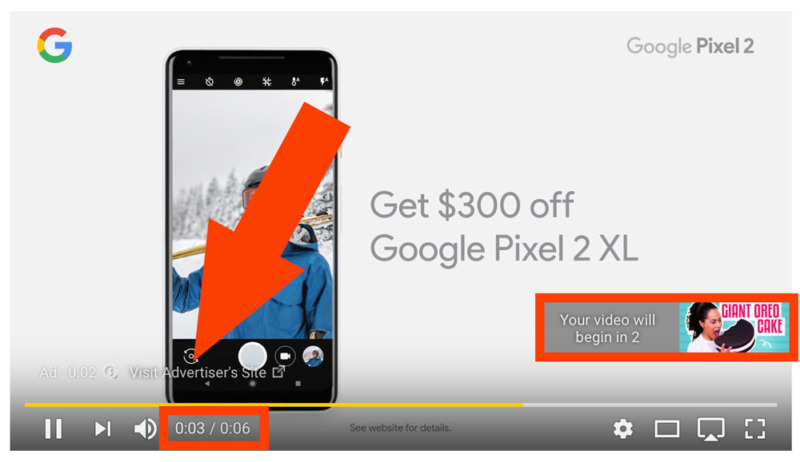
Bumper Ads Requirements
- Duration : Up to 6 secs (maximum)
Video Discovery Ads are slightly different to all the other ad formats we’ve been through so far, because typically, these are more ‘Content’ videos (videos with titles such as, “how to market my tours company”, “how to generate more direct bookings”, etc.), that you put some money behind to ‘push’ them in front of your ideal customers, rather than wait for the YouTube algorithm to rank your videos based on various different factors, such as title, description, tags, engagement, etc., which is the route that the majority of YouTube Creators take.
When setting up a Video Discovery Ads campaign, you still have access to all the targeting tools that we’ve discussed in this guide.
So Video Discovery Ads can appear in a number of different places across the YouTube platform:
- YouTube App Feed (Mobile Only)
- YouTube Search Results (as highlighted in the image below)
- Suggested Videos (videos down the right hand side on a video watch page)
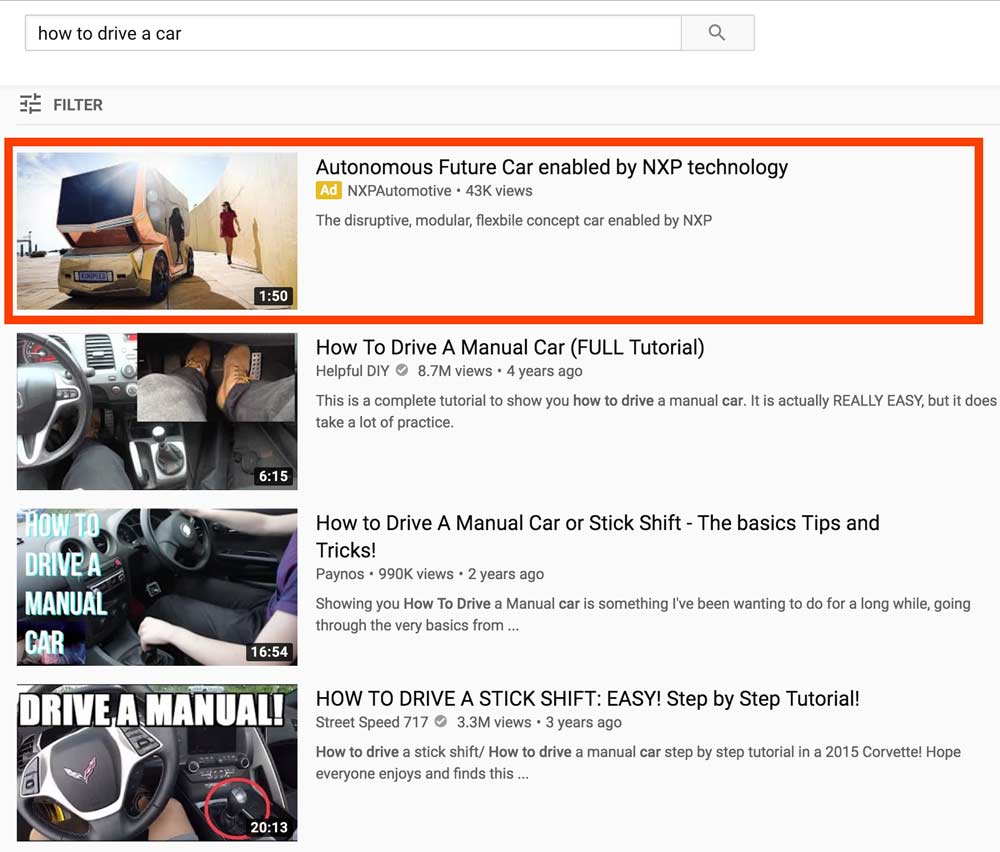
There are a few things to bear in mind with Video Discovery Ads, that make them slightly different from all the other Ad Formats that we’ve discussed in this guide so far, the main one being that you are charged when someone actually clicks on your Video Discovery Ad from any of the places listed above. You are NOT charged for impressions.
Video Discovery Ads Requirements:
- Duration : Minimum of 12 seconds (no maximum)
- Where They Appear : YouTube App Feed, Search Results and Suggested Videos
- Call-To-Action Button : None
- Companion Banner: None
- When You’re Charged: Per Click (CPC)
Wow! Got all that? Still here? Great! Let’s move onto actually setting up your first YouTube Ads Campaign. Exciting!
The first thing you’ll need to do to set up a YouTube Ads Campaign is to create a Google Ads Account if you don’t already have one.
If you do have one, cool, move on. If not, head on over to https://ads.google.com and just follow the on-screen instructions to get everything in place.
You’ll also need a YouTube Channel setup in order to run YouTube Ads. If you already have a Youtube Channel for your business, just double check that it’s setup as a ‘ Brand Account ‘, rather than a personal account, as this will allow you a few more options than a personal account, such as multiple managers, but you’ll still be able to access a Brand Account through your personal account/channel.
If you don’t have a YouTube Channel, just head on over to YouTube.com and because you’ve already setup a Google Ads Account, you’ll be able to use the same login details to create your new Youtube Channel.
All sorted? Great, let’s move on…
Linking Your Google Ads Account and Your YouTube Channel
This is a crucial step to really get the most out of YouTube Ads, as you’ll be able to access so many more targeting, measurement and analytics tools, than if you don’t link your Google Ads Account and YouTube Channel together.
To do this, once you’re inside your Google Ads Account, head on up to the spanner/wrench icon in the menu bar at the top right of your screen and click ‘ Linked Accounts ‘ (as shown in the image below).
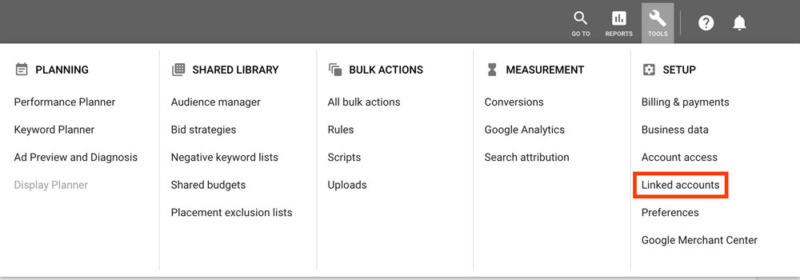
On the next screen, scroll down till you see the ‘YouTube’ section and click on ‘Details’ (as shown below)
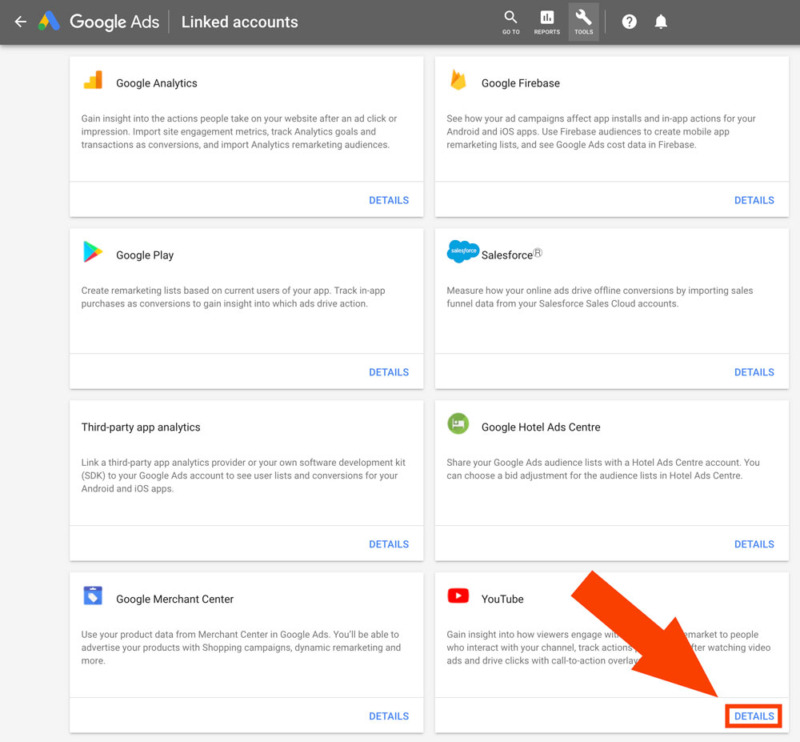
Now click on the ‘Add Channel’ button.
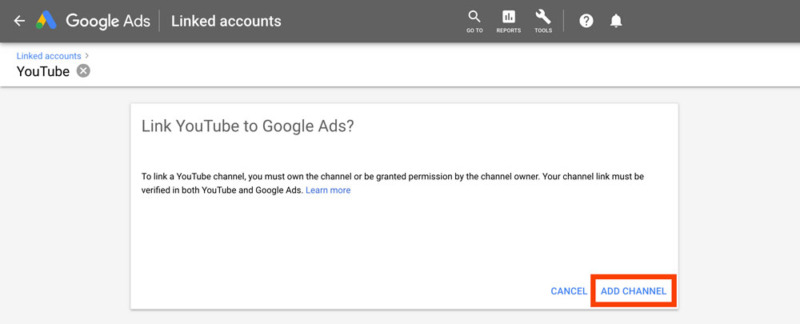
Then either type your YouTube Channel name into the box that pops up (as shown below), or copy and paste your Youtube Channel URL.
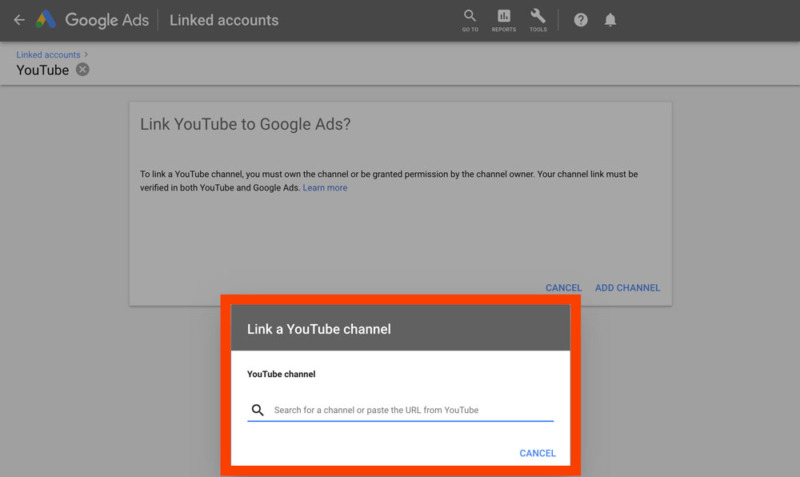
Once you’ve searched for your Channel or copy and pasted the URL, select from the appropriate channel ownership options and then click ‘Go To YouTube’, to finish off the linking process.
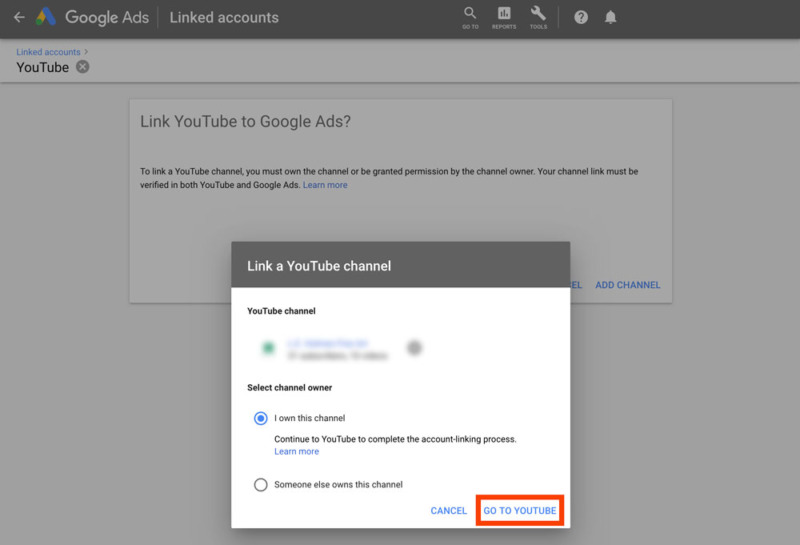
To finish the linking process between your Google Ads Account and YouTube Channel, you’ll need to be logged into the required YouTube Channel on the same internet browser.
When you see the box below, just give the link a name, make sure all 3 options are ticked from the selection of ‘View Counts’, ‘Remarketing’ and ‘Engagement’ and then click the ‘Link’ button.
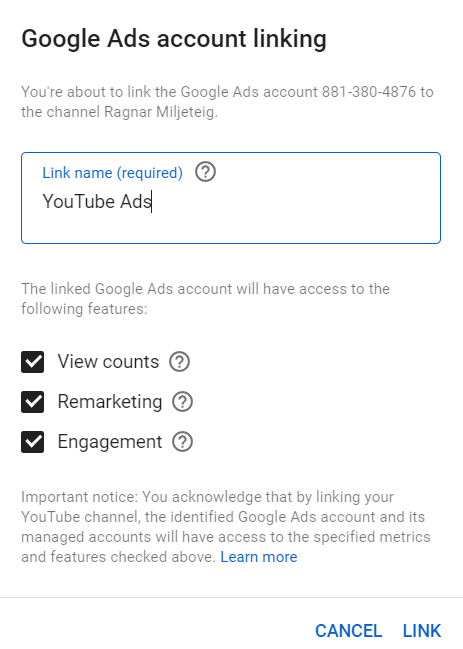
And you’re all set; ready to launch your first YouTube Ads Campaign, which we’ll dive into right now!
Campaign Structure
Before we jump into the Google Ads platform again to build out your first YouTube Ads Campaign, I wanted to briefly cover the ‘Account Structure’ of your campaign. The diagram below gives you a high level, 30,000-foot view of how everything works and links together.
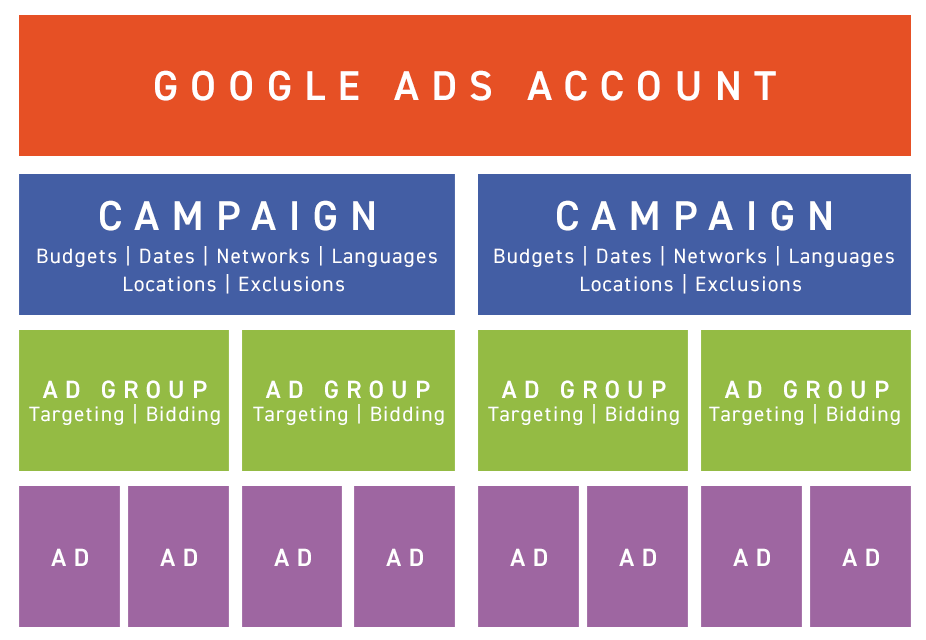
Based on the above diagram, the best advice I can give you when you’re thinking about your YouTube Ads Campaigns is this…
Use 1 Targeting Option Per Campaign
Don’t ‘layer’ lots of different targeting options on top of one another in one Campaign; especially when you’re just starting out.
When you set your YouTube Ads Account up this way, you’ll also be able to control the amount of budget per Campaign and therefore, per Targeting option, giving you a huge amount of control over how much you spend on your YouTube Ads, as you can see from the diagram below.
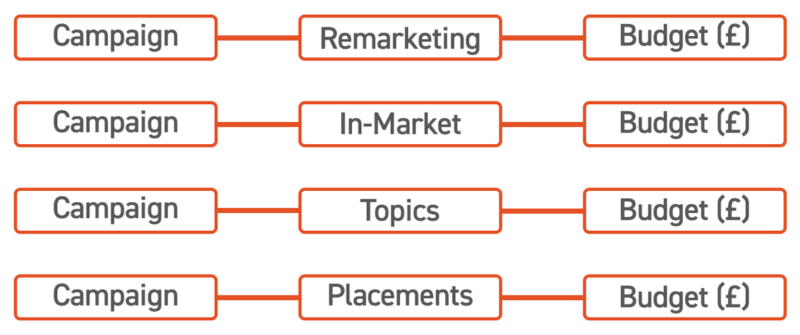
It can be tempting to add lots of targeting options into one Campaign. But if you do, then it’s very difficult to determine which targeting worked and which didn’t. Whereas, if you have just 1 targeting option per Campaign, you can quickly and easily see which targeting is working and which isn’t
Here’s a great quote/motto to remember when running YouTube Ads:
What gets measured, gets managed
Building Your Campaign in Google Ads
So, back on your Google Ads dashboard, to get started, click on the ‘Campaign’ option in the left hand menu, then click on the blue + button and choose ‘New Campaign’ from the menu that pops up.
Now choose an objective for your campaign by asking yourself, what do you want your campaign to achieve? You can choose from:
- Website Traffic
- Product and Brand Consideration
- Brand Awareness and Reach
- App Promotion
- Create a Campaign Without a Goal’s Guidance
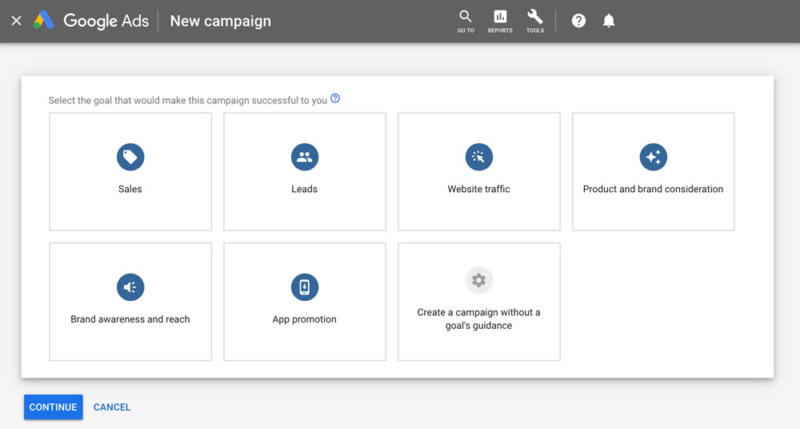
Once you’ve chosen your goal, you’ll need to choose a ‘Campaign Type’, which, for YouTube Ads, will need to be ‘Video’.
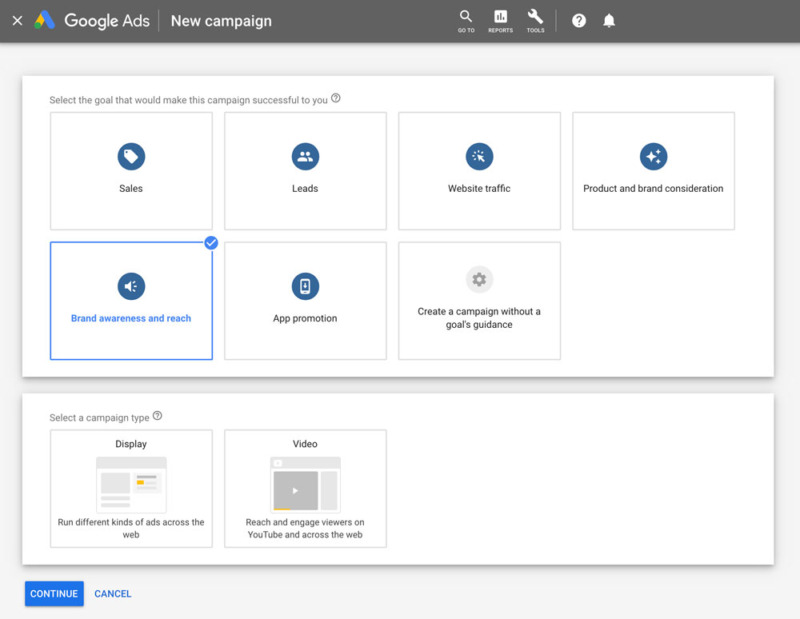
After choosing your goal and campaign type, you’ll need to select a ‘Campaign Sub-Type’, which will differ depending on the overall goal that you select. I’ve chosen ‘Brand Awareness and Reach’ for this example, which gives the option of the following:
- Skippable In-Stream
- Non-Skippable In-Stream
- Ad Sequence
You’ll most likely recognize some of the sub-goals from the Ad Formats section earlier in this guide! So for now, I’ll go ahead and choose ‘Skippable In-Stream’ and then click the blue ‘Continue’ button at the bottom of the screen.
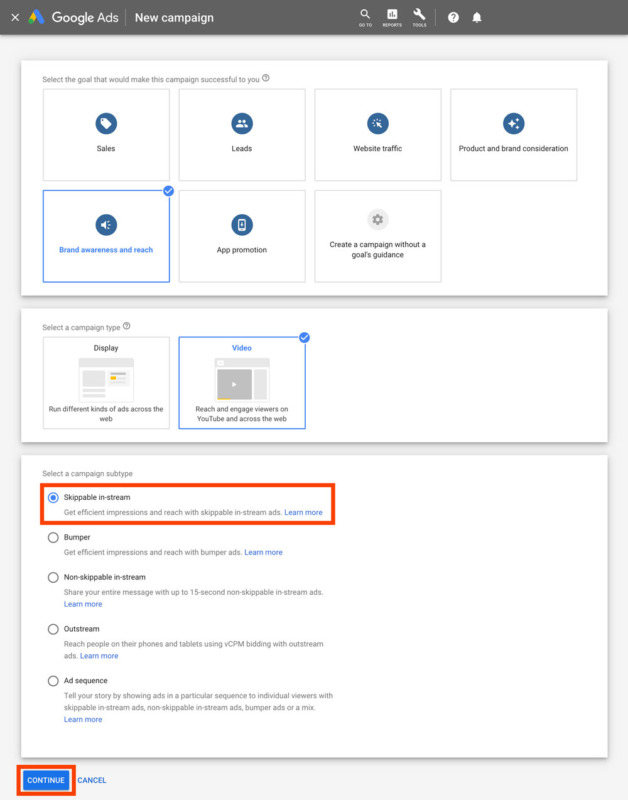
Campaign Name
The next screen you arrive on might seem a bit daunting, but don’t worry, I’m going to walk you through everything you need to know about setting up your YouTube Ads Campaign the right way.
So, the first thing you’ll want to do is name your Campaign. There are many different naming conventions you could use to name your campaign, but I typically use something along the lines of the following:
[PLATFORM] | [GOAL] | [DEVICE]
In practice, to add some context to this with an example, the above naming convention could be:
YT | Enquiries | Desktop
With ‘YT’ standing for ‘YouTube’, because within the Google Ads platform, you may also be running Google Search Ads and/or Google Display Ads. So by adding ‘YT’ to the beginning of the Campaign Name, easily differentiates between the different Campaigns you may have running at any one time.

There’s no right or wrong way to name your Campaigns; just make sure that it’s something that is recognizable to you and that you can quickly and easily determine the purpose, context and goal of each campaign.
As with any paid advertising, there is a certain amount of testing and optimization required, so once you have more than 10 campaigns on the go, it’s going to be hard to see the wood for the trees if all your campaigns are named something irrelevant or complicated!
Once you’ve decided on your Campaign Name, the next section to work on is ‘Budget’.
You can choose between:
- Campaign Total
- Daily Budget

So how do you know which option is right for you?
Here’s how we like to choose:
If you’re running a ‘burst campaign’ (a short term campaign that typically lasts no more than 4 weeks), then we always recommend using a ‘ Campaign Total ‘ budget.
If, however, you’re going to be running a campaign for the foreseeable future, almost like an evergreen campaign, then we recommend choosing the ‘ Daily Budget ‘ option.
You’ll also see a section just below the budget options, where you can select a start and end date.
Again, what you choose here will depend on the type of campaign that you’re running:
- Burst Campaign – set a start and end date
- Ongoing/Evergreen Campaign – DON’T select a start and end date
Bidding Strategy
I could go very deep on this topic! But for the purposes of this guide, a bidding strategy is essentially how you want Google/YouTube to optimize your ads for maximum impact and how you pay.
I’ve chosen to run a Brand Awareness and Reach Campaign, so the only Bidding Strategy available to me in this example is Target CPM , which means that I’ll set a target cost for Google/YouTube to optimize my campaign for, in order to receive 1000 impressions of my ad.

If, however, you chose a different campaign goal, you’d have access to different bidding strategies, such as Maximum CPV (Cost Per View), where you decide how much you’re prepared to pay for 1 person to watch your ad.

Now it’s time to decide where you want your ads to show on the YouTube platform.

Depending on the objective of your campaign and your campaign subtype, some of these options may be unavailable to you. So, typically, here’s how to choose which Networks to show your YouTube Ads on:
- YouTube Search Results – Video Discovery Ads
- YouTube Videos – In-Stream Ads (Skippable and Unskippable), Bumper Ads
- Video Partners on the Display Network – NEVER USE! (Selecting this option will use up the majority of your budget very quickly!)
This is pretty straightforward! Just choose the language that your ideal customers speak! Yep, it’s that simple!

Content Exclusions
Now you need to choose an Inventory Type, which is essentially a filter that lets your ads show on certain types of video content that YouTube Creators upload. The option you choose here is going to depend on how you want your brand to be perceived, as you might be ok with your ads showing on videos of an ‘evocative nature’, in which case, choose ‘ Expanded Inventory ‘.
Typically though, we choose ‘ Standard Inventory ‘, just to be on the safe side. And, to give credit to YouTube, they are getting much better at blocking ‘risque’ content on the platform.
But if you want to be really safe, just choose ‘ Limited Inventory ‘ from the options. Just bear in mind that the more you limit your inventory, the slightly more expensive it’s going to be to run your ads.

The next 2 options to define are ‘ Excluded Content ‘ and ‘ Excluded Types and Labels ‘.
The ‘ Inventory Type ‘ in the previous section tends to cover a lot of this. So we tend to leave ‘ Excluded Content ‘ as default. Also bear in mind that, at the time of writing this guide, the ‘Excluded Content’ options will soon be removed.
With the ‘ Excluded Types and Labels ‘ options, we tend to just tick the following options where we don’t want our ads to show:
- Embedded Videos
- Live Streaming Videos
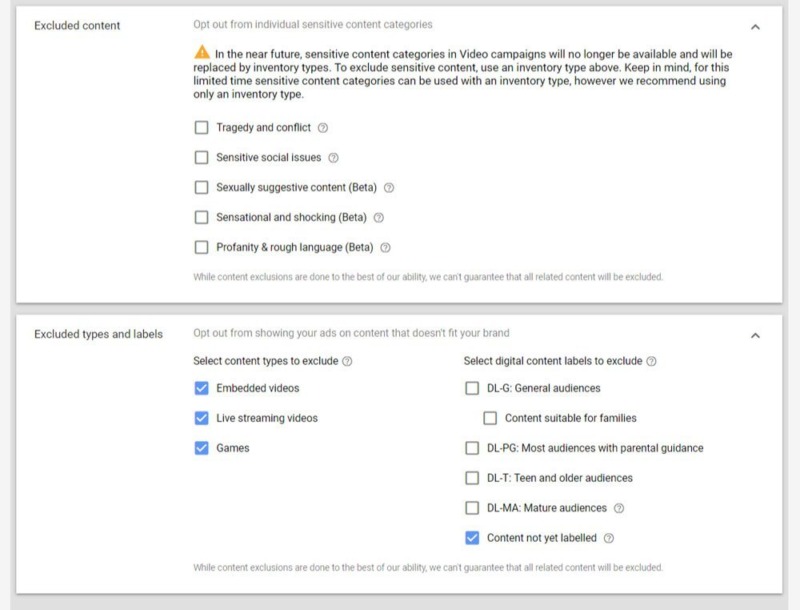
Additional Settings
There are some additional settings you can play around with, but when just starting a campaign, it’s best to cast a wide net, so we tend to leave these options alone with a first campaign.
Once we have some data after running campaigns for a few weeks, then we’ll come back into these additional settings and make some changes. But for now, you can leave these settings as default, unless you really feel that you need to male some adjustments to them.

Ad Group Name
Now it’s time to set up your Ad Group. So, as we covered a little earlier in this guide, the Ad Group is where you define your targeting. And when you’re naming your Ad Group’s, it’s best to include the targeting within the Ad Group name, to make things easier to manage; which is particularly important once you’ve got a good number of Ad Groups up and running.
Again, there’s no right or wrong Ad Group naming conventions, but here’s the format we like to use:
[OFFER] | [TARGETING TYPE] | [TARGETING DETAIL]
For example:
2 For 1 Offer Nov 2019 | In-Market | Hotels & Accommodation
Whatever naming convention you use, just make sure you name your Ad Groups in a way that means something to you.

People Targeting – Who You Want To Reach With Your Ads
The next step is to set up your ‘People’ targeting, which includes:
- Demographics

The Audiences targeting allows you to choose from a number of different audience types, based on Google’s data of its users. We covered this a little earlier in this guide, but to give you a refresher, here’s what you’re able to define with Audience targeting:
- Detailed Demographics (such as marital status, home ownership status and education)
- Affinity (interests and habits)
- In-Market and Life Events (people who are ready to make a purchase and life events such as graduation, marriage, etc.)
- Remarketing (people who have interacted with your business)
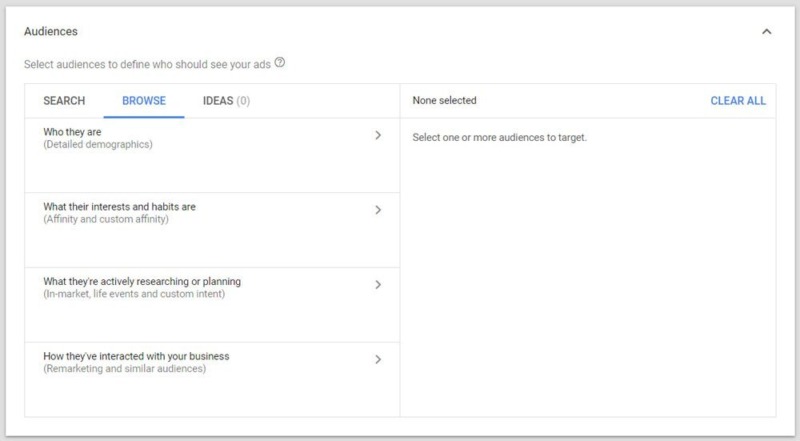
As I mentioned earlier in this guide, I’d recommend NOT ‘layering’ People targeting (Demographics and Audiences) when you’re first getting started, because it’s really going to limit the potential of your YouTube Ads, as well as the data that you’re able to pull in, if you were to cast a wider net.
So, if you’re using People Targeting , you’re defining the people who you want to see your ads, no matter what content they’re watching.
But, with Content Targeting (the next targeting option), you’re actually targeting the content where your ads will show, no matter who the people are that are watching.
This does make it sound a bit like the Content Targeting is a waste of time! But, if you think about it, the people who are watching, for example, a video about ‘best places to visit in the Lake District’, you can be pretty sure that they’re going on holiday to the Lake District at some point in the near future. People who are going to China are unlikely going to be watching a video about places to visit in the Lake District!
So let’s now take another look at the Content Targeting options quickly, as we covered these earlier on in this guide. Content Targeting allows you to define where your ads show based on:

If you do decide to use Content Targeting , then we recommend just choosing ONE of these options per Campaign (Keywords, Topics or Placements), so as to give your ads the best possible chance of success. You can then refine the targeting later on once you’ve got some data.
Setting the bid for your Ad Group will differ depending on the goal of your Campaign, as well as the Campaign subtype that you’ve selected. For the example in this guide, I’m using a Brand Awareness and Reach Campaign, so the only bidding option I’m able to use is Target CPM (Cost Per Thousand Impressions).

Regarding how much you should set your bids for, whichever type of Campaign you’re running, will very much depend on several factors, such as your ACV (Average Cart Value), your LTV (Lifetime Value), CR (Conversion Rate – how many people you convert from a lead/enquirer into a paying customer).
If you’re running a different Campaign Type and Subtype, you might be able to set your bidding based on how much you’re prepared to pay for a single view of your YouTube Ad.

Once you know these sorts of metrics, and you know how much you’re able to pay to acquire a new customer/booking (and still be profitable), then you can input this data into your Campaign and the algorithm will optimize your Campaign to meet these figures so that you stay profitable.
To give you some figures to get you started though, if you’re running a Campaign that allows you to set a Maximum CPV, then I’d recommend setting this CPV bid to somewhere between £0.10 – £0.20 to begin with. Then once you have some data and analytics after the Campaign has been running for a few days, you can adjust this CPV bid down to better match the results you’re getting. We tend to see CPV’s of between £0.02 and £0.10.
Create Your Video Ad
Here comes the exciting part – creating your YouTube Ad itself!
So the first thing you want to do is make sure your video ad is uploaded onto your YouTube Channel as ‘Unlisted’. Then simply copy and paste the URL of the video into the search bar under the ‘Create Your Ad’ section.
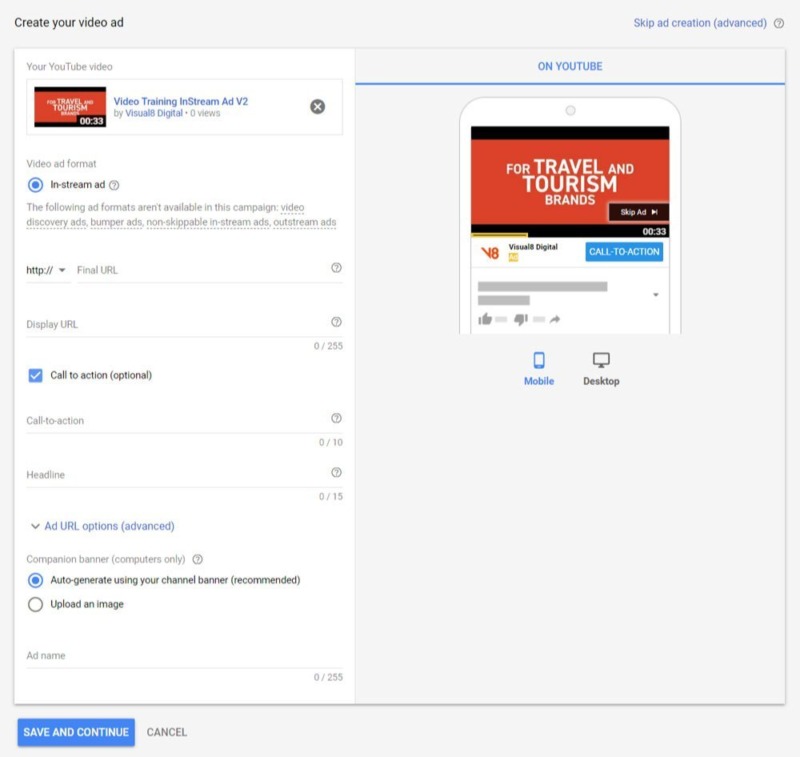
The options you see when you’re setting up your Campaign may differ to screenshot above, because, again, it will depend on your Campaign and Campaign Subtype settings.
But let’s go through the options in the above screenshot, which are available for most Campaigns and Campaign Subtypes, to give you a better idea of how to set your first YouTube Ad up:
- Video Ad Format – the options you see here will depend on the type of Campaign you’re setting up
- Final URL – this is the actual URL people will arrive on when they click on a CTA (Call-To-Action) in your YouTube Ad
- Display URL – this is the URL that viewers of your YouTube Ad will actually see, so make your Display URL look as pretty as you can!
- Call-To-Action – this is optional on some campaigns. You have 10 characters to use, such as BOOK NOW or LEARN MORE
- Headline – this should promote your offer; it appears below your YouTube Ad on mobiles and within the ad itself on desktop computers
- Companion Banner – this is a graphic with a CTA and again, promotes your offer, but stays visible to the viewers even if they skip your ad. You can choose to have an auto-generated Companion Banner, or if there’s something specific that you want to show in your banner, then you can create your own; just make sure that its dimensions are 300 x 60 pixels.
As you build out your YouTube Ad, you’ll see a preview of what it’s looking like on the right hand side of your screen, both on mobile and desktop devices, so you can be confident that you’re happy with how your ad looks before you launch it.
The final thing you need to do is name your Ad. As with all the naming conventions we’ve gone through in this guide, there are no hard and fast rules; just make it clear to you, so that you understand the content of the Campaign, Ad Group and Ad.
For your Ads, I recommend using the following naming convention, but feel free to name it in a way that works for you:
[OFFER IN AD] | [VERSION] | [ANGLE/DESCRIPTION]
So, for example:
2 For 1 Nov 2019 Offer | Ver1 | With Voiceover
And you’re done! Just give all the settings of your Campaign a check over to make sure you’re happy with everything. Then click on the blue ‘ Save and Continue ‘ button at the bottom of the screen.
Phew! So, you’ve got your first YouTube Ad up and running. Now for something super important about running profitable YouTube Ads Campaigns…
I call this the Secret Sauce…
When you’re running YouTube Ads, the ‘Secret Sauce’ to success isn’t some fancy targeting strategy, or campaign objective, although, as you’ve witnessed throughout this Ultimate Guide, these things do make a massive difference to your results.
The ‘Secret Sauce’ to successful running profitable YouTube Ads is actually MINDSET.
I call it the ‘Always Win, Never Lose Mindset’.
Whenever you run YouTube Ads, you either SUCCEED by reaching your ideal customers with a message that resonates with them and turns them into either a lead or a customer…
You gain AD INTELLIGENCE, which will help you WIN more going forwards.
You need to ‘miss the mark’ a few times to see what works and what doesn’t work. If you win, GREAT. if you lose, GREAT – you’ve still won, because you’ve gained AD INTELLIGENCE.
And once you can see what’s working, you can dial in on this targeting, creative, messaging, etc. and start to scale up your Campaigns.
To really drive this Secret Sauce home for you, let’s use an analogy of firing arrows at a target.
The reason some YouTube Ads don’t work is because they throw one huge, gigantic arrow at a target. And unfortunately, 9 times out of 10, this doesn’t produce profitable or meaningful results. And definitely no ROI.
Instead, if you want to win with YouTube Ads, you need to use the ‘Always Win, Never Lose Mindset’, throw lots of precision arrows at the target and not be afraid of missing a few times. When you have this mindset, you know that you’ll hit the bullseye.
As Thomas Jefferson once said:
“ Nothing can stop the man with the right mental attitude from achieving his goal; nothing on earth can help the man with the wrong mental attitude. “ – Thomas Jefferson
And there you have it! That’s complete the YouTube Ads Ultimate Guide For Travel Marketers.
As with any paid advertising campaign, you can very easily waste a lot of money if you don’t know what you’re doing, targeting the wrong audience, setting the wrong objectives and most importantly, not knowing your metrics and your numbers.
You’ll also need to bear in mind that YouTube Ads requires on-going testing and optimization. You can’t just create one YouTube Ad, launch it and expect to hit a home run right out of the gate.
When you launch your first YouTube Ads Campaign, let it run for at least 7-14 days before you make any amendments to it. Allow your Campaign to collect some data, then analyze the data, and optimize targeting, bidding, etc. based on your results.
You might also like:
- How to Market a Tour Company for Free: 7 Big Platforms You Should be on
- 10 Ways to Promote Your Tours for Maximum Sales
- 8 Underestimated Tactics for Successful Tour Marketing
- Marketing Mix for Tour and Activity Operators
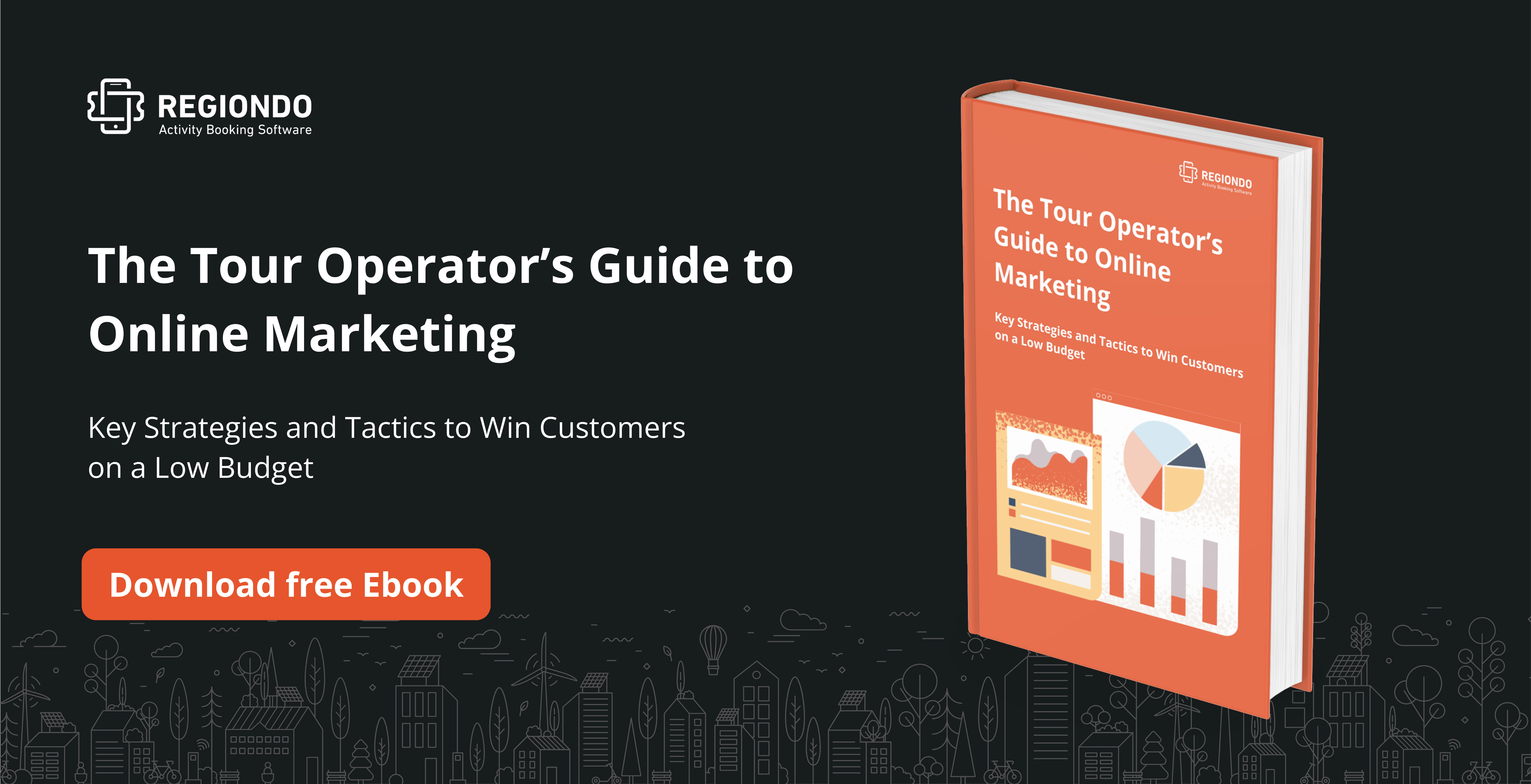
Related Articles

- Tips & tricks

Stay updated with Regiondo by signing up for our Newsletter

Get a personalized demo or create your free account now
Take your business to the next level with Regiondo - it's free to get started and you don't need a credit card.
How to Search for SEO Keywords for Travel and Tourism

At a time when remote working and digital nomadism are the order of the day, the travel and tourism industry is expected to show new heights of growth in the coming years. But to get a sizable piece of that cake, you must know how to curate a top travel keywords list for your content strategy.
Building your content strategy around travel SEO keywords has several benefits:
- It makes your content appealing to search engines
- It guarantees that you’re solving actual problems for people
- It helps attract your target audience
Within the next few minutes, I will describe several easy-to-use automation tools for finding the best-performing travel keywords and boosting the SEO visibility of your tourism website.
In this step-by-step guide , you’ll learn:
- How to find top-notch travel SEO keywords for meta tags
- How to curate a travel-related keywords list for your site pages
- How to find SEO keywords for travel blog posts
- How to select the MOST SEARCHED travel keywords on Google
By the end of this guide, you’ll have a database of travel agency keywords to use in your SEO strategy that looks like this:
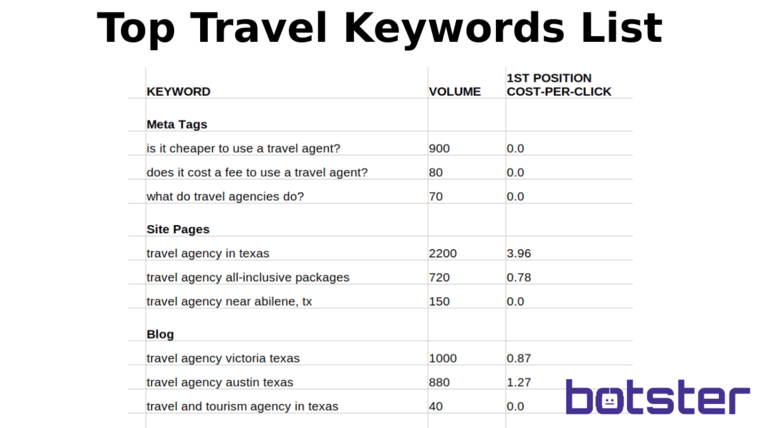
Without further ado, let’s get started!
Where to FIND travel keywords for SEO
Finding top-notch travel seo keywords for meta tags.
What are meta titles and meta descriptions?
Meta titles and descriptions are elements that summarize the content of a web page. They are displayed in the search engine results pages (SERPs) and help users decide whether to click on a link or not.
Here's a breakdown of each:
Meta title:
- This is a concise, descriptive title displayed as the clickable headline for your page in search engine results pages (SERPs). The best SEO travel keywords to use in titles are often problem-solving.
- It should be no longer than 70 characters to avoid truncation by search engines. Keep it short and straightforward.
- SEO keywords for travel relevant to your page's content should be included, as they can help search engines understand what your page is about and potentially improve your ranking for those keywords.
- Think of it as a mini-ad for your page. Aim to accurately summarize its content and entice users to click.
Meta description:
- This is a brief summary of your page's content, typically displayed beneath the title in SERPs.
- It should be around 155-160 characters to ensure full display.
- A compelling meta description can significantly impact your click-through rate (CTR) by telling users what they can expect to see on your page and highlighting its value proposition.
- Include some target keywords for travel websites, but prioritize clarity and entice users to click.
Why is it important to enrich meta tags with travel-related keywords?
If you enrich meta titles and descriptions with travel-related keywords, they can help search engines decide that your page is a good resource to display to searchers, thereby increasing your web traffic.
The first automation tool I’ll be introducing in this guide is the Meta Tags Extractor . This tool can help export meta tags and other important SEO parameters from competitors’ websites.
To gain access to the Meta Tags Extractor , you must first create a FREE Botster account :

Once your account is registered, follow the steps below to export travel keywords for SEO using the Meta Tags Extractor :
- Launch the Meta Tags Extractor by clicking on “Start bot”:

- Give the job a name to make it unique and specify a folder. (I’ll name mine “Texas travel keywords list” ):
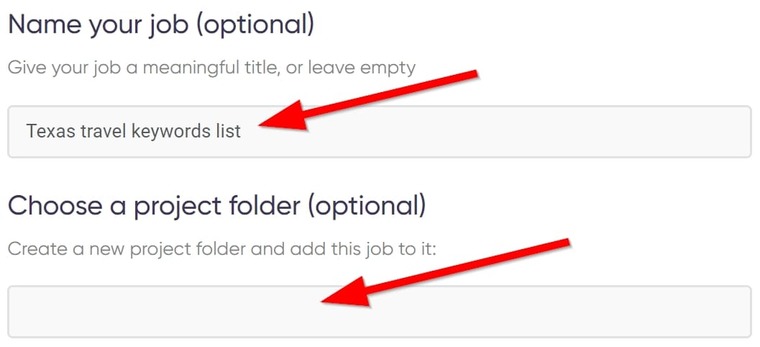
- In the field titled “Your data”, paste the websites of other travel agencies in your location to find top travel keywords in their meta tags.
💡 Life hack : You can find competitor websites using the Google Local Business Finder .
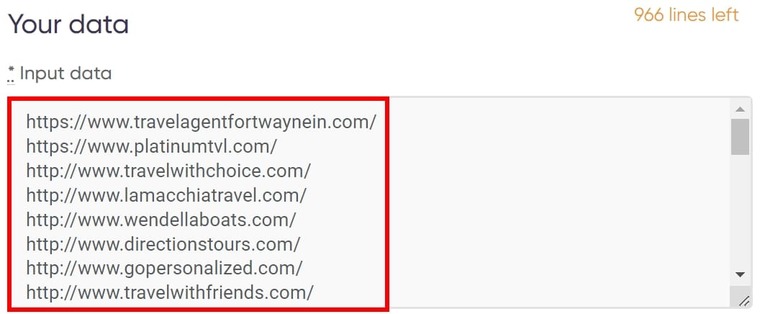
- Set up your notification options, making sure you tick “Attach results to the notification email”:
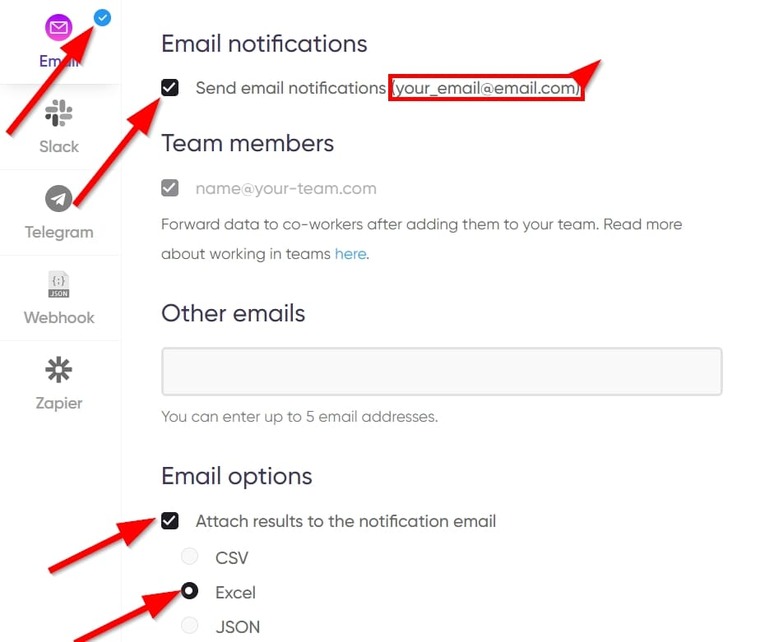
- Finally, click on “Start this bot” and you’re done! Easy peasy!

Once the Meta Tags Extractor is done, you will receive an email notification:
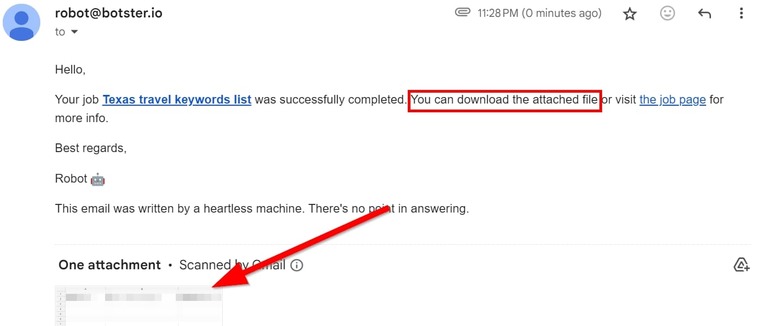
Below are some tips to help you make the most of the extracted data:
- Fetch the search volume of the extracted keywords using the Search Volume and CPC Finder as described below.
- Use the keywords with the highest search volume in meta titles.
- Use the keywords with somewhat lower search volume in meta descriptions.
Making up a travel related keywords list for your site pages
Why is it important to enrich site pages with travel SEO keywords?
Using relevant and well-researched keywords in your pages can help match your content with the search intent of your target audience. This can in turn increase both the quality and quantity of your website traffic, as well as your brand exposure.
The best keywords for travel agency sites are the ones searchers use to find whatever info they are looking for. So if someone searches “Is it expensive to go through a travel agent?” , using that term in your content can help you rank high.
That is why in this step, we’ll be extracting the most searched travel keywords with the help of the Google Search Suggestions Scraper . This bot can help extract search suggestions from Google, Bing, Yahoo, and YouTube.
Search suggestions are auto-complete search terms that pop up when you start to type in your search phrase into search engines:
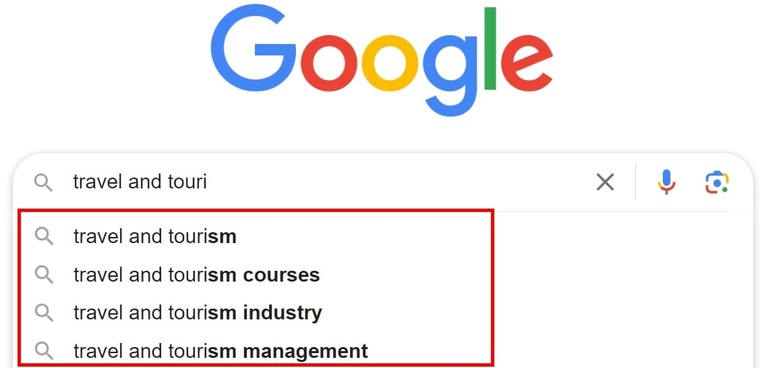
Setting up the Google Search Suggestions Scraper is quite straightforward. The steps are outlined below:
- Launch the Google Search Suggestions Scraper's start page and name your job. I’ll name this one “Texas travel keyword search suggestions” .
- Next, select your desired target region and language. I'm still looking for keywords for travel agency sites in Texas:

- Select the search methods you want the tool to adopt:

- Next, set a desired search depth:

- Now, select other search engines if you would love to extract their data too:

- Next, input your keywords. You can input multiple keywords but each one must go on a new line:
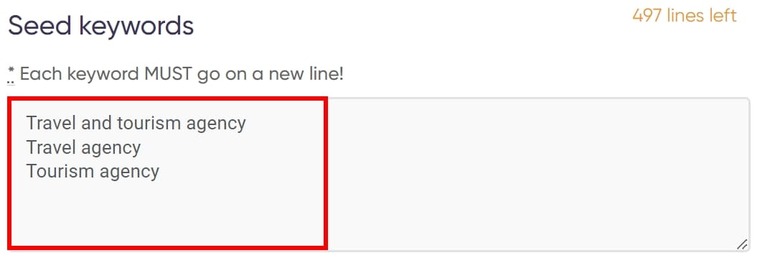
- Set your notification options, then click on “Start this bot” to launch the tool into action. This also launches the “My jobs” page to display something like this:
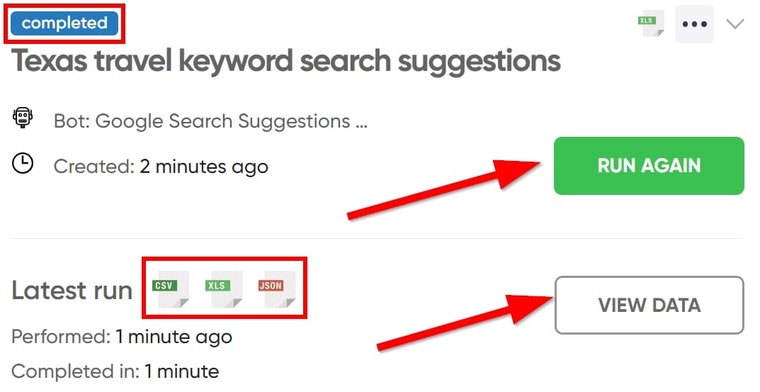
Video guide
Here’s a short video walkthrough of launching the Google Search Suggestions Scraper :
You can download the results extracted by the Google Search Suggestions Scraper by clicking on the XLS logo. Opening the file on your computer should display the top searched travel keywords thus:

- Carefully select and use these keywords in the texts on all of your site pages to make them SEO-optimized.
- Read my guide on the best Ahrefs alternative for more keyword research tips.
Finding SEO keywords for travel blog posts
Nearly every successful site has a blog. This is because the blog is an excellent way to attract site traffic and build authority in the industry.
Blogs are meant to solve problems for actual users, but if your posts are not enriched with SEO keywords for travel blogs, they won’t rank high on Google, and people won’t be able to find them.
One of the ways to find the perfect travel blog keywords is to check what exactly people are searching for online. For this, we’ll be using the Google People Also Ask and Related Searches Exporter .
Here’s how to set up the Google People Also Ask and Related Searches Exporter to scrape keywords for blogs on travel for you:
- Launch the tool's start page and name your job as we did earlier.
- Enter your search keywords into the field titled “Search queries”. You can use new keywords or copy and paste the results from the previous extraction:

- Next, select which snippet you wish to extract:

- Set your custom options as needed:
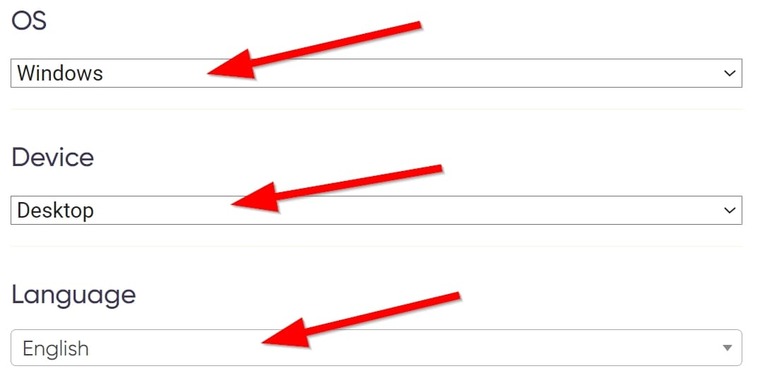
- Also, select your desired location for the search. Ideally, this should be the city or state you’re targeting. So mine is still Texas:
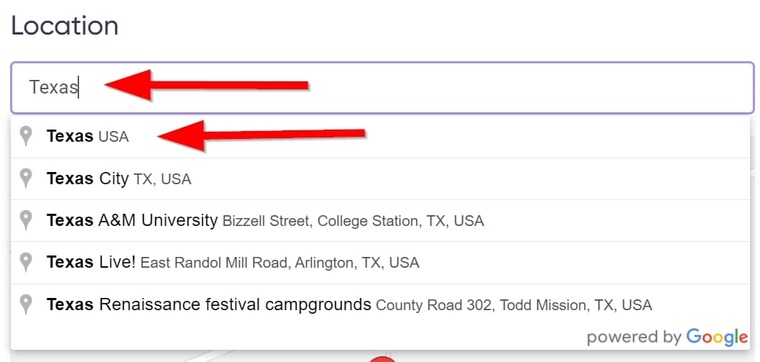
- Now you can start the bot and wait while it gathers your SEO keywords for travel agency sites.
Below is a video guide I made for this tool in case you’d like to watch me use it (I’m starting to speak about the Google People Also Ask and Related Searches Exporter at 07:19):
The results of this extraction should look similar to this:
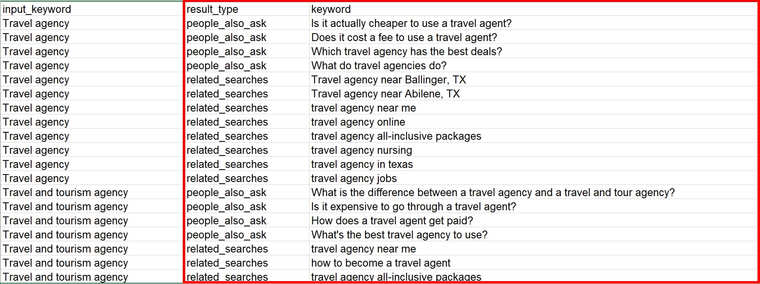
- The questions extracted from the “People also ask” widget are searched by actual people. So use them as blog topics (i.e. headings) to match your potential clients’ search intent.
- Use the keywords extracted from the “Related searches” widget randomly in the blog texts.
- Read my guide on lead generation for lawyers for more blogging tips.
How to single out the MOST SEARCHED travel keywords on Google
One final thing we have to do now is to pick the keywords with the highest search volume for use in our SEO strategy. The best keywords for travel blog posts are those with a high search volume but low competition.
Travel blog SEO keywords having high volume means they are regularly searched on Google. Having low competition means there’s little competitive effort over them.
Using the best travel keywords with high search volume and low CPC in SEO and advertising can grow your brand awareness as well as your customer base faster than you’d imagine.
For this step, we’ll be using the Search Volume and CPC Finder . This tool can fetch cost per click (CPC) and search volume data for keywords on Google in bulk.
Setting up the Search Volume and CPC Finder involves just one step, meaning that it won’t take you up to 10 seconds to get it over with:
- On the Search Volume and CPC Finder’s start page , paste all the keywords you’ve extracted so far into the field titled “Search keywords and phrases”:

- Now click on “Start this bot” and you’re done!
Watch a quick video tutorial on how to use the Search Volume and CPC Finder :
Once the bot is done running, you can download the results file and open it on your computer. You can also separate the keywords into different groups where some go to the meta tags, some to website pages, and others within blogs:
- Sort the results in descending order by the column “Volume” .
- Remember that long-tail travel keywords (i.e. phrases that contain 4 words and more) match your clients’ search intent most precisely, meaning that their value for your site should not be underestimated despite lower search volume.
- Read my in-depth guide on ways to measure brand awareness where this bot is used for yet another purpose.
Free trial for the travel keyword search tools
Now that you’ve learned how to find the best keywords for travel websites using automation tools, you can boost your online presence with very little effort. At this point, though, you are probably wondering how much it will cost you to extract the top travel keywords list from Google using these tools.
Well, it will blow your mind to find that using all these tools combined costs less than buying a seat near the window on your flight to the Maldives and their benefits are even more enormous than I just showed you!
And because you took the time to read this guide and learn how to find keywords for travel blogger sites so you can rank your business higher on search engines, we are offering you a 7-day free trial that starts right after you open your Botster account .
This means that you gain unrestricted access to the dozens of tools available on Botster . So don't delay any further. Seize this opportunity right now and get started extracting keywords for your travel blog!
- Optimize Your YouTube Videos
Channel Keywords
Written by Brian Dean
What Are YouTube Channel Keywords?
YouTube channel keywords are terms that give YouTube information and context about your channel. Specifically, they help YouTube understand the type of content you produce and who your target audience is. Optimized Channel keywords can also increase the visibility of your channel on YouTube.
Why are Channel Keywords Important?
YouTube uses Channel Keywords, your Channel Description and the types of videos you produce to figure out your channel’s overall topic and category.
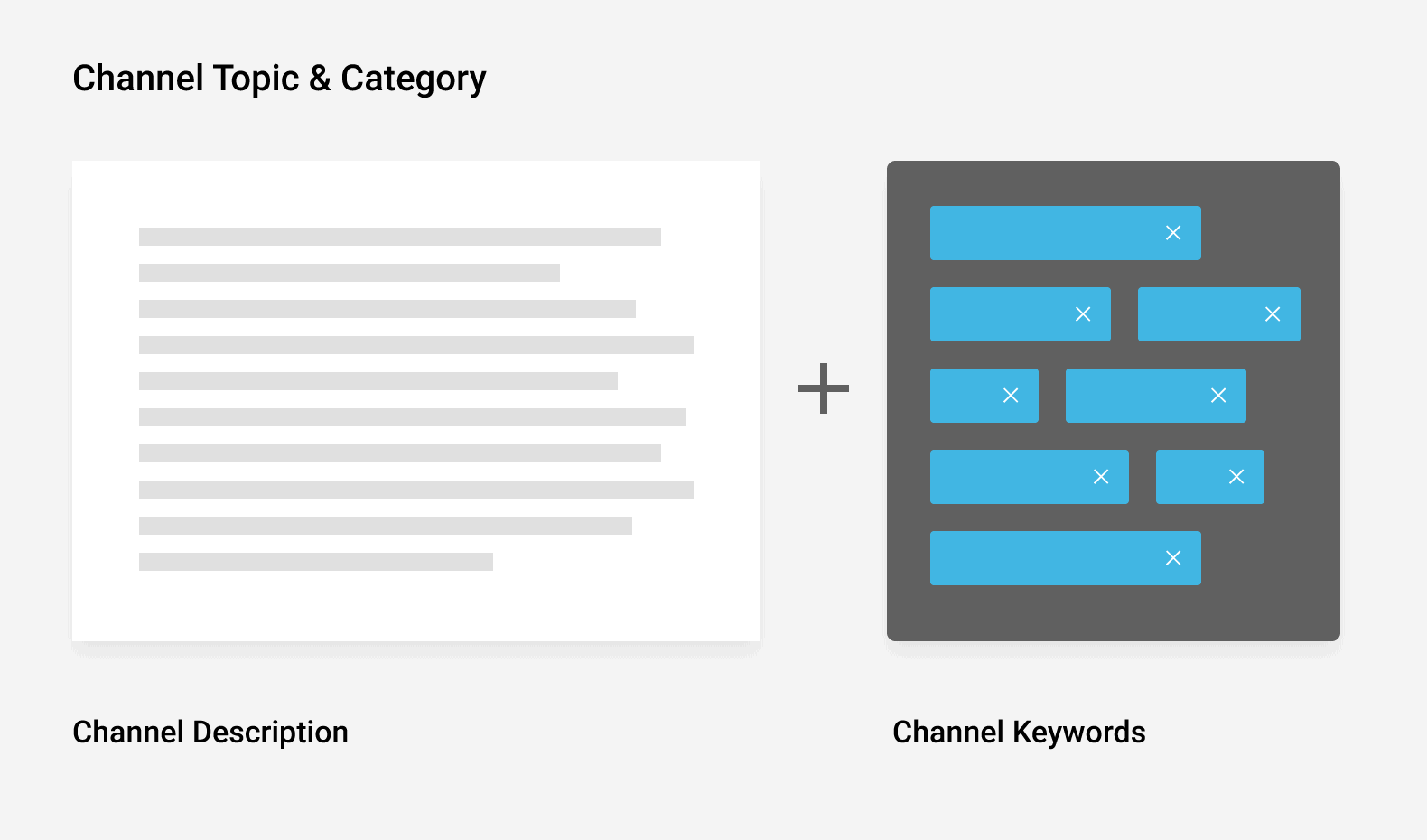
When you optimize your channel keywords the right way, you can boost the rankings of all the individual rankings on your channel.
In fact, a YouTube SEO ranking factors study discovered that channel keywords had a small-yet-significant correlation with higher YouTube search rankings:

Also, because channel keywords help YouTube understand what your channel is all about, they can help your channel rank for keywords that your audience searches for on YouTube:
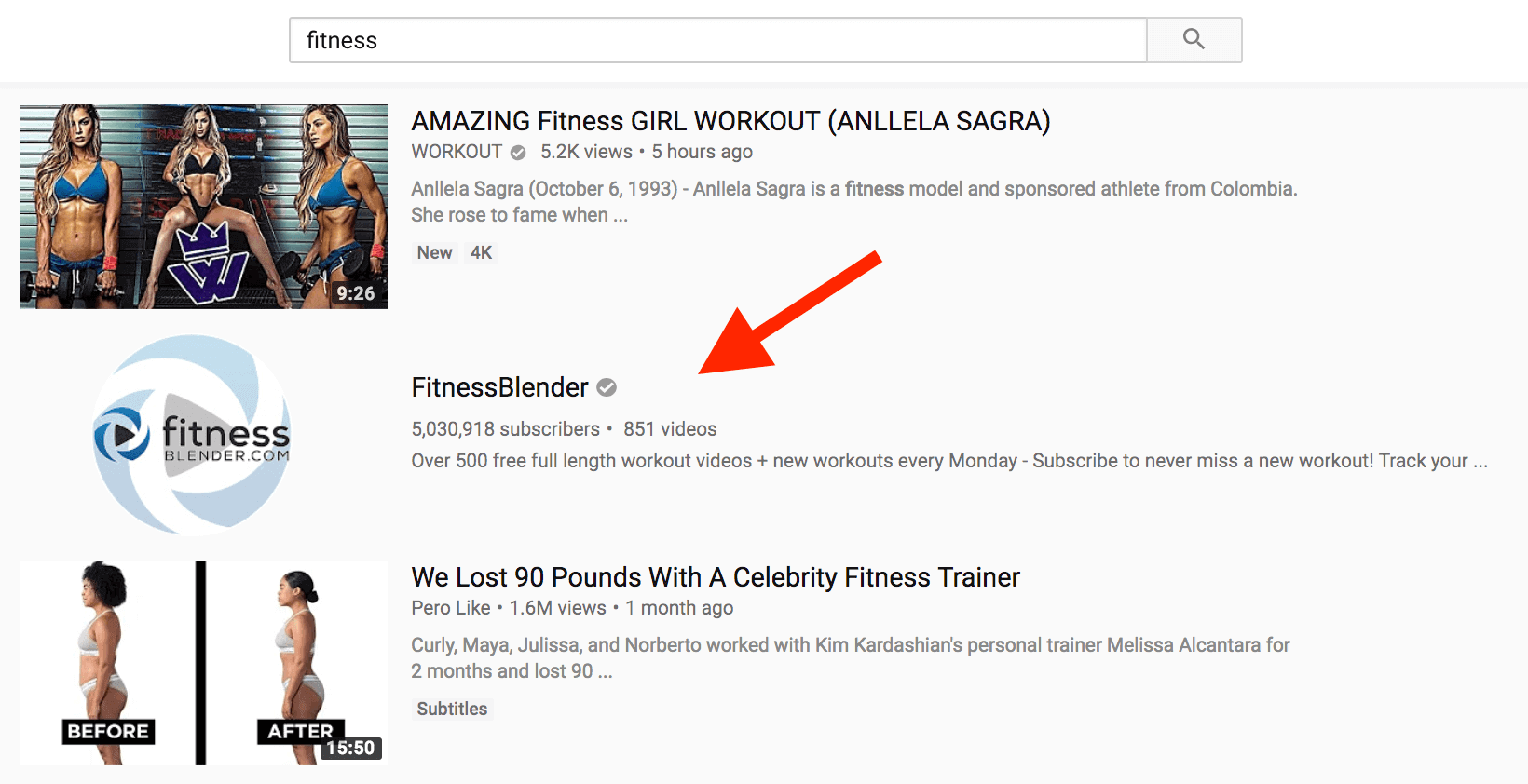
Last but not least, YouTube uses channel keywords to decide which videos they should promote in the Suggested Video column. You may have noticed that YouTube tends to recommend videos from related channels in this column:
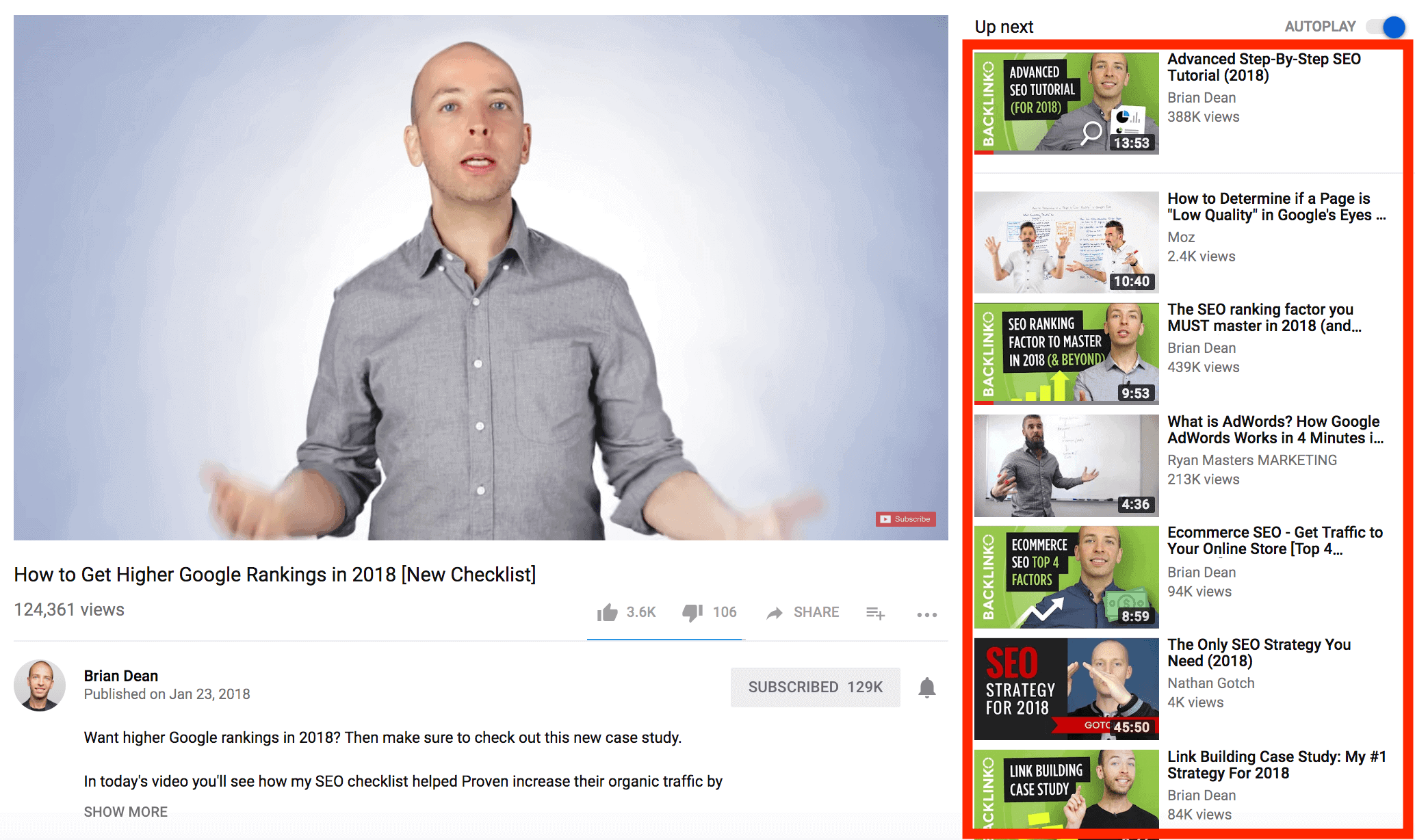
This is no coincidence.
In addition to promoting related content to the video you’re watching, YouTube also suggests content from similar channels here.
That’s why you’ll sometimes notice YouTube suggesting a video from a related channel… even though that video isn’t that closely related to the one you’re watching:
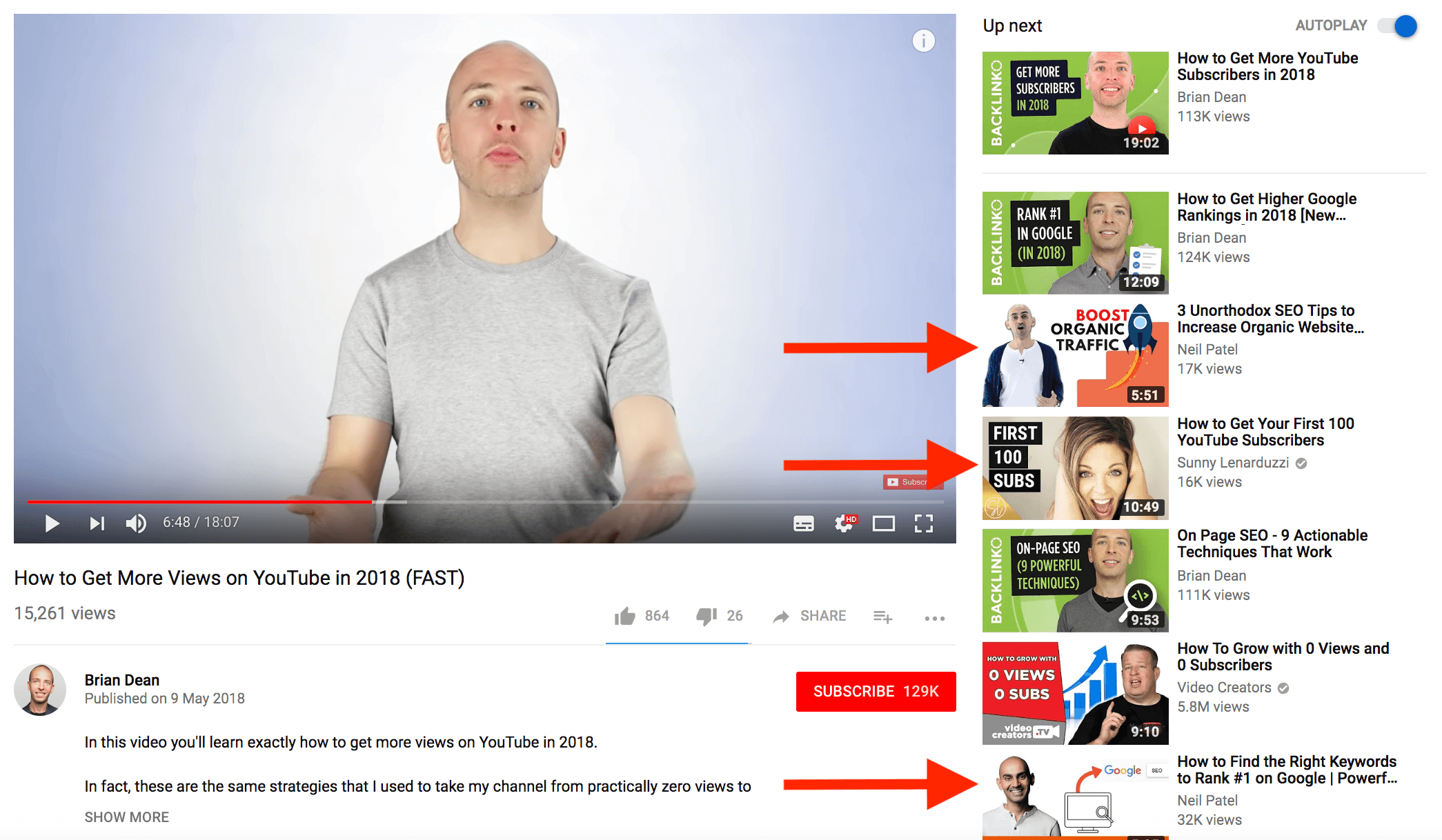
Best Practices
List Out Potential Channel Keywords
You first step is to identify words and phrases that describe your channel. These should be a mix of terms that you’re confident that describe your channel. And also a few popular keywords that you found from your video keyword research .
For example, let’s say you have a new channel about Italian cooking:
Off the top of your head you’d likely come up with channel keywords like:

Then, you’d want to add a few popular keywords that people use to find the type of content you create, like:

Unfortunately, YouTube’s channel keyword field isn’t easy to use:
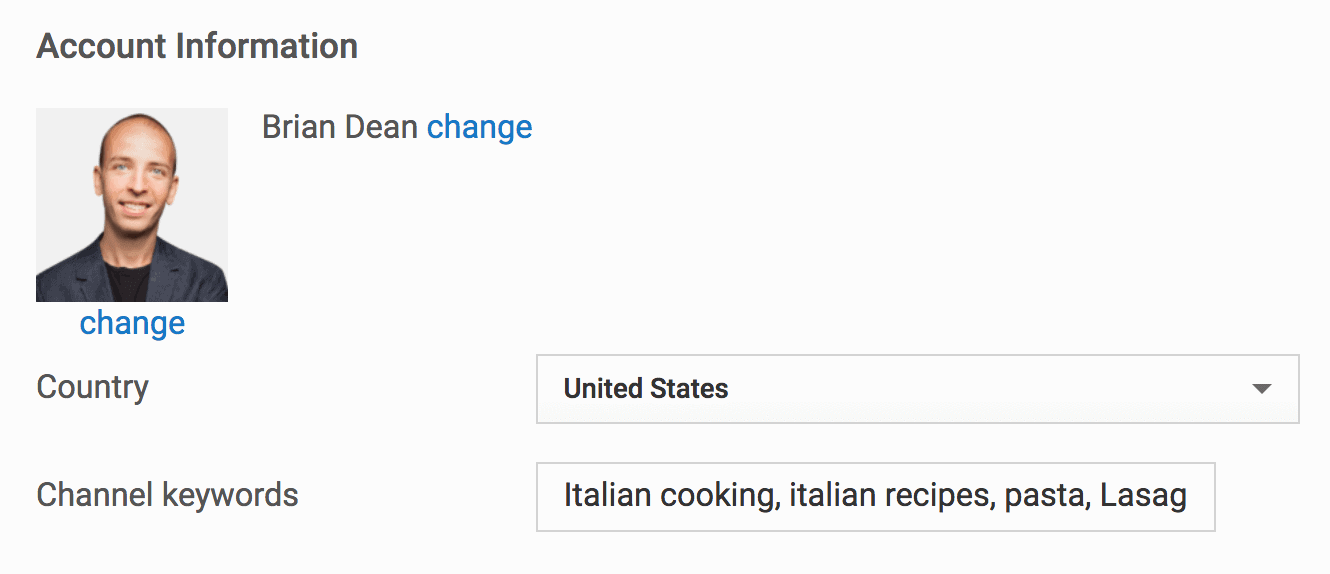
For easy editing, it’s best to list out your potential keywords in a Google Doc:
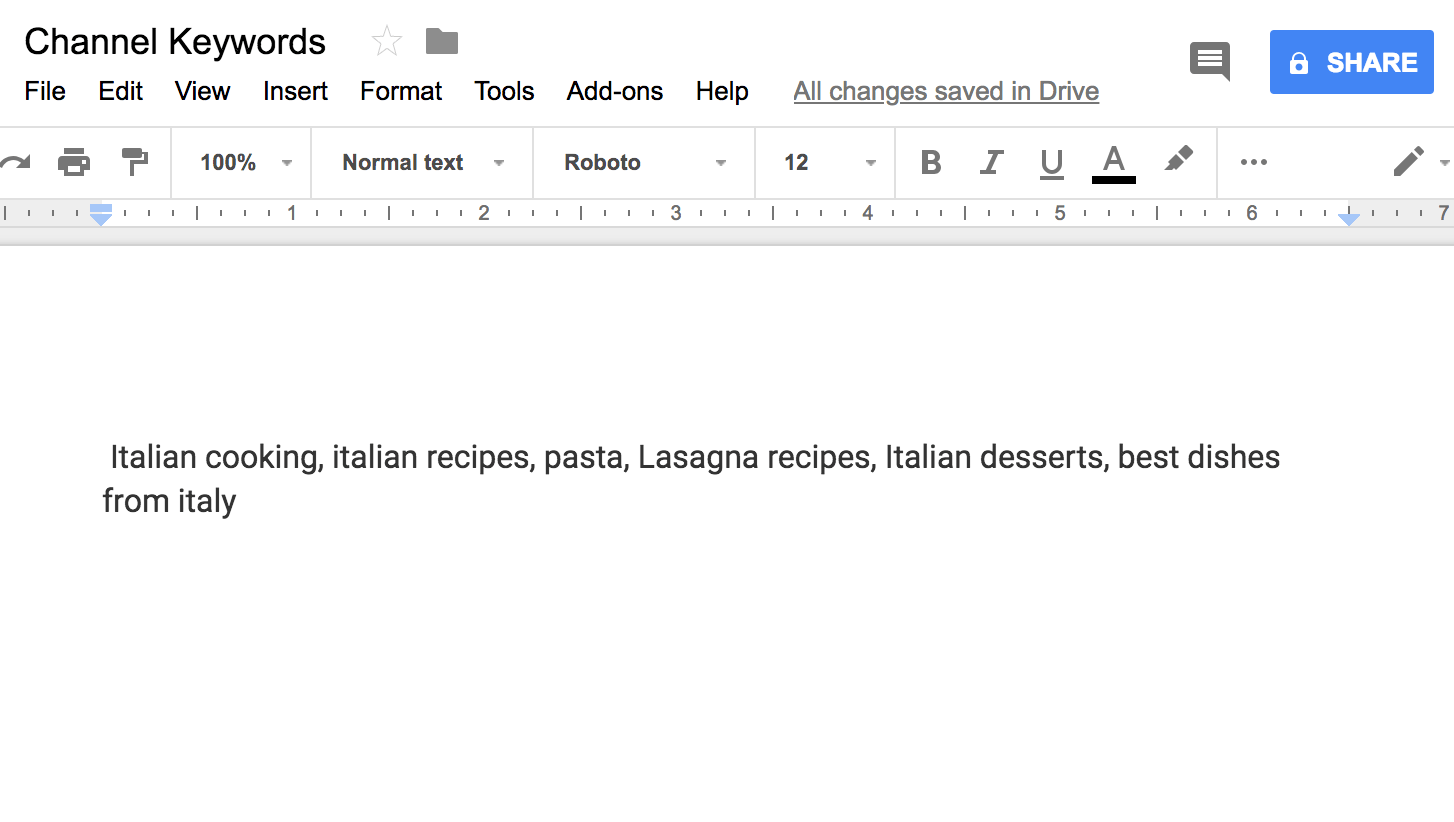
Use Approximately 7-10 Keywords
You want to cover the breadth of the topics you cover without going overboard.
If you use too many keywords, you dilute the importance of each one (just like with video tags).
Here’s an example:

You’d be hard pressed to understand that channel’s overall topic and category using those tags alone. They’re not very descriptive to begin with. And there are simple too many of them.
That’s why you want to stick to around 5-7 keywords (which in most cases is approximately 50-75 characters).
The study I mentioned earlier discovered that 50 characters is the “sweet spot” for Channel Keywords.
Once you go above 50 characters, you start to have diminishing returns:

Copy Competitor Channel Keywords
If you’re stuck or just want a few keyword ideas, check out the Channel Keywords that your competitors use.
To find these, just head over to a channel’s “About” tab.
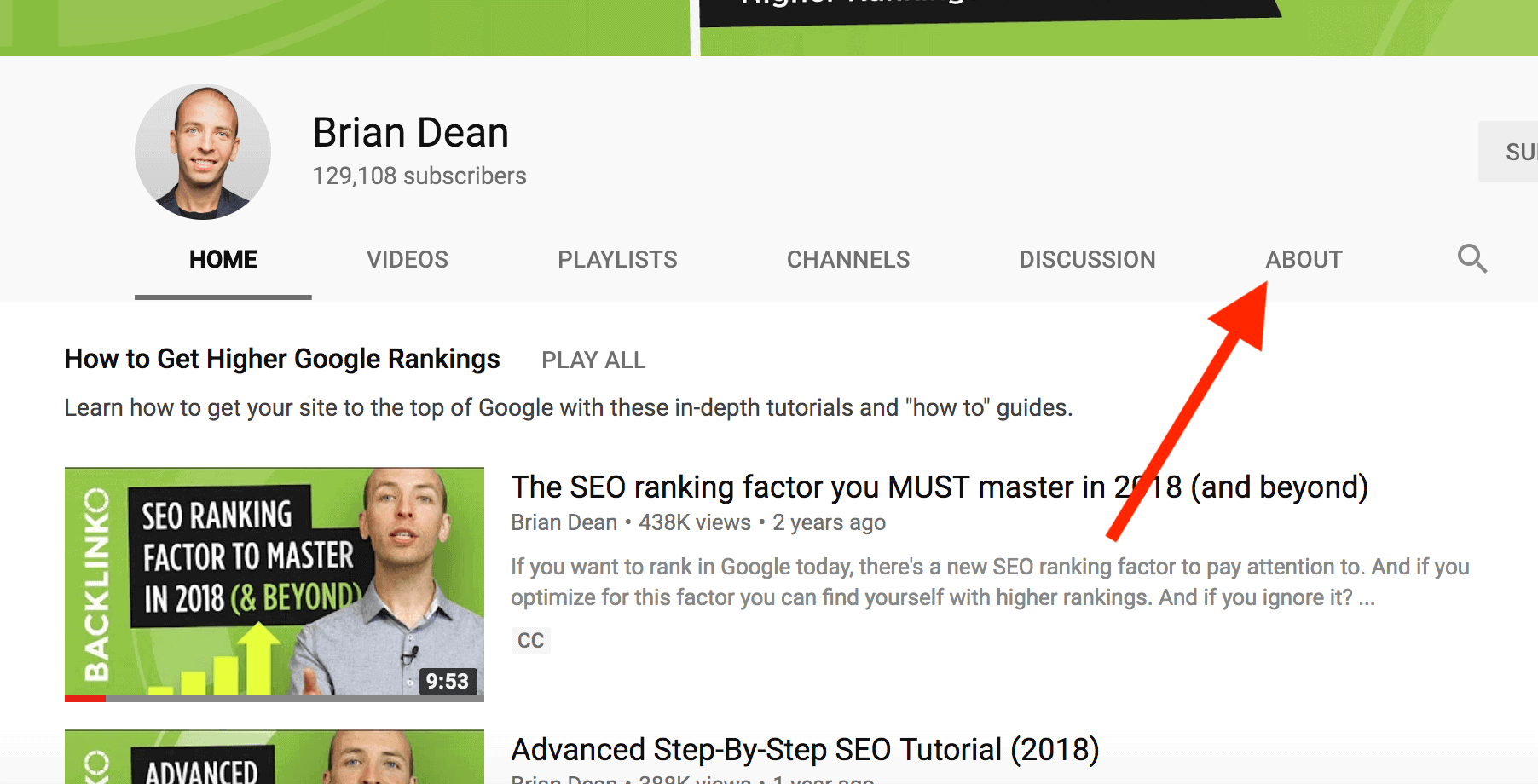
Right click and “View Page Source”:

Finally, search the page for “keywords”. This list of keywords are their Channel Keywords:

You can also use the TubeBuddy or VidIQ Chrome extensions. These extensions are helpful because you can see channel keywords without having to dig through a bunch of code:

Add Your Channel Keywords
Finally, add your Channel Keywords.
To do this, hit the “Advanced” button in the Channel section of your YouTube Studio:
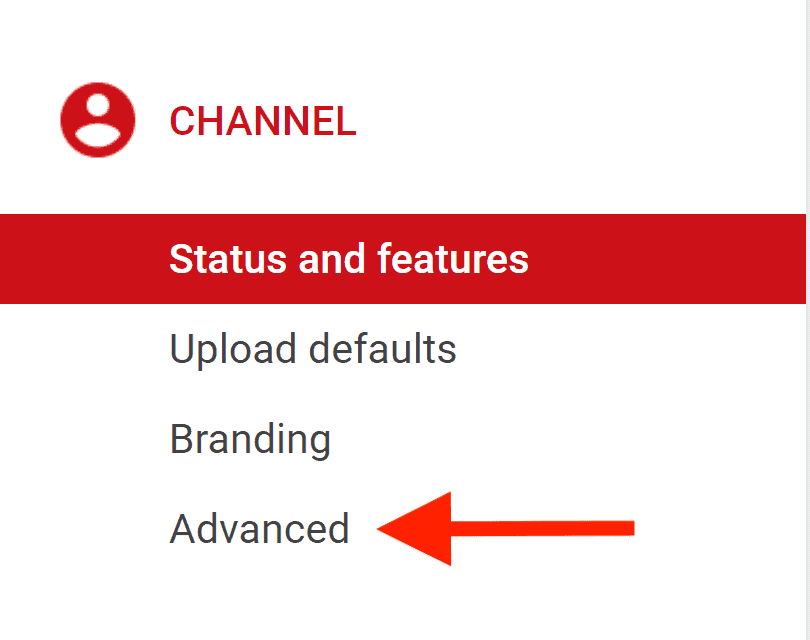
Then, copy and paste the keywords from your Google Doc into the field:

One thing to point out is that, unlike tags, you can’t separate Channel Keywords with commas. So if you have keywords with multiple words in them, make sure to put those keywords in quotes:

If you don’t, YouTube will see a tag like lasagna recipes as two tags: “lasagna” and “recipes”.

Travel Keywords: Ultimate List Of Ideas For Tour Operators
Every time your ideal customer goes online to research their next trip, they type travel keywords into the search engine. If you don’t know what these keywords are, it’s very difficult to know how to optimize your content for SEO.
SEO is the biggest driver of organic traffic to your website. When you use the right keywords in your content, you can potentially get greater visibility online.
Although the travel industry is a competitive space to be in, with basic SEO knowledge and keyword research, you can set your website up to attract more visitors.
Here, we’ll quickly walk you through how to identify your ideal keywords. Plus, we’ve included a list of general keyword ideas to point you in the direction of getting started.

How To Pinpoint Your Ideal Travel Keywords
When identifying travel keywords for your web content, there are three points to think about:
- Search Volume : The number of times users search a keyword in a month. The higher the search volume, the more web traffic you can potentially get from the keyword.
- Difficulty : Generally speaking, keywords with a higher search volume and commercial intent are more difficult to rank for. And if you’re competing against loads of high-authority websites for a specific keyword, this will also make it more challenging to rank for.
- Search inten t: When people enter keywords into the search bar, does the content in the results give them the information they are looking for? Offer the information that the person wants, and the keywords will bring you relevant traffic, not just a lot of traffic.
Our guides on how to do keyword research and local keyword research have more tips and insights on the subject.
Tools For Finding Travel Keywords
There are plenty of awesome SEO tools to help you find relevant and up-to-date keywords for your tour operator business. These tools are easy to use and offer some fantastic insights to improve your online visibility.
For a free tool, you can try Wordstream . You can check what keywords your competitors are ranking for, get ideas for the travel industry, and narrow down the results to be relevant for your state or country.

Another free option is Keywordtool.io . This generates hundreds of long-tail keywords, questions, and related prepositions based on the search term you enter. Long-tails can be useful as they often have a more focused search intent and lower difficulty.
There is also Ubersuggest , which provides a certain amount of daily free insights. Enter a domain or keyword, and the tool will bring all sorts of data, including keyword and content ideas.
For a paid keyword that gives greater insight, Ahrefs is a winner. Get a deeper look into keywords, backlinks, competitor analysis, content gaps, and more.
Travel Keyword Ideas For Your Business
To rank on the search engines, you need to start with a keyword.
We did a bit of research using the tools mentioned above to give you general ideas on what travelers are typing into search engines right now.
Keywords can be written into your website content so that you begin to rank for them in the SERPS. Include the terms naturally and optimally in your landing pages, blog posts, tour descriptions, website copy, product write-ups, social copy, adverts, and more.
Also, keep in mind that keywords are in a constant state of flux based on current market trends and conditions. For example, search volumes on travel insurance and travel restrictions are likely to currently be higher than they have ever been because of the COVID-19 pandemic.
High-Volume Travel Keywords
Here is a list of high-volume keywords related to travel in general. This is what people are searching for right now on the topic of travel and tourism.
Keywords That Travelers Might Use To Find Your Business
This list of general keywords includes a few terms that travelers might use to find you online.
Keywords To Describe Tours & Types Of Travel
These keywords are some of the popular tour and trip types that travelers are currently searching on the internet.
Final Thoughts
While these are pretty general keywords, they do at least provide a base from which you can brainstorm ideas for your travel business.
Because travel is a hot topic online, the competition on the SERPs is pretty high. Taking a data-informed approach to optimizing your content will better position your website for ranking.
Remember, ranking content on search engines is not a quick fix and doesn’t happen overnight. So, it’s a good idea to include other types of marketing in your overall strategy to grow your travel business.
To get more content like this sent directly to your inbox, sign up below for WeTravel’s newsletter.
New resources, straight to your inbox
We’re committed to your privacy. WeTravel uses the information you provide to us to contact you about our relevant content, products, and services. You may unsubscribe at any time.
About the author

Related Posts
Customer success story – happy gringo, customer success story – nepal eco adventure, customer success story – one yoga.
- AI Content Shield
- AI KW Research
- AI Assistant
- SEO Optimizer
- AI KW Clustering
- Customer reviews
- The NLO Revolution
- Press Center
- Help Center
- Content Resources
- Facebook Group
Most Popular Keywords for Travel and How to Find Them
Table of Contents
Your ideal customer always uses keywords for travel in the search engine when planning their next vacation. It’s impossible to know how to optimize your content without knowing what these keywords are.
Search engine optimization (SEO) is crucial in attracting free, organic visitors to your website. Increasing your content’s online discoverability is possible through the strategic use of keywords .
The travel market is highly competitive, but you can position your website to succeed with some groundwork in search engine optimization and keyword study.
We’ll show you the ropes of finding the right keywords instantly. In addition, we’ve provided a list of broad keyword suggestions to get you going.

Factors to Consider When Choosing Keywords for Travel
There are three considerations to make when selecting travel-related keywords for use in online copy:
1. Search Volume
Search Volume is the total number of times a keyword is entered into a search engine in a given month. The greater the volume of monthly searches for a particular keyword, the greater the potential for generating website visitors .
2. Keyword Difficulty
Ranking for terms with high search traffic and commercial intent is notoriously challenging. It will be even more difficult to achieve first-page rankings for a competitive keyword if many authoritative websites are already competing.
3. Targeted Traffic
Do the search results provide the information users seek when they type in relevant keywords? If you deliver what they’re looking for, you’ll get not just any old traffic but targeted traffic using the keywords.
Travel Keyword Research Tools
You can use fantastic SEO tools to research current and appropriate keyword phrases for your travel agency’s website.
With Wordstream, you can see how your rivals are faring in search engine results for specific phrases. It also allows you to gather inspiration for use in the travel business and refine your search to show only relevant results to your region.
Keywordtool.io is yet another no-cost alternative. Based on the search term you input, this will create hundreds of long-tail keywords, queries, and related prepositions. Because of their narrower focus and more straightforward nature, long-tails can be pretty helpful.
In addition, Ubersuggest offers free daily insights. You can enter a website or keyword and get suggestions for related keywords and content from the tool.
Ahrefs is superior to other paid keyword tools because of the depth of information it provides. Analyze your keywords, backlinks, competitors, content gaps, and more in greater detail.
How to Rank for Travel Keywords
Choosing a keyword is the first step in improving your search engine rankings .
We did some digging utilizing the methods mentioned above to offer broad insights into what vacationers are currently entering into search engines.
Writing content with keywords in mind can help your site rise in the search engine results pages (SERPS). Integrate them into your landing pages, blogs, tour descriptions, website text, product descriptions, social copy, advertisements, and more naturally and effectively.
Keep in mind that keywords are constantly changing to reflect the state of the market. For instance, the COVID-19 epidemic likely resulted in a historic surge in interest in topics like travel insurance and travel limitations.
High-Volume Keywords for Travel
Here is a list of high-volume keywords related to travel in general. These keywords often increase your visibility because they are highly ranked and have lower monthly search volume. Here we go!
- Travel agents near me
- Travel safe
- Tour operator
- Travelocity
- Online travel agency
- Travel Advisory
- Travel accessories
Country Based Travel Keywords
The next most straightforward form of country-based keyword strategy is by focusing your keyword on the individual country’s capital city. Doing this allows visitors to instantly find the information they are interested in without having to search a long list of related keywords.
Here’s our list of country-based travel keywords.
- Travel to Canada
- Hawaii travel restrictions
- Hawaii travel
- Travel state gov
- New York travel restrictions
- Multi-country European vacation packages
- Italian tour packages
- Alaska tour packages
- Grand Canyon tour packages
General Keywords for Travel
Here are some general keywords in this list that travelers might use to find you online. You can use these available words to incorporate multiple keywords and put your page or post in a better, more specific niche.
- Travel agents
- Travel companies
- Best tour companies
- Tour operators near me
- Luxury travel company
- Disney travel agents
- Travel Consultant
Popular Keywords for Tours and Travel
On the internet, travelers are searching for these popular varieties of tours and trips. These travel keywords are among the most popular and highly searched online.
- Trip packages
- Travel company tours
- Escorted tour
- Honeymoon trip
- Overseas adventure travel
- Adventure travel
- World tour package
- International tour packages
- Family tour
Travel keywords are prevalent, and you should consider your marketing strategy. You can use these considerations to help build your strategy.

Abir Ghenaiet
Abir is a data analyst and researcher. Among her interests are artificial intelligence, machine learning, and natural language processing. As a humanitarian and educator, she actively supports women in tech and promotes diversity.
Explore All Keyword Generator Articles
The best keywords for health and wellness.
By picking the best healthcare keywords, you can create content that attracts the appropriate audience to your website at the…
- Keyword Generator
The Best SEO-Friendly Keywords To Utilize For Art
Online customer acquisition can be complex, but you can improve your search results with careful planning. People use Google, Bing,…
How to Find Keywords for a Project Management Resume?
A project management resume contains the relevant keywords that help recruiters understand why you’d be a good fit. You can…
Why You Should Research Keywords For Your Blog Posts
Keyword research is a vital element of your blogging strategy. You can choose what to write about, who to target,…
The Ultimate Guide to Long-Tail Keywords
It is a good SEO strategy to concentrate on long-tail keywords. Long-tail keywords are keyphrases or keywords that are more…
Best Keywords To Use for Human Resources
Human resources keywords are more than just trendy catchphrases. They define distinct HR functions and workforce management topics. There are…

Hailey Bieber Pregnant with Justin Bieber's Baby, Six Months Along

Guess Which Dancing Celeb Shared This Summer Ready Abs Shot!

NYC Woman Strangled By Belt at Night, Knocked Out & Sexually Assaulted

Tia Mowry vs. Nicky Hilton Who'd You Rather?! (Hot Mamas In Robes Edition)

Real-Life 'Baby Reindeer' Martha Says She Sent Gadd Less Than 10 Emails
Tmz's 'pick your destination' sweepstakes, 4 weeks anywhere in the world, tmz sweepstakes win the 'pick your destination' sweepstakes ... 4 weeks, anywhere in the world.
SPONSORED BY WYNDHAM REWARDS
NO PURCHASE NECESSARY. Subject to full Official Rules. Void where prohibited.
Summer break is just around the corner, so you wouldn't be alone if you got the travel itch right about now. But don't fret, because TMZ has got you covered with our new sweepstakes!!!
All you gotta do is watch " TMZ on TV " and " TMZ Live " every weekday from now until May 31st for a chance to win our "Pick Your Destination" sweepstakes ... which includes 4 weeks at a locale of your choosing and $8,000 in travel money -- courtesy of Wyndham Rewards, the No. 1 hotel rewards program with 60,000 places to stay across the globe.
We're talking hotels, resorts, condos, castles, vacation rentals and more. And it's not just the free stay at your disposal ... as you can redeem your points to enjoy any number of tours and activities around the world -- all thanks to their relationship with Viator.
So, you better think outside the box when it comes to this sweepstakes.
Here's the 411 on how it works ... like we mentioned, you have to watch the TMZ shows, BUT you have to listen up for the secret word of the day -- which you use to enter at TMZsweepstakes.com. You can also text the secret word of the day to 55225 for your chance to win.
We've given you the tools ... it's now on you to win big!!!
The TMZ/TMZ Live "PICK YOUR DESTINATION" Sweepstakes.
NO PURCHASE OR PAYMENT NECESSARY TO ENTER OR WIN A PRIZE. A PURCHASE OR PAYMENT OF ANY KIND WILL NOT INCREASE YOUR CHANCES OF WINNING. ODDS OF WINNING DEPENDENT UPON NUMBER OF ELIGIBLE ENTRIES RECEIVED. VOID WHERE PROHIBITED BY LAW.
Open to legal residents of the 50 United States or D.C. To enter, must be at least 18 or the age of majority in your state of residence (whichever is older) at the time and date of entry. Sweepstakes starts 05/06/24 and ends 06/01/24.
One (1) National Grand Prize to be awarded valued at $18,242.20. Total approximate value of all prizes is $18,242.20 to be awarded by Sponsor. Submit the “Word of the Day” by going to: http://tmzsweepstakes.com/ or via SMS text messaging at 55225. Messaging and data rates may apply. You will receive up to 4 marketing messages per text entry to the mobile number provided at entry. Consent is not a condition of purchase or entry. Wireless carriers are not liable for delayed or undeliverable messages. Text HELP for help. Text STOP to cancel. Complete Official Rules at http://tmzsweepstakes.com/ . Sponsor: ©2024 EHM Productions, Inc.
- Share on Facebook
related articles

Santa's Finland 'Post Office' Cabin Now On Airbnb, Win Chance to Stay

TMZ's High Roller Sweepstakes, Win Luxury Package At Yaamava' Resort and Casino
Old news is old news be first.

IMAGES
VIDEO
COMMENTS
How to Do YouTube Keyword Research in 3 Easy Steps Learn the keyword approach that helped us grow our channel from 10,000 to over 200,000 monthly views in around a year. 8 Best YouTube Keyword Tools (Free and Paid)
Use keyword research tools. There are various keyword research tools available that can help you identify relevant and popular keywords for your travel niche. These tools provide insights into search volume, competition, and related keywords, allowing you to make informed decisions about which keywords to target. 2. Analyze your competition.
Good keyword research is invaluable; but when it comes to effective travel marketing, there's so much more in play. Consumers are expected to spend $381 billion on leisure travel in 2017; and yet, Google tells us that 55% of those consumers will embark on just one or two trips all year. Throw in the fact that the majority of booking is done in a two-month (December-January), then a three ...
Here is the entire Best Travel SEO Keywords list you will ever need. Download the data and find your extensive Best Travel keywords list along with the search volume and CPC data. ... best travel documentaries on youtube: 110: $1.99: 415: best travel lighted makeup mirror: 110: $1.16: 416: best budget travel system: 110: $0.27: 417: best travel ...
Simply enter the keyword or phrase you're after, and it will bring up all the most popular pages for that term. It's also not limited to keywords specific to Google, but sites like Amazon and YouTube, too. As such, you can expect to find a variety of topics and long-tail travel keyword lists using this free tool. 6.
Watch our easy tutorial on how to find keywords to use on your travel agency website and online marketing. These help improve your travel seo. Keywords are ...
TubeBuddy has a video keyword explorer in their robust suite of YouTube optimization tools. I also like the Keywords Everywhere Chrome extension, which shows you a list of keywords that any video on YouTube is ranking for. Optimize Your Videos: Once you have your keywords nailed down, make sure you include them in your video title and video ...
"88% of YouTube travel-related searches focus on destinations, attractions, points of interest or general travel ideas" But advertising needs to be profitable too and you need to see an ROI as quickly as possible. ... So when you target your YouTube Ads using keywords, YouTube is looking at words within the Title, Description and Tags that ...
Learn how to make a travel-related keywords list for your site pages, meta tags and blog posts. Single out the most searched travel keywords on Google and boost your site traffic. Ideal for beginners. ... Yahoo, and YouTube. Search suggestions are auto-complete search terms that pop up when you start to type in your search phrase into search ...
Search Popular Keywords in Your Industry. These are the most popular suggestions for Best Travel Keywords generated by WordStream's Free Keyword Tool. To get have all of these keywords sent to you, simply enter your Email address and click "Email Keywords" below. KEYWORDS (1-25 OF 100) SEARCH VOLUME. 1. cheap flights.
The keywords you most want to rank for should be included within the first 60 characters of your title. (Your title can be up to 100 characters, so the closer you put your keywords to the front of ...
In this video, I'm going to show you how to research keywords for your Travel / Travel Vlog Channel. By doing keyword research, you'll be able to target your...
Finally, add your Channel Keywords. To do this, hit the "Advanced" button in the Channel section of your YouTube Studio: Then, copy and paste the keywords from your Google Doc into the field: One thing to point out is that, unlike tags, you can't separate Channel Keywords with commas. So if you have keywords with multiple words in them ...
1. Insert travel keywords for YouTube. Unfortunately, YouTube can't watch your videos to see what they're about and how relevant they are to a viewer's search. However, you can give YouTube a hand by carefully using keywords where they matter most. There are three places to put traffic-generating keywords in your videos:
By pulling relevant keywords from YouTube's autocomplete, Keyword Tool will help generate over 750 YouTube tags for your video within seconds. Just enter the topic of a video into the search box to pull the list of keywords that can be used as tags. For your convenience, Keyword Tool separates generated keywords with commas when you copy them.
When identifying travel keywords for your web content, there are three points to think about: Search Volume: The number of times users search a keyword in a month. The higher the search volume, the more web traffic you can potentially get from the keyword. Difficulty: Generally speaking, keywords with a higher search volume and commercial ...
Get 10% off with code YOUTUBE @ https://workello.com/youtubeWe've taken 4 projects from 0 to 100,000 organics/month with ClusterAi ️ 0 to 47,000 organics/mon...
Here's how to use Google Keyword Planner. Access Google Keyword Planner by clicking on Go to Keyword Planner. Follow the prompts to set up a Google AdWords account. Don't worry, you won't have to run an advertising campaign to use the keyword tool. Select the box with Discover new keywords. Copy and paste your keywords separately into the ...
There are three considerations to make when selecting travel-related keywords for use in online copy: 1. Search Volume. Search Volume is the total number of times a keyword is entered into a search engine in a given month. The greater the volume of monthly searches for a particular keyword, the greater the potential for generating website ...
As countries start to come out of lockdown and slowly lift travel restrictions, travellers are planning future trips and gearing up for travel.We know we al...
Sweepstakes starts 05/06/24 and ends 06/01/24. One (1) National Grand Prize to be awarded valued at $18,242.20. Total approximate value of all prizes is $18,242.20 to be awarded by Sponsor. Submit ...
ট্রাভেল / ট্রাভেল ভ্লগ চ্যানেলের কিওয়ার্ড রিসার্চ 🔎 Travel / Travel Vlog Channel Keyword ResearchIn this ...